2-FOR-1 GA TICKETS WITH OUTSIDE+
Don’t miss Thundercat, Fleet Foxes, and more at the Outside Festival.
GET TICKETS
BEST WEEK EVER
Try out unlimited access with 7 days of Outside+ for free.
Start Your Free Trial
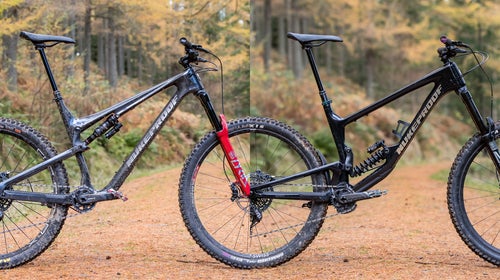

Short or Long Travel: Which Is the Best All-Around Mountain Bike?
How much slower does a modern long-travel bike climb? And what are the differences downhill?
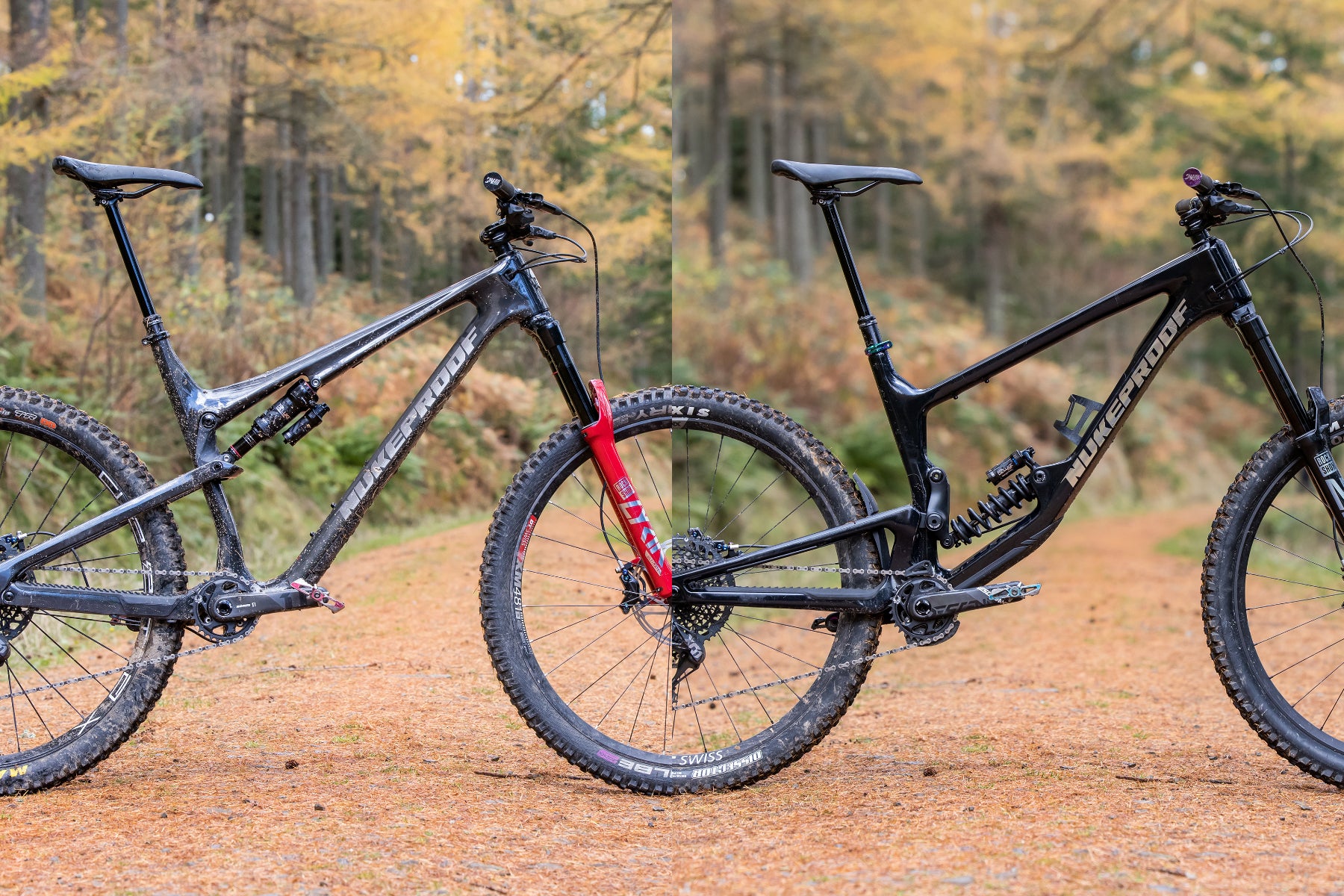
Heading out the door? Read this article on the Outside app available now on iOS devices for members! >","name":"in-content-cta","type":"link"}}'>Download the app .
If you want one bike to do everything, how much travel should it have? All bikes have to find a compromise between climbing and descending performance, and suspension travel is usually seen as a good indicator of where a bike sits on that spectrum.
But recently, short-travel trail bikes are a lot more capable, while long-travel bikes are much better at climbing. So how much slower is a modern long-travel bike uphill? And what are the differences downhill?
Caught up in all this is the question of tire choice. How much of the difference in climbing speed between an enduro bike and a trail bike comes down to the tires? Can fast-rolling tires close the gap? And can sticky tires make a short-travel bike descend as well as a long-travel one? Let’s find out.
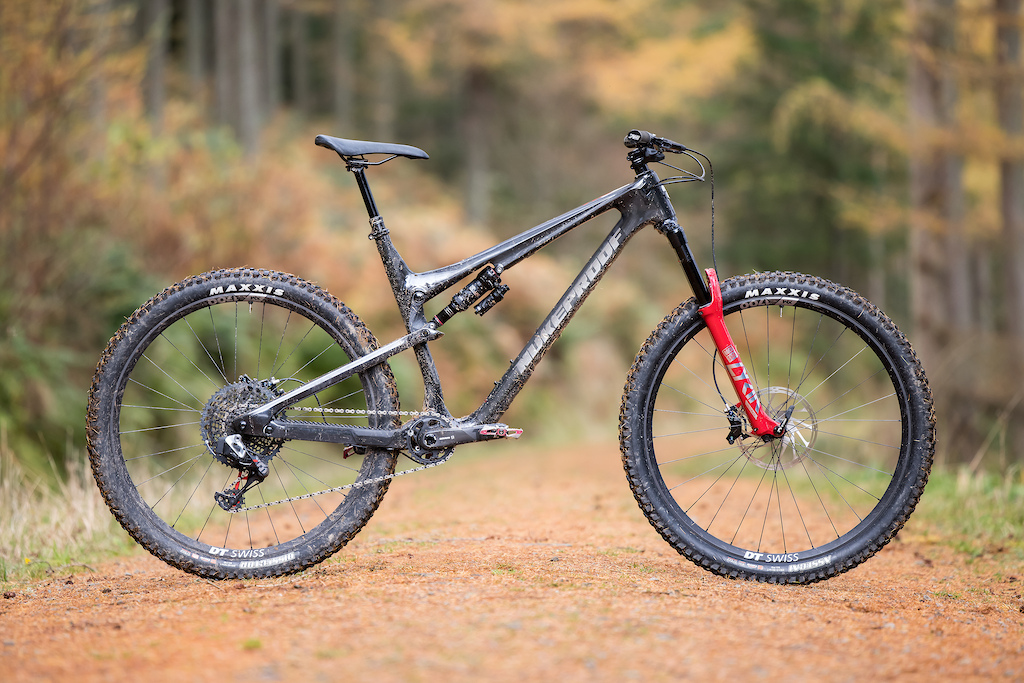
Nukeproof Reactor
• 130 / 150 mm travel • Weight as tested: 14.4 Kg / 31.7 lbs (“trail” tires, 200 mm rotors) • Size tested: XL • Price: $7,062
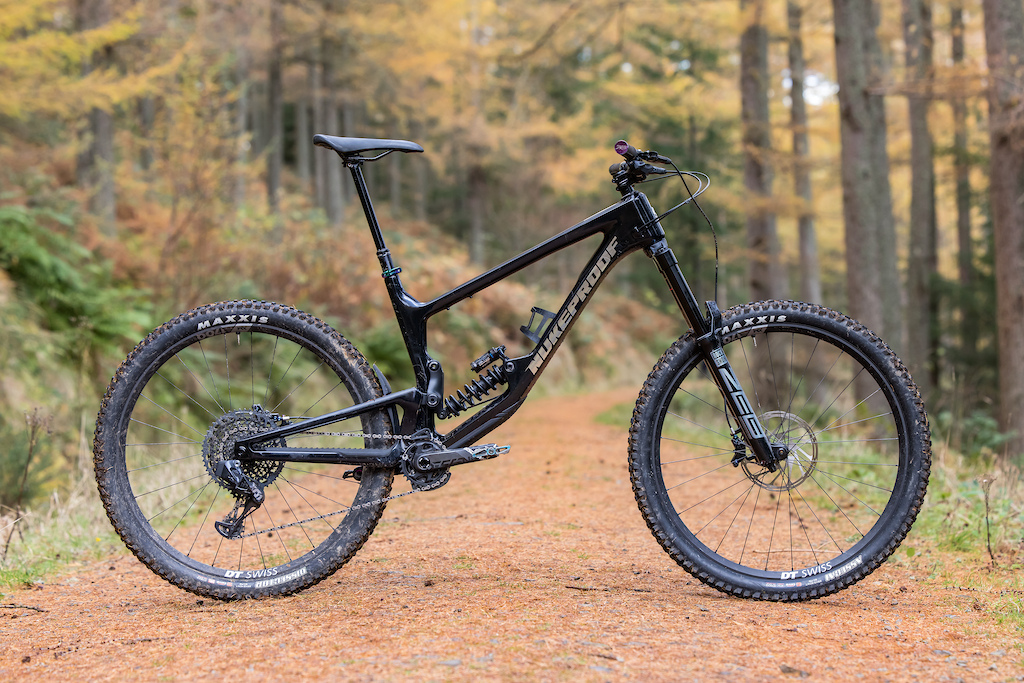
Nukeproof Giga
• 170 / 180 mm travel • Weight as tested: 15.2 Kg / 33.5 lbs (“trail” tires, air shock) • Size tested: XXL • Price: $7,415
To make things as comparable as possible, I got hold of a Nukeprof Reactor RS and a Nukeproof Giga RS. The Reactor has 130 millimeters of rear travel and 150 millimeters up front, while Giga serves up 170 millimeters (rear) and 180 millimeters (front). These models have identical brakes, drivetrains, and cockpits. With the same wheels and tires fitted, only the frame and fork are different. Both use full-carbon frames and RockShox Ultimate-level suspension. The Reactor has a Lyrik fork to the Giga’s Zeb, but the difference in chassis diameter is appropriate to the travel offered in each case.
Although the photos used here were taken with a coil shock fitted to the Giga, the testing was carried out with a RockShox Super Deluxe air shock to match the shock on the Reactor. I upgraded the rear rotor size on the Reactor to 200 millimeters so both bikes could accept the same wheels for comparative testing.
I set both bikes up with 30 percent shock sag and suspension settings as I would normally have them.
For the most part, I used the wheels that came stock on the Reactor for both bikes to remove the variable of tire choice. These tires were a Maxxis Dissector, EXO+ casing, MaxTerrra compound (rear) with a Maxxis Assegai, EXO casing, MaxxTerra compound (front). For brevity, I’ll call these the “trail” tires from now on. Fitting these tires and the air shock to the Giga dropped its weight to a respectable 15.2 kilograms – only 800 grams (1.8 pounds) more than the Reactor with the same wheels.
I also tested with a stickier pair of tires (fitted to another alloy wheelset for easier wheel swaps). These were a Maxxis Assegai in DoubleDown casing, MaxxGrip compound on the rear, with a Schwalbe Magic Mary, SuperGravity casing, Soft compound, on the front. We’ll call these the “enduro” tires. These wheels/tires weighed 600 grams more than the trail wheels/tires.
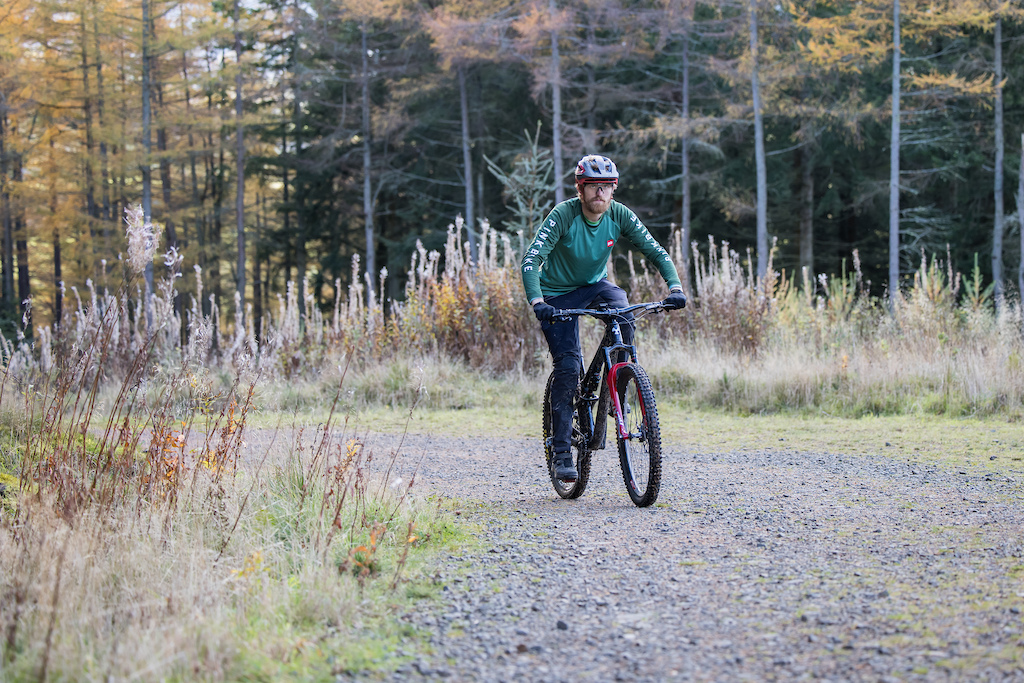
For the climbing test, I used a pair of SRM power meter pedals to control my effort, which I kept at a steady 250 watts. I rode both bikes up the same gentle and smooth fire road climb. I used a short climb so I could do five laps on each bike in quick succession and take an average. If I only did one or two longer climbs on each bike, there would be no way of knowing if any difference in times was down to the bike or just a fluke.
I did this first with the trail tires at my usual riding pressures (23 and 26 psi) then I re-tested the Reactor with the enduro tires. Here are the times:

As you might expect, the Giga was slower on average than the Reactor, but the average time was only 0.8 percent slower. Because the Reactor wasn’t consistently quicker, and the average difference between the bikes was so small, we can’t be sure from these numbers if the difference between the bikes is real or just a fluke. In science terms, the difference wasn’t statistically significant.
But even if we take the 0.8 percent difference at face value, that’s about what we’d expect from the weight difference between the two bikes alone, suggesting the travel per se (i.e. the pedaling efficiency) wasn’t having any effect.
In contrast, with the enduro tires fitted, the Reactor went 4.1 percent slower, or 3.4 percent slower than the Giga with the trail tires. In both cases, these are statistically significant differences, because the Reactor with Enduro tires was consistently slowest. To give that some context, over a half-hour climb, the enduro tires would add about one minute and fourteen seconds to the Reactor’s time. Or to go at the same pace, you’d need to produce about 260 watts instead of 250 watts; if you’re already working hard, that could be very noticeable.
The added weight of the heavier tires would only be expected to slow things down by at most 0.6 percent, so most of that difference is down to rolling resistance. This added drag will make covering ground slower on the flat and even downhills too (so long as traction and braking aren’t what’s limiting speed).
Subjectively, you can feel a little pedal bob from either bike, but there isn’t dramatically more with the Giga. The position is quite different due to the Reactor’s lower stack height and slacker seat tube angle (74.5 degrees vs. 78 degrees); this stretches out the spine which feels much less comfortable to me, especially on long climbs. Doing timed testing over technical climbs is virtually impossible because the time can vary so much from one run to the next depending on line choice, technique and luck, but when riding over bumpy terrain the Giga is noticeably smoother. The softer suspension obviously helps here but having your weight further in front of the rear axle also reduces how much your weight lifts when the rear wheel moves over a bump. Though I can’t put a number on it, I much preferred the Giga for technical climbs.

To see how they compare for descending, I chose a short local trail I know well with a good mix of roots, rocks, steep twisty sections and flat fast sections. It’s not the most technical trail in the world and it’s definitely not the roughest, but on the day of testing (which was a couple of days before taking these photographs), it was wet and slippery, making it a good challenge. To level the playing field and keep things simple, I stuck with the trail tires on the Giga and the enduro tires on the Reactor.

The Giga went first, and despite doing two laps to get up to speed on the course before getting the timer out, I shaved 2-3 seconds off my time from one run to the next. This is always a problem with timed testing. My first time on the Reactor (my fourth timed run of the day) matched the first run on the Giga. It improved from there but levelled out at one minute and sixteen seconds.
I did one more run on the Reactor with the trail tires and matched my fastest times, suggesting the stickier tires weren’t much of an advantage on this course anyway. I’m sure that on a more treacherous course—or in the hands of a rider who is better at finding the limit of grip—the enduro tires would become a significant advantage.
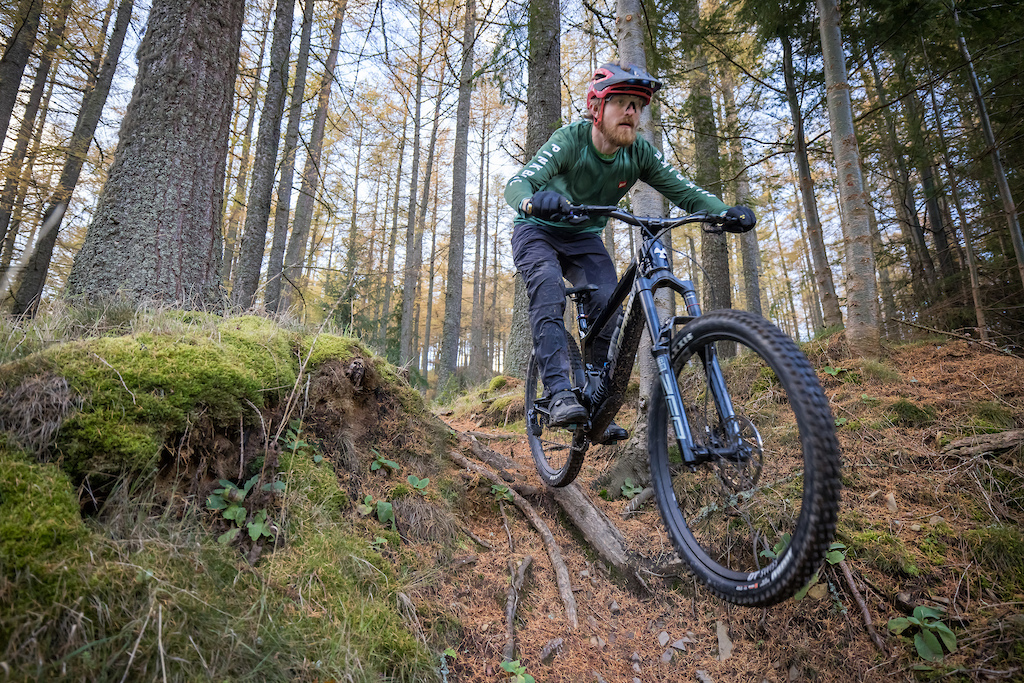
Subjectively, the enduro tires felt much more damped and surefooted and I was locking up less on the steep sections, but this didn’t seem to translate into more speed for me. Even with the sticky tires on the Reactor, the Giga felt much smoother, calmer, and more stable. The higher bar and slacker head angle combined with suspension that feels more settled “in the travel” makes going faster feel more within my comfort zone. I also felt like there was more time left on the table with the Giga, whereas the last two runs on the Reactor would be hard for me to improve on.
Because there are so many variables at play when descending, I wouldn’t read much into the times themselves. But they reveal that, although I felt closer to the edge on the Reactor, I was in fact going slower.

Closing Thoughts
The biggest takeaway for me is just how much difference tire choice makes for climbing speed. Sure, the enduro tires I tested are pretty draggy, but they’re not DH tires or mud spikes, and the trail tires (with an Assegai up front) are far from the fastest you can get. In fact, they held their own even on slippery descents.
I’m sure plenty of people don’t care about going slightly faster or feeling more comfortable on steep descents; in fact, I often hear people say they find it more fun to have a sketchier ride at slower speeds. But if that’s the case, why not fit slicker tires which will offer a real boost in climbing speed as a bonus? You could always use the lockout or run 10 percent sag if you want your enduro bike to feel sketchier! Personally, I have more fun on a long travel bike as it gives me the confidence to try new lines or ride them with more commitment.
The other surprise was that the Giga was barely slower uphill than the Reactor with the same tires, and if you want to close the efficiency gap even more you could always use the lockout.
One caveat here is that a power meter may not be the best way to measure and control effort in an efficiency test when comparing suspension efficiency. I discuss this with Mike Levy in this episode of the Pinkbike Podcast , but the bottom line is that I think the power meter method is valid for measuring efficiency when pedalling sitting down (as in this test), but it doesn’t work for out-of-the-saddle sprinting, and that’s where the extra travel is more likely to be a disadvantage.
It’s also fair to say the Reactor isn’t the fastest-climbing short-travel bike out there. But the Giga probably isn’t the most efficient among 170 millimeter+ bikes either. It’s based on a downhill bike and it’s designed to be even more gravity-focussed than Nukeproof’s Mega enduro bike. More to the point, it doesn’t have a huge amount of anti-squat , and higher anti-squat levels would probably make it climb even better. In one of Levy’s efficiency tests , the 170 millimeter-travel Santa Cruz Nomad (which has quite a lot of anti-squat) was faster than the 130 millimeter Ibis Mojo (despite having slower tires), suggesting a long-travel bike with generous anti-squat can be as just as efficient as a shorter travel one.
The bottom line is that ample suspension travel needn’t be a hindrance uphill, but grippy tires will slow you down a lot. So if you want one bike to do everything, it might make sense to pick a long-travel bike with a spare set of fast-rolling tires for mellower rides.
This article first appeared on our sister site, Pinkbike .
- Mountain Biking
Popular on Outside Online

Enjoy coverage of racing, history, food, culture, travel, and tech with access to unlimited digital content from Outside Network's iconic brands.
Healthy Living
- Clean Eating
- Vegetarian Times
- Yoga Journal
- Fly Fishing Film Tour
- National Park Trips
- Warren Miller
- Fastest Known Time
- Trail Runner
- Women's Running
- Bicycle Retailer & Industry News
- FinisherPix
- Outside Events Cycling Series
- Outside Shop
© 2024 Outside Interactive, Inc
- Help Center
- Chat with a Ride Guide
- 1-866-401-9636
- Retail Store
- Bike Services
Reset Password
We will send you an email to reset your password.
Don't have an account? Create an account
Create Account
Already have an account? Sign In
- Favorite your products & save them to your account
- Save a search & get notified when new products drop
- Be first to know about the latest events & promotions
Bike Finder
Results have arrived, mtb travel - how much mtb suspension travel do you need what does it mean.
Do you want more suspension travel or less? How do you know how much you need? Here's how to decide whether a long-travel or short-travel MTB is better for you and your trails.
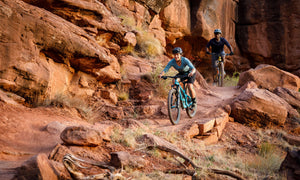
Written by: Bruce Lin
Published on: Mar 9, 2022
Posted in: MTB
You’re going to a big, important party, but you’re iffy about the dress code. Would you rather show up overdressed or underdressed?
A lot of mountain bikers face a similar dilemma, but instead of choosing the right clothes, it’s about choosing the right bike. You've probably heard certain bikes described as “too much bike” or “not enough bike.” But what does that mean?
In mountain biking, suspension travel often receives the most attention when riders are looking at bike specs. Depending on your skill, riding style, and terrain, there is likely an ideal amount of suspension travel. Other specs such as geometry , wheels , and tires matter too, but they are usually tailored to match a bike's suspension.
Most modern mountain bikes will have somewhere between 100mm and 170mm of suspension travel. This covers everything from cross-country race machines to versatile mid-travel trail bikes to hard-hitting enduro bikes . (If you want to learn more about how mountain bikes are categorized check out our Mountain Bike Buyer’s Guide .)
So what's the right amount of travel for you?
[button] SHOP MOUNTAIN BIKES [/button]
MTB travel basics: what is travel on a mountain bike?
In case you're new to riding, mountain bike suspension travel is a measurement of how much a wheel can move to absorb bumps. On the front, mountain bike travel comes from your suspension fork. At the rear, MTB travel is provided by some configuration of frame pivots that compress a rear shock.
When to choose a long-travel MTB

Long-travel bikes usually have 150-170mm of rear travel to handle tough downhill trails. Front travel often matches rear travel but sometimes can be more.
Trail and enduro bikes fall into this category. They absorb big hits and smooth out rough terrain. If you regularly ride steep or gnarly trails, a bike like this makes a lot of sense.
If you're mostly riding mellow flow trails though, a big and burly long-travel bike might be overkill. You won't be able to use all the suspension travel you paid for. The bike may feel cumbersome, maybe a bit boring, and you’ll have to expend more energy to push it around and climb uphill.
But let’s say you lack confidence on descents. A more capable enduro bike with ample suspension travel could help you enjoy riding more by increasing your confidence, comfort, and giving you more margin for error.
Some ride big and burly bikes everywhere because they're fit enough to pedal a long-travel bike up big climbs and on long rides without much trouble. For them, being overbiked isn't a handicap, and it's worth it for when the trail gets gnarly. If you care more about descending as fast as possible more than having a bike that's efficient for pedaling or climbing, long-travel bikes will cater more to your style.
[button] SHOP LONG-TRAVEL MOUNTAIN BIKES [/button]
When to choose a short-travel MTB

Short-travel bikes usually have 100-120mm of travel to maximize efficiency. In some cases, these bikes could have forks with 10-20mm more travel to make them more versatile on descents.
XC and short-travel trail bikes fall into this category. They are efficient and usually feel more agile than longer-travel bikes. If you race cross-country, do long adventure rides, or stick to mellow trails, these are the best option.
If you venture onto steep and gnarly downhill tracks with big rocks and jumps, a short-travel bike will start to feel sketchy. There’s a good chance you’ll have to ride slower and more cautiously than you would on a long-travel bike, taking easier lines and occasionally skipping tough sections.
But let’s say you dread going uphill and are constantly getting dropped by fitter riders. A bike with less travel that’s lighter and more efficient could help you go faster and expend less energy.
If you’re a skilled rider that just wants to make riding more exciting, short-travel bikes provide a lot more trail feedback and give you less room for error. You have to stay focused, be more selective about lines, and be more active with your body. For some, this can be a more enjoyable ride experience than just sitting back and letting a long-travel bike do the hard work for you.
[button] SHOP SHORT-TRAVEL MOUNTAIN BIKES [/button]
So how much suspension travel do I need?

Seth H., Merchandising Manager "I started on an XC hardtail and rode everything, even gnarly downhills on it. It had a dropper and I did just fine. I really thought it was all I would ever need. Then I went to Moab. I rode a borrowed enduro bike on The Whole Enchilada and it kind of opened my eyes. I bought a bigger bike not long after and started riding all my regular trails again. It changed how I rode.
"Personally, I really don’t mind being overbiked for most of my riding now. I ride alone a lot so I go my own pace. But I'm also decently fit and I can keep up with everyone I ride with on my bigger bike (an Ibis Ripmo). If you’re fit, I say go as big as you want."
Chad H., Warehouse Manager "I would prefer to be underbiked on the majority of trails. Being underbiked keeps the skills sharp and makes the trail an exciting challenge. I feel that being overbiked takes the challenge and excitement out of trails. It leads to laziness and dulls your skill as a rider.
"Right now for me, I believe the best bike for 85 percent of the riding I do will be a full suspension cross country bike, like the Santa Cruz Blur. I would add a dropper seatpost and Fox Step-Cast 34 120mm fork just to give it a tiny bit more capability. Or the new Trek Top Fuel, or possibly a Yeti SB100 are good options. It's what people are calling 'downcountry' now, even though I hate the term. It will be a little bit more capable than a full cross country bike, but it’ll have the same quick handling and speed. That'll be perfect for me."
What about mid-travel "quiver-killer" mountain bikes?
I always keep at least two mountain bikes in my quiver: a long-travel enduro bike and a short-travel XC bike. This lets me tackle everything from downhill bike parks to short-track XC races. But for many riders, a mid-travel trail bike is all you need.
Mid-travel bikes are a good compromise between downhill performance and pedaling/climbing efficiency. They usually have 120-140mm of travel. Many call these bikes "quiver-killers," because they can do it all (well, almost). I even spent a full season on a quiver-killer , just to see how well it worked for a wide range of riding and was pleasantly surprised by how versatile it actually was.
However, these bikes don't completely excel at anything. A longer-travel bike will be better downhill and a shorter travel bike will be more efficient for racing. Ultimately, if you can only have one bike for casual riding, or you're unsure what type of mountain bike you need for your local trails, this category is the best option.
[button] SHOP MID-TRAVEL MOUNTAIN BIKES [/button]
How to choose a mountain bike

Are your trails rough and rocky or smooth and flowy? Are they fast and steep or tight and technical? Your terrain has a big impact on bike selection. Generally, the rougher, steeper, and faster a trail is, the more travel you'll want and vice versa.
The second step is to know yourself. Your riding ambition is nearly as important as terrain. If you are a ripper who lives for downhills, you'll probably want to support yourself with more travel. But if your ride fantasy involves conquering high mountains, and exploring miles of backcountry trails, you might want to stay light and efficient with less travel.
No matter what, it's possible to have fun riding any bike, and having the ideal amount of suspension travel isn't everything. Keep in mind too that the rider is always going to make a far bigger difference than the bike. Fast descenders drop me on gnarly downhills riding XC hardtails, and fit climbers drop me on uphills riding heavy enduro machines. Good riders take what they have, and make it work.
That being said, you can always play to your strengths or weaknesses. Having a bike that enhances the parts of riding that you care about the most will make mountain biking more fun.
Are you overbiked or underbiked for your trails? Do you prefer long travel or short travel? Or do you have a bike that sits somewhere in the middle? Let us know in the comments!
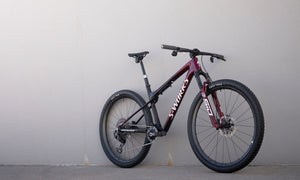
Bikes, Latest, MTB Apr 5, 2024
This Specialized S-Works Epic World Cup Is My Perfect Leadville Bike
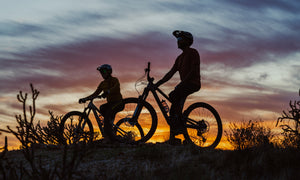
FAQs, Guides, Latest, MTB Apr 3, 2024
FAQ: Top 5 Mountain Bikes That Hold Their Value
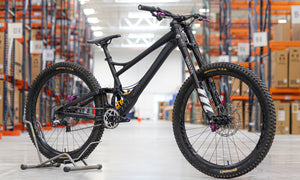
Bikes, Features, Latest, MTB Mar 15, 2024
Banshee Legend DH Bike Review: A Privateer’s Dream Bike
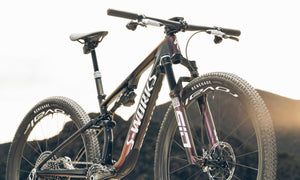
Features, Latest, MTB, Tech Mar 12, 2024
RockShox Flight Attendant: Will XC Welcome Its New Electronic Overlords?
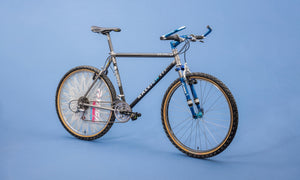
Bikes, Features, Latest, MTB, Vintage Jan 24, 2024
The Tioga Racer: 1993 Raleigh John Tomac Signature Ti/Carbon
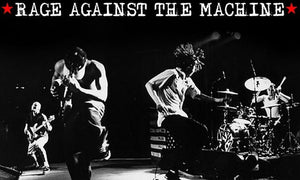
Features, Fun, MTB Jan 4, 2024
Rage Against the Machine Likes Mountain Biking
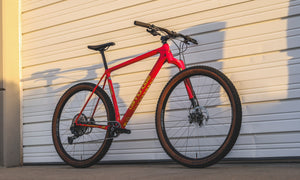
Bikes, Features, MTB Nov 29, 2023
The Cannondale F-Si Throwback Might Be the Most Beautiful XC Hardtail Ever
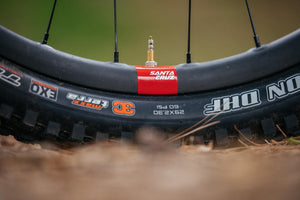
Guides, MTB, Tech Nov 28, 2023
Carbon MTB Wheels: Are They Worth It vs. Aluminum MTB Wheels
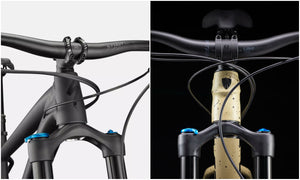
Guides, MTB Nov 14, 2023
The Best Trail Hardtail: Specialized Fuse Expert 29 vs. Trek Roscoe 9
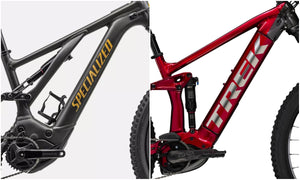
E-BikeMTB, Guides, MTB Nov 10, 2023
Budget E-MTBs: Specialized Turbo Levo Alloy vs. Trek Rail 5
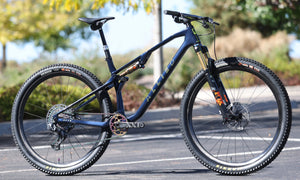
Bikes, Features, MTB Nov 9, 2023
Allied BC40: A High Caliber American-Made Downcountry Weapon
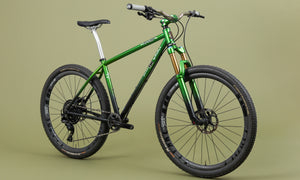
Bikes, Features, MTB Nov 1, 2023
This Fat Chance Yo Eddy Team Is a Classic 90s MTB Reborn
New arrivals.
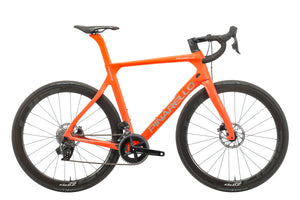
Certified Pre-Owned
Pinarello Paris Rival AXS Road Bike - 2022, 56cm
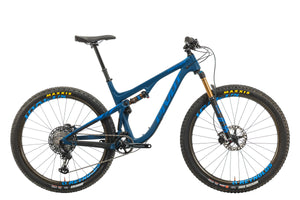
Pivot Trail 429 XT/XTR Mountain Bike - 2019, Large
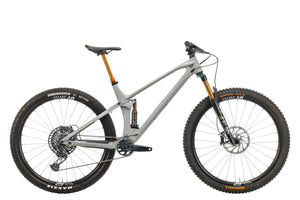
YT Izzo Mountain Bike - 2022, Large
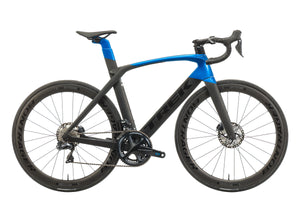
Trek Madone SL 7 Road Bike - 2021, 56cm
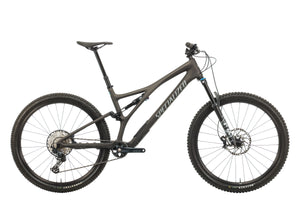
Specialized Stumpjumper Comp Mountain Bike - 2022, S6
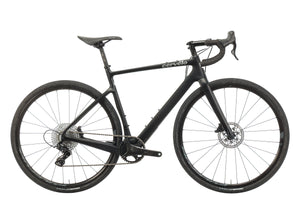
Cervélo Áspero Gravel Bike - 2022, 54cm
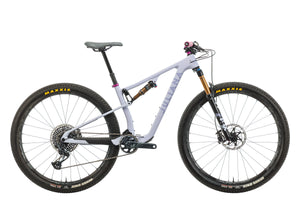
Juliana Wilder CC X01 Women's Mountain Bike - 2021, Small
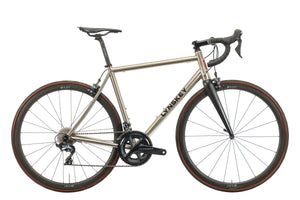
Lynskey R240 Road Bike - Med/Large
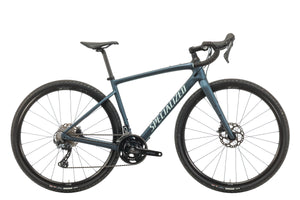
Specialized Diverge Sport Carbon Gravel Bike - 2021, 54cm
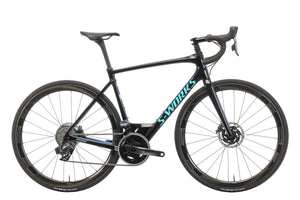
Specialized S-Works Roubaix Road Bike - 2018, 56cm
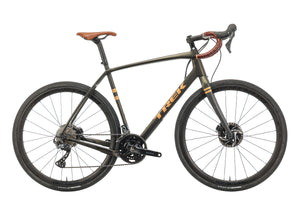
Trek Checkpoint SL 5 Gravel Bike - 2021, 58cm
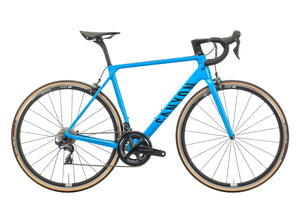
Canyon Ultimate CF SL 8.0 Road Bike - 2021, Medium

Short Travel Vs. Long Travel MTBs (Make the Right Choice!)
Many riders initially think that the more suspension travel a mountain bike has the better it is but after some research on the internet they find out that many veteran riders will choose to ride a short-travel mountain bike. Confusing right? So which one is better?
Short-travel MTBs will perform better on smoother trails and are ideal for cross-country riding while long-travel MTBs will give you the necessary traction and stability to ride technical trails filled with big rocks, roots, and big drops which makes them ideal for enduro and downhill riding.
In this article, I will tell you if more travel is better when it comes to mountain biking, we will explore the advantages of short and long-travel MTBs so by the end of the article you will know which of the two bikes is the right choice for you.
What Is Considered to Be a Short/Long-Travel MTB?
As a general rule, a short travel mountain bike is a bike with 80-120 mm rear suspension travel and a long travel MTB will have 150+ mm travel.
Mountain bikes with 130 and 140mm rear suspension travel are considered to be mid-travel.
Is More Travel Better for a Mountain Bike?

More travel isn’t always better because the suspension will add weight and will absorb some of your pedaling power.
So if you are riding soother trails a long-travel bike will feel sluggish compared with a short-travel one and more suspension will not give you any benefits if you don’t ride over big rocks and roots.
On technical trails, more suspension is always better because it can absorb the impact when you ride over big rocks, roots or when you land those big drops/jumps.
If you like to ride aggressively stiff and technical downhill trails then the more suspension travels your bike has the better, and the less chance of crushing you will have (so you can enjoy the adrenaline pump).
Advantages of Short-Travel Vs. Long-Travel MTBs
Now let’s see what are the advantages of riding a short-travel compared to a long-travel mountain bike:
As you can see the more technical the trail is the more suspension travel you need.
Where Do Short-Travel MTBs Excel?
Short-travel mountain bikes are very efficient when it comes to riding on smoother trails and on long and stiff climbs.
Now let’s examine where short-travel MTBs will perform better than long-travel ones:
- Cross-country trails: less technical, XC trails will not require much suspension travel
- Gravel roads: having more peddling power is a big plus on gravel roads
- Stiff climbs: bike weight, efficient power transmission, and geometry are the three big things that will influence the climbing capabilities of your bike,
- Rides that will combine road and trail portions: the smoother the terrain is the more efficient a short-travel MTB will be (compared to a long-travel MTB).
- Less technical and flat trails: you guessed it, no need for much suspension travel and more pedaling efficiency will improve your riding experience.
Where Do Long-Travel MTBs Excel?
Long-travel mountain bikes are unbeatable on very technical trails filled with big jumps and drops.
Nothing compares with the feeling of pushing yourself on stiff descents and smashing the trail as hard as possible, but in this case, the more suspension travel you have the more fun you will have.
But let’s see exactly where long-travel bikes excel:
- Long and stiff descents: nothing will compare with the stability and the boost in confidence that a long-travel bike offers,
- Bikepark riding: conquering the big obstacles from bike parks is a ton of fun, you will bottom out a short travel bike too often when riding on most bike parks (except the trails made for beginners),
- Big jumps and drops: landing big jumps and drops is a much smoother experience on a long-travel bike,
- Enduro: if you want to push yourself on enduro trails then you need a long travel bike, you will be heavily underbiked on a short-travel MTB,
- Downhill: if you strive to be a downhill rider then you need as much travel as possible on your mountain bike.
Is a Short or a Long-Travel MTB the Right Choice for You?
If the trails in your area aren’t too technical and you always find yourself spending much more time climbing then a short-travel mountain bike may be the best choice for you.
To make things simple, if you will ride XC trails (less technical), country roads, forest roads, or paved roads then a short-travel MTB is the right bike for you.
Now if you are an adrenaline junkie and you like to push yourself every ride on the most technical trails possible you need a long-travel bike.
If you strive to be a downhill or enduro rider then a short-travel bike is out of the question, a long-travel MTB is the best choice here by far.
To be short and precise, how technical the trail is (big rocks, roots, big drops, very stiff downhill sections, etc.) will determine the type of bike, for smoother trails a short-travel bike is the best choice while a long-travel bike is necessary for technical trails.

Isac Vasile Claudiu
I started mountain biking many years ago to improve my overall health state. After my first ride, I fell in love with the sport. Now I spend dozens of hours a week researching and training to compete in local XC and Enduro events.
- Pinkbike.com
- Register New User
- First Looks
- Friday Fails
- Community Blogs
- Fantasy League DH
- Places Directory
Short or Long-Travel: Which Is The Best All-Round MTB?
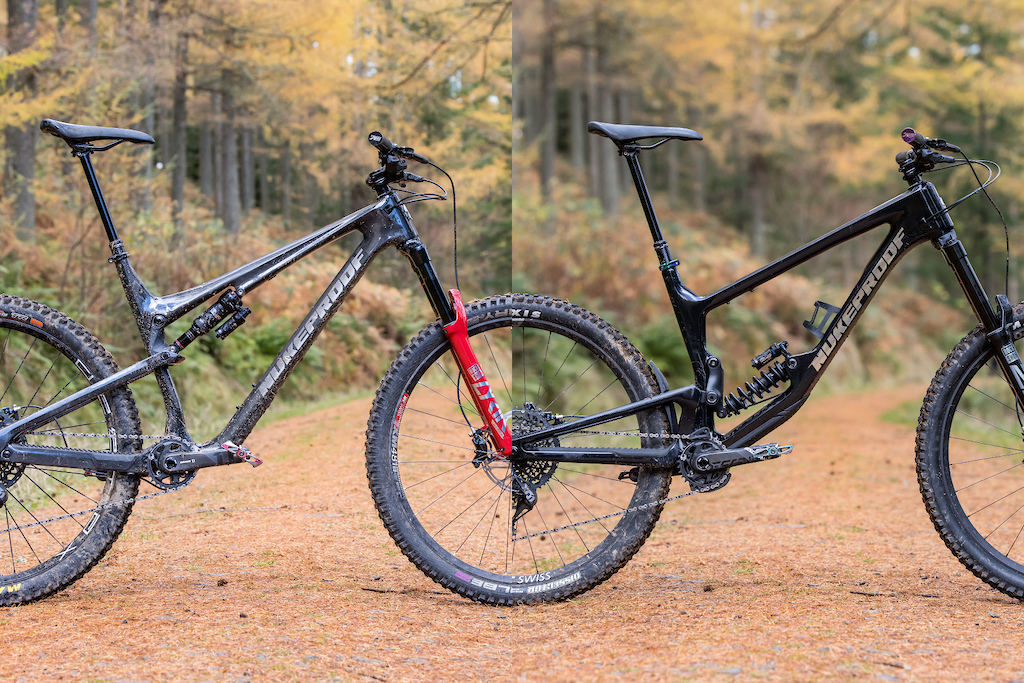
If you could only have one bike, how much rear suspension travel would it have?
- > 200 mm

Cool Features
Best trail mountain bikes 2024 – we test 11 excellent ride anywhere MTBs
Trail MTBs have become the ultimate do-everything mountain bikes, efficient on the climbs and confident on the descents. Here's our expert pick of the best around
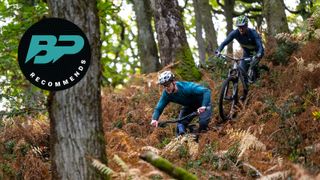
The best trail mountain bikes are designed to be all-around MTBs that can take on any trail, all day long. As trail mountain biking fills the middle ground between enduro and XC, it's the most popular riding style and virtually every brand has at least one trail bike in its range.
Trail bikes are designed to combine uphill and downhill performance. For this reason, they often have a relatively efficient pedaling platform, yet the best trail bikes will shine on the downhills too. Usually sitting somewhere between 130 and 150mm of front and rear travel, these machines can tackle everything from trail center loops to gnarly off-piste steeps.
With so many quality trail bikes here, it's very tough to pick any overall winner and the one that's best for you will depend on where and how you want to ride.
Our five star rated trail MTBs are the Specialized Stumpjumper Evo Comp and Forbidden Druid V2. The Canyon Spectral 29 CF8 and YT Jeffsy Uncaged 6 are also excellent bikes that give maximum bangs per buck, so are our best value choices.
If you're unsure if trail MTBs are you right for you, our guides to the best mountain bikes and best mountain bike brands which should help you make your decision. And if you're looking to upgrade an existing bike, you may want to have a look at our top trail tire guide and our our article on the best dropper posts . We've also got a buying advice section on what to look for in a trail bike at the bottom of this article.
The best trail bikes
Why trust BikePerfect Our cycling experts have decades of testing experience. We'll always share our unbiased opinions on bikes and gear. Find out more about how we test.
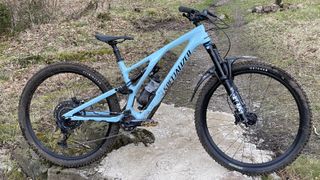
Specialized Stumpjumper Evo Comp
Our expert review:
Specifications
Reasons to buy, reasons to avoid.
Specialized offers the Stumpjumper in a huge range of spec, travel options, and in two wheel sizes, however, the Specialized Stumpjumper Evo Comp version is a happy medium between cost and components and is the Goldilocks model for us.
The Evo Comp model is made from the brand's Fact 11 carbon and features 160mm up front and 150mm at the back. The geometry is great, with a really well-centered feel descending and easy poise when climbing. Don't get us wrong, there are bikes out there that climb or descend better, but there aren't many that do both quite so well and it's finding the balance that makes the Stumpjumper such a great bike.
Not only does the Stumpjumper have impeccable ride manners, but Specialized has also packed the Stumpjumper Evo with practical features including a SWAT storage (with hydration reservoir included) and tuneable geometry. It also comes with a full SRAM GX drivetrain, complementary tire combo, and high-control brakes
Reviewer Guy Kesteven said. "It’s light and agile enough to be a joy on less techy, pedaling trails or just big days out in the hills but controlled and calm enough to really push the potential of its radical geometry options. The fact you can play around with big changes to those settings in just a few minutes between runs is a unique and invaluable gift for riders who really like to dig into their dynamics too." Read more in-depth thoughts in our review of the Specialized Stumpjumper Evo Comp .
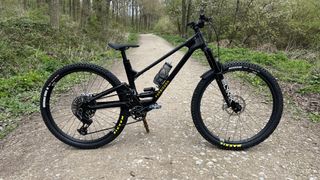
Forbidden Druid V2
While high-pivot bikes using idlers are becoming increasingly popular on downhill bikes and enduro bikes, they haven't really filtered down to the best trail bike market that much yet. Idler-equipped bikes have the advantage that the suspension and drivetrain are more disconnected giving better suspension performance, however, this can come at the cost of pedaling efficiency.
The Forbidden Druid V2's drivetrain creates less drag than it's predecessor and gives better chain security. Forbidden have also enhanced the Druid's riding character and the new incarnation combines short travel, agility and responsiveness with long travel control and confidence for a best of both worlds feel.
In testing, our tech editor, Guy, reported that the Druid V2 "charges, pops and hustles like a hard pedaling short travel bike but carries speed through jank and jolt sections like some kind of catapult. When that generates more speed than you’re expecting (which will happen a lot at first) it’ll save your stupid ass/arse and throw you straight back into the ring on your toes and ready to go. It does it without any of the old stretchy weirdness either, so not only is the overall performance better it’s easier to go harder on sooner.
Reviewer Guy Kesteven summed up the Druid V2. "With up to date, suspension flattering geometry, less drag, internal storage, smarter servicing touches and a killer spec right down to the correct tire carcasses at each end mean the Druid is truly something special. In fact, when I’m increasingly saying test bikes are sorted, capable and forgiving but in many ways increasingly similar, the Forbidden has got just enough freak to make it one of the bikes I’ve enjoyed riding most and been gutted to hand back in years."
For more, see our full Forbidden Druid V2 XO review .
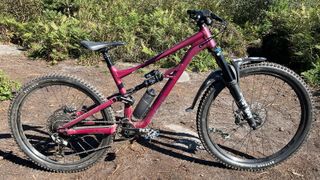
Specialized Status 140
The Specialized Status 140 proves you don’t need to spend a fortune and have more than six inches of travel to have an absolute blast.
The attack-focused geometry is designed to come in super hard. With the front wheel way out front and the back end tucked as far underneath you as possible, the basic handling dynamic is as close to one of those kids' skid steer chopper trikes as you’ll get. While there’s no shortage of stability or ‘stick it into turns way harder than seems sane’ confidence at the front, the super-short back end also helps you get the nose off the deck surprisingly easily.
The squat back end, with chunky double-sided pivots is properly stiff too, so it’s really easy to exaggerate the natural difference in turning circles and scrub rates of the front and rear wheels and kick or hip it off line like a hero. Even the RX Trail Tune on the shock is pretty tight, so you’re getting more mid-travel support to shove through berms on than typically comfort-focused Specialized FSR bikes. The short stroke fork does really well most of the time too, although more aggressive riders or slam landers will probably want to clip a couple more volume spacers under the air spring top cap to create a more progressive stroke.
It certainly doesn’t smooth out or roll through jank as well as a twin 29er like the Stumpjumper Evo. And, while the steep 76-degree seat angle helps get weight forward over the bars on climbs, the front still wanders all over the place on steep sections and the short back end doesn’t grip as well either. But overall our tester, Guy Kesteven, reported that it is, "one of the most naturally playful, anarchically agile and responsive trail/park bikes I’ve ridden at any price point. If the trails are tight and/or steep with gaps and pops rather than relentless root and rock mess, it’s seriously fast too. Everything from parts pick to stealth aesthetics feels spot on for purpose."
Find out more in our full Specialized Status 140 review .

Norco Optic C2
The Norco Optic C2 is well established as a great setup for good time riding so it’s no surprise that this bike feels sorted as soon as you grab hold of the grips. What stood out when we test-rode it is the way the Optic feels absolutely spot-on from geometry to shock tune.
As soon as we started riding, the Optic began offering rich communication between bike and rider. Norco has bumped up the high-speed compression and given the bike plenty of low-speed compression progression which gobbles up stutter bumps, roots rocks, and debris whilst race inspired shock tune will reward warp speed.
Beyond the excellent geometry and chassis dynamics, the component spec is superbly pitched to flatter the feel and capability. It’s practical, well priced and even the cheaper bike still packs all the play essentials into the package if your working with a tighter budget.
Mick Kirkman summed up the latest Optic C2 in his review. "With sublime rear suspension, the Optic is still one of the best downcountry bikes around. Less carbon parts for more dosh and a swap from sorted Schwalbe to vague Vittoria tires mean 2023’s kit list isn’t as good value as previously, but the Optic C2’s spirit still shines through."
Get full details of the Norco Optic C2 in our review.
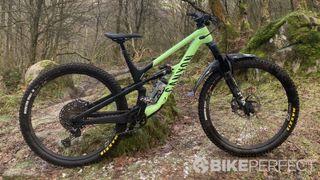
Canyon Spectral 29 CF8
Canyon's Spectral is a trail bike doing its best enduro impersonation and can continually step up to the job in hand the harder you push. This is down to the properly radical geometry which can teach any trail that normally terrified us a lesson in Canyon domination.
The offset of the bulky trail build means climbing isn't as easily earned as other trail bikes. That said if you're faced with a steep and technical crux section, the Spectral has superb traction and control that will leave sharper-feeling bikes struggling.
Once pointed down the Spectral can transition from a smooth, calm, and collected cruiser to a controlled and precise technical downhill weapon. With a characteristic that becomes more alive the harder you ride, it encourages you to seek out as much fun on the trail as possible.
Guy noted in his review that "the core of the bike is an impeccably balanced, firmly supportive, and accurate tracking technical trail and DH weapon. One that increasingly comes to life, popping, drifting, sending, and playing the harder you push it" and was so impressed he awarded the Canyon Spectral 29 CF8.0 a five-star review.

YT Jeffsy Uncaged 6
Direct sales brand, YT Industries, is much better known for its gravity bikes, specifically the YT Capra which is a common sight at enduro trail spots. The Jeffsy is one step below the Capra in the lineup with 10mm less suspension.
With 150mm of travel, the Jeffsy still ripped on the downhills during our testing and is more than capable of dabbling with everything from flowing singletracks to enduro trails. The geometry isn't as radical as you would expect from a brand like YT but we found that further helped with the Jeffsy's versatility.
Unsurprisingly, bikes this good are hard to get a hold of and with YT's stock getting snapped up quickly, bikes are frequently changing spec and out of stock.
When Rich Owen reviewed the Jeffsy he found "the ultra-responsive nature of the Uncaged 6 is hard to ignore. Everywhere I rode, the bike felt as if it was champing at the bit to go faster and hit the trails harder." For more info, check out our full review of the YT Jeffsy Uncaged 6 model.

Merida One-Forty 6000
Our techical editor, Guy, seriously rates this shorter travel 140mm travel trail bike that's already picked up a bunch of awards from other testers in the industry too. He's also rave reviewed Merida’s longer travel, higher cost One-Sixty 8000 and reckons it's one of the best enduro mountain bikes available.
Whatever size you opt for (XShort, Short, Mid, Long or XLong), they're all extremely roomy for their size with our Mid test bike measuring 480mm. That gives you plenty of room to maneuver and helps give a planted feel on the trail.
The 150mm Marzocchi Bomber Z1 fork gives a supple up front end, but in its default trim, it ramps up at the end of the stroke in a very similar way to the 143mm travel RockShox Deluxe Select+ at the rear, so any ugly landings are tidied up neatly once the shock's damper is dialed in. Flex seat stays, rather than pivots, add rear end extra flex too.
A super steep 80 degree seat angle and high level of traction from a naturally ground tracking rear end combines with a mid length stem and 65 degree head angle combo stops the bike from feeling too floppy when you’re winching the bike upwards. Add an efficient, seated pedaling feel, and you can climb up ridiculously steep, technical upslopes when you’d be walking or wanting an uplift on a lot of bikes. The only big drawback is the One-Forty's weight, which comes in at around 500g more than comparative rivals.
In his full Merida One-Forty 6000 review , Guy summed up the bike as one that "packages radical, hard riding geometry, smooth suspension plus wheel and travel change potential and a lot of neat features with super solid, good value kit. It’s on the hefty side though and the seat angle might not agree with everyone".

Mondraker Raze Carbon RR
Mondraker’s Raze is a lightweight mid-travel trail steed with a 150mm travel fork, 130mm shock, and Mondraker’s sleek aesthetic. The RR version gets full Fox Factory suspension monitored by its unique MIND telemetry system .
With a lightweight frame, a slightly compliant, conforming – rather than rigidly harsh – feel and the Raze Carbon RR feels inspiringly alive and responsive on the trail, never rabid or rowdy.
The MIND system gathers suspension and ride data and sends it to a smartphone app. This allows you to study how your suspension performed over a ride and tune it accordingly. You also get detailed telemetry on your performance which you can properly geek out on – if that's your thing.
In his review, Guy remarked, "Despite so many bikes following much of Mondraker's pioneering geometry lead, it has managed to keep its signature ride character deliciously distinctive. The light, lithe, perfectly imbalanced suspension of the Raze RR makes it a proper ‘chef’s special’ in terms of accentuating that agility and inherent ‘skill gifting’ to the maximum." For more info on this tech-packed bike, check out our full Mondraker Raze Carbon RR review .
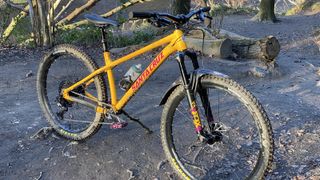
Santa Cruz Chameleon
A hardtail in best trail bike? Surely some mistake, but no. The Santa Cruz Chameleon is here very much on merit, as this eighth edition of Santa Cruz's trail-friendly hardtail is the most versatile, confident and flat-out-fun incarnation yet. It's also the most engaging and easiest-on-the-wallet entry into owning one of this premium brand's bikes.
Despite the finishing kit being a tad below par to that found on comparably priced bikes, the forgiving yet massively capable ride is so much fun that it won't ever cross your mind.
It can run both MX (mullet) or full 29er configurations which we found gave it a delightful double personality. "In MX format it’s got proper pop, precision, and powerful responsiveness for attacking the most fun trails flat out or you can choose the 29er option for the smoothest ride and tap out the tempo as far into the hills as your curiosity takes you." For our full verdict, check out our Santa Cruz Chameleon review .
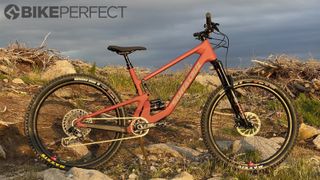
Santa Cruz 5010 CC X01 RSV
If you are looking for the ultimate fun-loving trail bike, it's hard to look past the Santa Cruz 5010. It's now running a mixed wheel combo (29 up front and 27.5 rear), rather than a straight 29er, which gives it a more playful and agile ride quality. If Strava segments are the goal of a trail ride then this is probably not the bike for you, however, if slashing corners and throwing shapes over jumps for insta-bangers is your thing then no other bike is going to come close.
However, it would be a disservice to say that the 5010 is slow. The Virtual Pivot Point (VPP) is dialed to efficiently deal with chaotic trails and on twisty tight tracks, the 5010 carries excellent speed due to its explosive cornering speed. You might need to work it a little harder on the way up, however, it's all worth it when gravity is on your side.
Mixed wheels might not suit everyone but as Guy points out, "if you’re the kind of rider who hunts for every turn to hook, loamy corner to explode sideways out of or slight lip to hip then the 5010 is an absolute riot. The fact it’s more stable and sucks up way more trouble fires you along the trail with more flow than before. It hasn't lost its killer kick and precision agility meaning you’ve got even more speed to play with, too." Check out our full review of the Santa Cruz 5010 CC X01 RSV to find out more about this mixed-wheeled shredder.
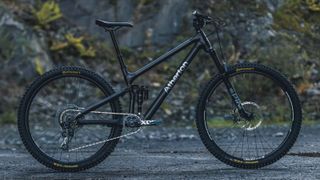
Atherton Bikes Trail AM.130
The Atherton's have evolved from a successful trio of siblings dominating World Cup downhill racing to a factory race team and innovative frame manufacturer. Atherton Bikes started with AM.200 downhill bike before extending the range with the AM.150 enduro bike and AM.130 trail bike.
All the bikes share the same carbon tubing and titanium lug manufacturing process and Dave Weagal designed DW6 suspension system that's used on the downhill bikes. Not only does that mean supple suspension performance but also a chassis strong enough to tackle Bike Park use and downhill riding, plus the AM.130 is sold with a lifetime warranty.
One of the big advantages of Atherton Bikes' manufacturing is that they are able to offer the AM.130 in 22 different sizes – which is far more than we see from any other brand. These sizes feature reach numbers between 410mm and 530mm in increments of 10mm. On top of that, all but the four smallest frame sizes are available with two different stack heights.
The unique construction method is sure to turn heads as well so if you're looking for a boutique trail bike that will stand out on the trails, then the Atherton Bikes AM.130 is an excellent choice.
For riders needing a little more capability, Atherton Bikes also offers an AM.130.X which gets a 150mm fork and a 0.5 degree slacker head angle. For more details, see our news article on the Atherton AM.130 .
How to choose the best trail bike for you
What's the best trail bike geometry.
Mountain bikes have been getting longer and lower as time has progressed. With wheel and suspension technology continually improving and brands embracing new fork offsets, trail bikes are becoming ever more capable.
Expect to see head angles between 64- and 66-degrees and seat angles between 74- and 75-degrees. With such a range of geometry figures, one trail bike could ride very differently from another, so if you are unsure what would suit you, many shops or retailers offer test rides or demo days so that you can try before you buy.
How much suspension travel should a trail bike have?
Only a few years ago, travel was a bike-defining characteristic, but that's no longer the case. We're seeing cross-country bikes with over 100mm of travel, trail bikes pushing up against 160mm of squish, and enduro bikes that bottom out at 150mm.
Trail bikes can range from 130mm of travel all the way up to about 160mm, and quite often we see forks that are about 10mm longer than rear shocks. Added travel at the front gives a bike a bit more composure on the downhills, while a shorter stroke at the rear makes it easier for designers to keep the chainstays compact leading to a lively feel on the trail.
While hardtail trail bikes are becoming less common, there are still a few around. The simplicity of the frame keeps the price down, and expect to find a 130-150mm fork and 29-inch or 27.5+ wheels and tires. If you are interested in that option, check out our best hardtail mountain bike guide.
Should I got for 29 or 27.5-inch wheels?
Over the years, the wheel size debate has been hotly contested. Trail bikes take advantage of both wheel sizes, and historically if you wanted an agile and maneuverable ride, 27.5 was your ticket, while if you were looking for rollover and speed, you'd want a 29er. However, as things have progressed, brands seem to be embracing the larger wheel size.
Because a 27.5-inch wheel with a 2.8-inch tire is roughly the same diameter as a 29er with 2.3-inch rubber, quite a lot of frames designed for bigger wheels will be compatible with both.
And if you want the best of both worlds, lots of bikes are available as a mixed-wheel mullet option, with a 29in upfront and a 27.5in wheel on the rear.
Should a trail mountain bike have an alloy or carbon frame?
Alloy frames are cheaper to produce, so it's no surprise to find them at the lower end of the pricing spectrum, while carbon dominates the upper end. There are great bikes in both materials, and ultimately your budget will determine what your new bike is made from. Some brands offer an alloy version of a frame specced with top-end components for a fraction of the cost of the carbon frame with the same build. If you are planning on upgrading parts over time go for the carbon version, if you are looking for the best performance-to-cost ratio then an alloy frame is probably the way to go.
What components should I look for?
For the most part, if you are choosing an XC bike, you will choose lightweight XC parts, and if you are going enduro, you will go full enduro. Trail bikes are a little different and really blur the lines between disciplines. Much of the component choice will be dependent on your local trails and riding style.
If you're looking to try out the odd bit of enduro riding, there is no harm in beefing up components like wheels, tires, or brakes to handle the extra stresses. However, if your trails are tamer or if cruising and flow are more your style, choosing lighter-weight parts would be a good way to go.
How we test trail bikes
Given that most trail bikes are designed for a fairly wide range of conditions that is exactly what we test them in – everything from fun trail center loops to gnarly, natural off-piste descents and everything in between. We also like to push the bikes beyond their designed use to see how they perform – as that is what you may end up doing out in the real world. While this is somewhat dependant on the season, we also aim to ride the bikes as many different riding conditions as possible to see how they perform in sucky mud and over slippery roots as well as on dusty, fast running hardpack. This also helps to give us an understanding of how the bikes will stand up to hard use and if it will still function if parts of it are clogged up with mud or affected by other trail debris.
Meet the testers
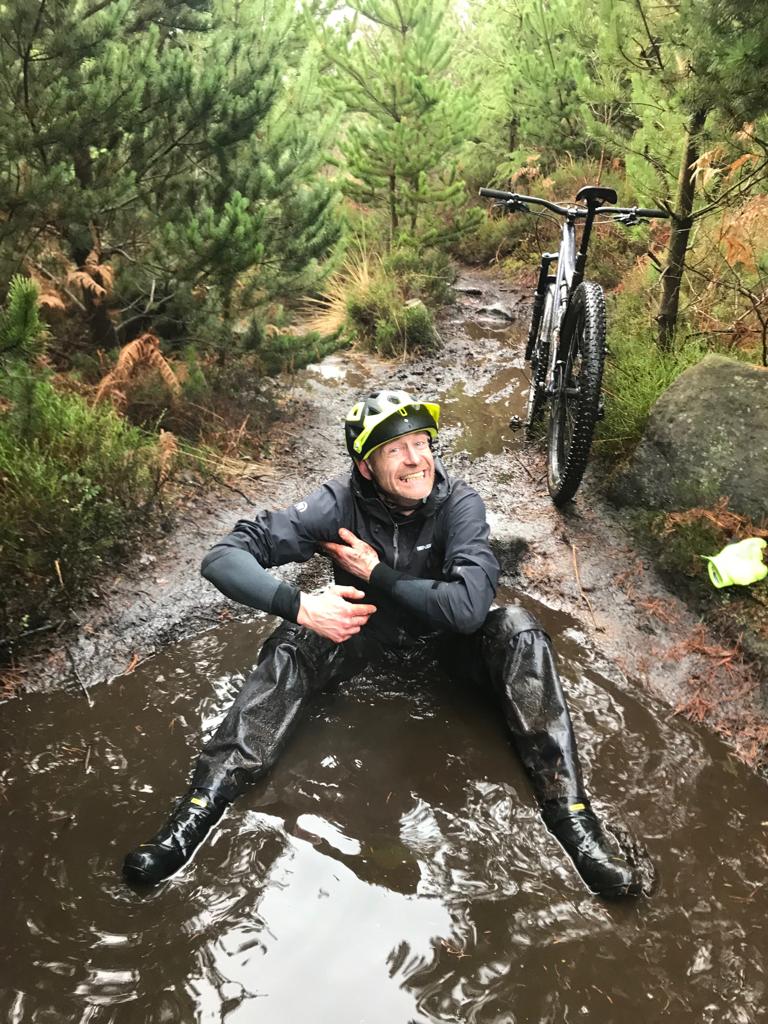
Guy's been testing and writing about mountain bikes since the 90s, he’s written several million words about several thousand test bikes and a ridiculous amount of riding gear. We are willing to bet that there aren't many trail bikes Guy hasn't ridden over the last couple of decades.

Rich has been riding mountain bikes since the early nineties and professionally testing bikes and kit for over a decade. While he has ridden mountain bikes of every kind, Rich is definitely a trail bike rider at heart and loves finding flow on more technical lines.
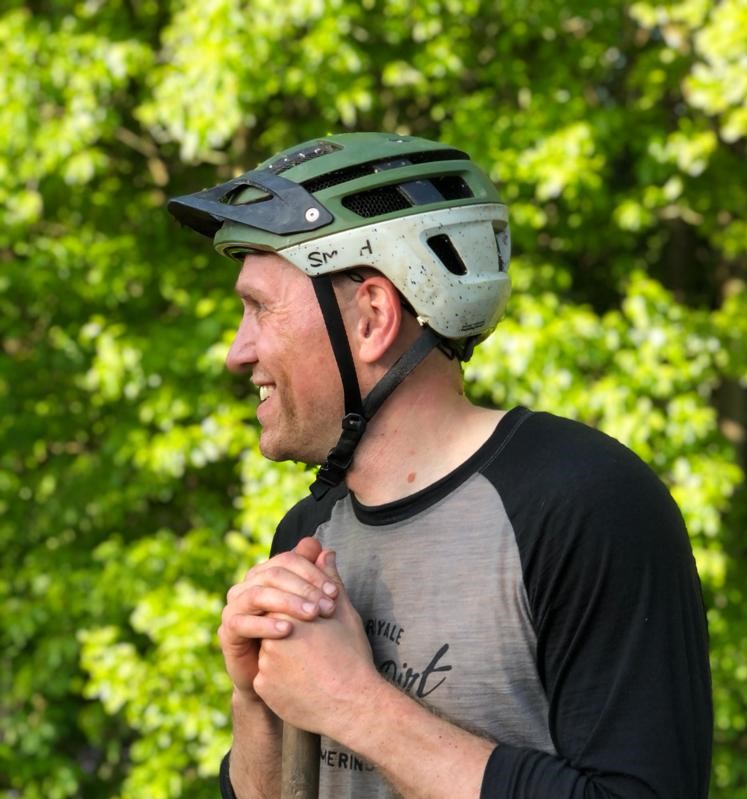
An ex-elite downhill racer, Mick's been mucking about and occasionally racing mountain bikes for over twenty years. Nowadays, he's mostly riding enduro-style terrain on conventional and electric bikes.

Rich has been riding mountain bikes for over 30 years and mostly likes hitting flowy yet technical trails that point downhill. A jack of many trades, he has competed in cross-country, enduro and long distance MTB races. A resident of North Devon, Rich can mostly be found pedaling furiously around his local trails, or slightly further afield in the Quantocks, the Mendips or Exmoor.
Current rides: Merida One-Forty 6000, Banshee Paradox
Height : 175cm
Weight : 68kg
- Guy Kesteven Technical-Editor-at-Large
- Colin Levitch Freelance writer
- Mick Kirkman Freelance writer
Best mountain bike clipless pedals 2024 – the top-rated clipless MTB pedals for XC, trail and gravity riding
Best MTB saddles for comfort 2024 – 6 top-rated butt-pleasing perches for mountain biking and off-road cycling
Off-road cycling top stories – Three new e-MTBs, a ton of new suspension including Fox's ultra-bling forks, fresh gravel and MTB bikes, plus much more
Most Popular

- Biking Gear Reviews
- Best Mountain Bike Reviews
10 Best Mountain Bikes

Our Top Picks

We are constantly searching for the latest and greatest mountain bike gear. When we see compelling new MTB models, we get our hands on them and ride them to their limits. Our testers eat, sleep, and breathe mountain biking and work as hard as possible to scrutinize every minute detail of each model we test. Bike park laps, all-day epics, 5000-foot climbs, and descents, we put these bikes through the wringer. Whether you're looking for a trail bike, e-MTB, hardtail, or budget-friendly model, we have compiled this list of the best options in each category. In other words, these are the best of the best.
We've tested other gear, like the best bike helmets , best mountain bike shoes , the best bike racks , and best hitch racks . You can learn more about our favorite bike components in our bike gear review.
Best Overall Trail Bike
Ibis ripmo v2 xt.
The Ibis Ripmo V2 XT impressed our testers as the best all-around trail bike we've ever tested. With updated geometry, it's slacker and longer than before, and the suspension kinematics were adjusted to make it more progressive at the end of the stroke. This long-legged 29er was already a confident and capable descender, but now it feels even more composed in gnarly terrain and stable at speed with improved big-hit performance. Short chainstays keep the rear end sporty, and it's just as lively and energetic with responsive and precise handling. The V2 maintains its incredible climbing abilities with its efficient DW-Link suspension platform, steep seat tube angle, and direct power transfer. Superlatives like "quiver killer" come to mind with the Ripmo, as this is one bike that can do it and do it all well.
The Ripmo V2 is an excellent aggressive trail bike with a fantastic combination of uphill and downhill performance. This bike is ideal for the rider seeking a bike that climbs well without sacrificing performance on the way back down. This bike is supremely versatile, and we'd recommend it to just about anyone. Riders who can't quite swing the price should consider another contender like the more affordable Polygon Siskiu T8 .
Read more: Ibis Ripmo V2 XT review
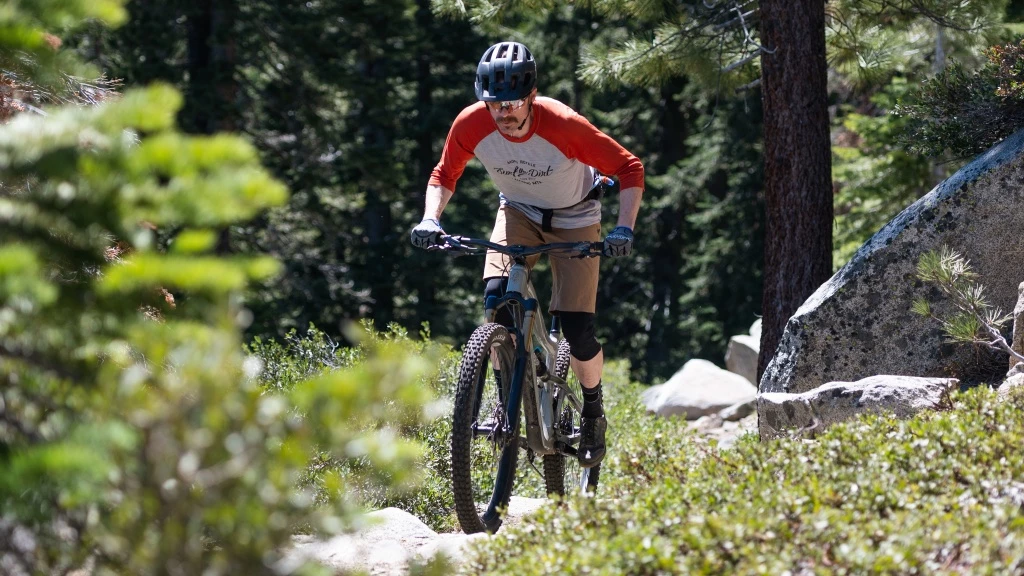
Best Mid-Travel Trail Bike
Revel rascal xo transmission.
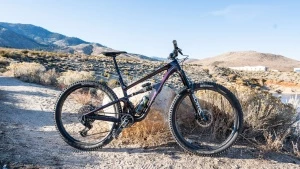
The Revel Rascal XO Transmission is a wildly capable bike that employs the Canfield Brothers Formula suspension and some cutting-edge thermoset carbon technology. The geometry gives this bike a playful disposition, while its suspension allows you to really push the limits of a 130mm travel bike. The bike's numbers are modern enough to make it versatile but not so modern that it loses its poppy, agile feel. Traction is a high point on this bike, whether clawing up a rooty section or braking through the chunder. Seasoned riders will be especially impressed with how isolated the suspension is from rider input. The SRAM XO Transmission build with Revel RW30 Carbon wheels left little to be desired. The build includes top-of-the-line suspension from RockShox and a drivetrain built for abuse.
The bike lacks frame storage and adjustable geometry, which are on many riders' shortlists these days. We appreciate that adjustable geometry enhances a bike's versatility, but we'd never complain that the Rascal isn't versatile. In fact, the bike seemed to excel in trails that were "a bit too much" for its geometry and travel, but the Rascal never feels like too much bike, even on mellow XC trails. If you're a performance-oriented rider seeking a bike without compromise, you'll love the new Rascal; Revel even guarantees it!
Read more: Revel Rascal XO Transmission review
Best Aggressive Trail Bike
Specialized stumpjumper evo comp.
Specialized knocked it out of the park with the new Stumpjumper EVO . This 150mm travel 29er comes with a 160mm fork and is one of the hardest-charging trail bikes we've tested. This bike descends with authority; the revised FSR suspension platform is near perfection. This puppy eats everything in its path. Point it uphill, and it climbs pretty darn well with a relatively supportive pedaling platform and a nice steep seat tube angle. One of the most interesting aspects of this redesigned bike is its uniquely adjustable geometry. The head tube angle can quickly and easily be adjusted between 63.5 and 65.5 degrees in 1-degree increments, and the bottom bracket can be raised or lowered by 7mm. This adjustability gives riders six geometry settings to suit their preferences, riding style, or terrain. Set it up steep and high for everyday trail riding, switch it to low and slack for running laps at the bike park; the choice is yours. Specialized also continues to impress with their attention to detail and on-bike storage. The SWAT storage compartment now features a 20oz water bladder and a zippered tool sleeve that fits inside the frame, so you can forgo wearing a pack without going thirsty.
Given this bike's longer travel numbers and aggressive intentions, it can feel a bit bulky and bland on mellower trails. The Comp build we tested is nicely equipped, but it's moderately heavy compared to the more expensive build options and competition. That said, we feel the Specialized Stumpjumper EVO is a fantastic option for the aggressive rider seeking the versatility that this highly adjustable bike provides. Folks who want something lighter and more well-rounded may find the Ripley GX to be a better fit.
Read more: Specialized Stumpjumper EVO Comp review

Best Technical Trail Bike
Yeti sb140 lr t2 turq.
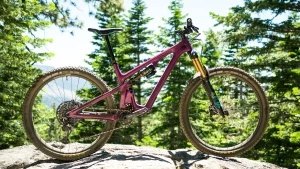
The Yeti SB 140 is a top-notch mid-travel trail bike that can handle any trail, any time. This 140mm 29er delivers exceptional ride quality and performance beyond what its geometry table might suggest. Whether tackling steep climbs, fast-rolling flow trails, high alpine epics, or hitting the jump line, the Yeti has you covered. It offers excellent climbing traction and ideal positioning while the rear wheel tracks smoothly through technical terrain and rough climbs. When it's time to point downhill, the Yeti is equally impressive, maintaining incredible small bump sensitivity throughout its travel. The bike feels well-balanced and precise; it inspires confidence in all but the steepest terrain. Still a shredder, this bike feels more refined; it's a connoisseur bike.
If you're looking for a new trail bike and want frame storage or adjustable geometry, the SB140 may not make your shortlist. Similarly, if you prefer more aggressive trail bikes, keep shopping those slacker bikes. The Yeti offers agility and athleticism with less reliance on mass and travel. Its exceptional traction allows you to push the limits of cornering and braking, making it an ideal companion for tackling most of the singletrack terrain in North America. Get your hands on the Yeti SB140 and enjoy the trails. Or check out the Ibis Ripmo V2 XT if you want a more aggressive model.
Read more: Yeti SB140 LR T2 TURQ review
Best Short-Travel Trail Bike
Ibis ripley gx eagle.
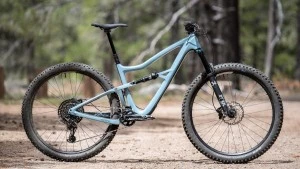
Ibis completely overhauled their flagship 29-inch wheeled trail bike for 2021, the Ripley GX . The previous version was our favorite short travel model for its energetic ride and unrivaled playfulness. The newest Ripley maintains most of that playful demeanor but is now a much more well-rounded ride with enhanced downhill capabilities and far greater stability at speed. Thank the Ripmo -inspired frame design with increased reach and wheelbase measurements, a slacker 66.5-degree head tube angle, and a steeper 76.2-degree seat tube angle. The Ripley still encourages pops and trailside hits but no longer has a speed limit. It's also far more confidence-inspiring in steep and rough terrain, though it remains limited by its modest travel numbers.
The Ripley is a very sensible trail bike for most of the riding population. This lightweight ride is equally talented on the climbs as on the descents. It has unmatched versatility and is the best all-around short-travel bike we've tested. It is a top choice for long-distance bike rides , where you need just the right balance of comfort and efficiency. If you're shopping for technical prowess over length of travel, we dig how the Yeti SB 140 handles terrain with precision.
Read more: Ibis Ripley GX review
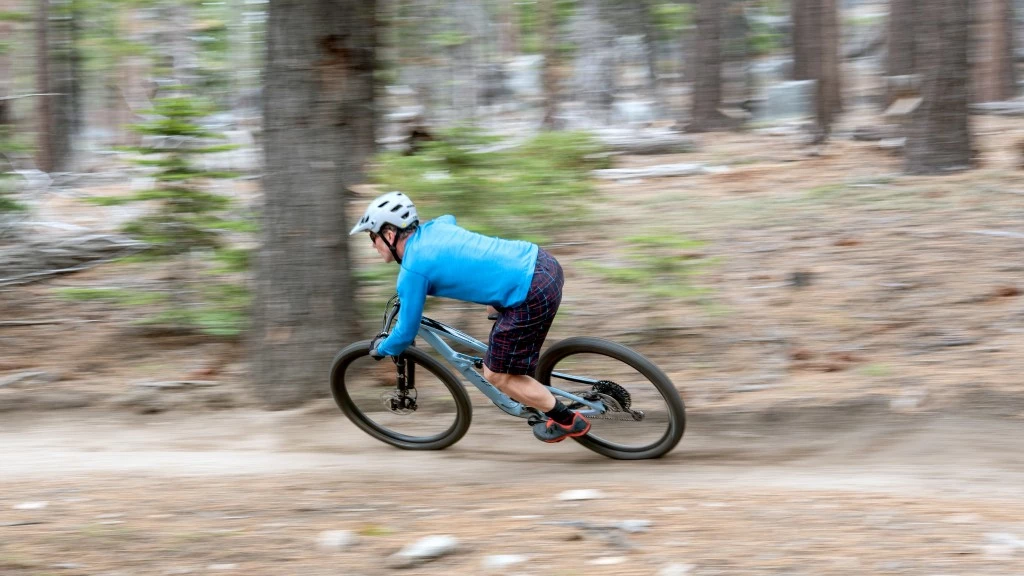
Best Trail Bike Under $3000
Polygon siskiu t8.

The Polygon Siskiu T8 is easily the best bike we've tested in this price bracket. This affordable mid-travel trail bike rolls on 29-inch wheels and has 135mm of rear-wheel travel paired with a 140mm fork. The Siskiu's geometry ticks all modern boxes, giving this bike a nicely well-rounded and versatile performance. It's a relatively easy-going ride that's easy to get along with and suitable for a wide range of ability levels. Novice riders and seasoned experts alike can jump on this bike and have a great time. It's agile with responsive handling, yet stable at speed and confidence-inspiring on the descents. We found the Siskiu to be a comfortable and efficient climber suitable for any ride. Perhaps its most impressive aspect is its unique build. This bike is very well equipped for the price, enhancing its performance on both the climbs and descents.
Considering the reasonable asking price, our complaints about the Siskiu T8 are few. Our biggest gripes with this bike are the touchpoints, the grips, and the saddle. The grips are thin and quite firm, and we'd likely replace them for something a bit more comfortable right away. Likewise, the saddle has a funky shape with a pointed tail that could catch on shorts or poke you in the pelvis on a steep descent. Beyond that, there's little not to like about this impressively well-rounded and affordable mid-travel trail bike. Another budget option to take a gander at is the Norco Fluid FS 4 . It's slightly less expensive, bombs it on the downhill, and feels comfortable on the climbs.
Read more: Polygon Siskiu T8 review

Best Budget Mountain Bike
Norco fluid fs 4.
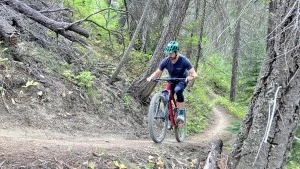
The Norco Fluid FS 4 is the best budget mountain bike we have ridden. This bike is so competent that we quickly forgot that we were riding a "budget bike." Whether tearing down a high-speed flow trail or charging down a chunky trail, the Fluid was very composed and was as fun as a barrel of monkeys. Pair this brilliant on-trail performance with a stellar build kit that features a wide-range cassette and long-travel dropper post, and it was a very easy choice for Best Budget Mountain Bike.
Our main complaints with the Fluid are minor. For instance, this bike is quite portly. Our extra large test bike hit the scale at over 36 pounds. We should also note that we generally test large frames, so comparing the weight of this extra large frame isn't exactly apples-to-apples. We found the climbing performance comfortable, but we would also have loved to see a climb switch on the shock for use on fire roads or smooth double tracks. We think budget conscious shoppers should also check out the Polygon Siskiu T8 . It performs well on the descents as well as the climbs, especially given the price.
Read more: Norco Fluid FS 4 review
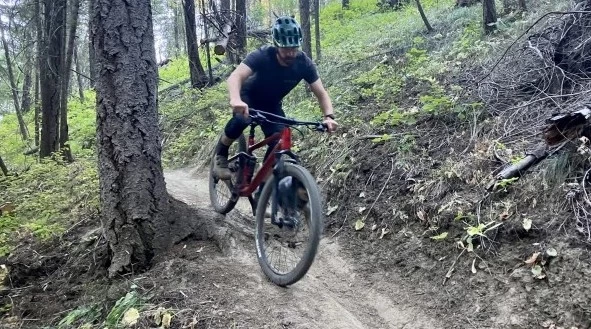
Best Hardtail Trail Bike
Specialized fuse expert 29.
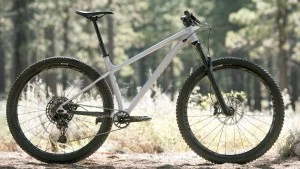
The Specialized Fuse Expert 29 has enjoyed a long run as our favorite hardtail. A couple of years back, the Fuse got a total redesign with updated geometry and the option for 29-inch wheels. Its incredibly well-rounded performance impressed every tester. It has a modern and progressive geometry that isn't over the top. It's stable at speed and confidence-inspiring in corners, in the air, and while charging down moderately chunky rock gardens. It's far from an XC race bike on the climbs, but it's got a comfortable seated pedaling position, a 12-speed drivetrain, and a grippy 2.6" rear tire that provides excellent traction.
At nearly 30 lbs for the large size we tested, the Fuse 29 is not lightweight. There are certainly lighter, more efficient, and even harder charging options. However, none of the other bikes we tested can match the well-rounded, versatile, and outrageously fun performance of the new Fuse Expert 29. That said, you should check out the aggressive Ibis Ripmo V2 XT if you want an efficient climber.
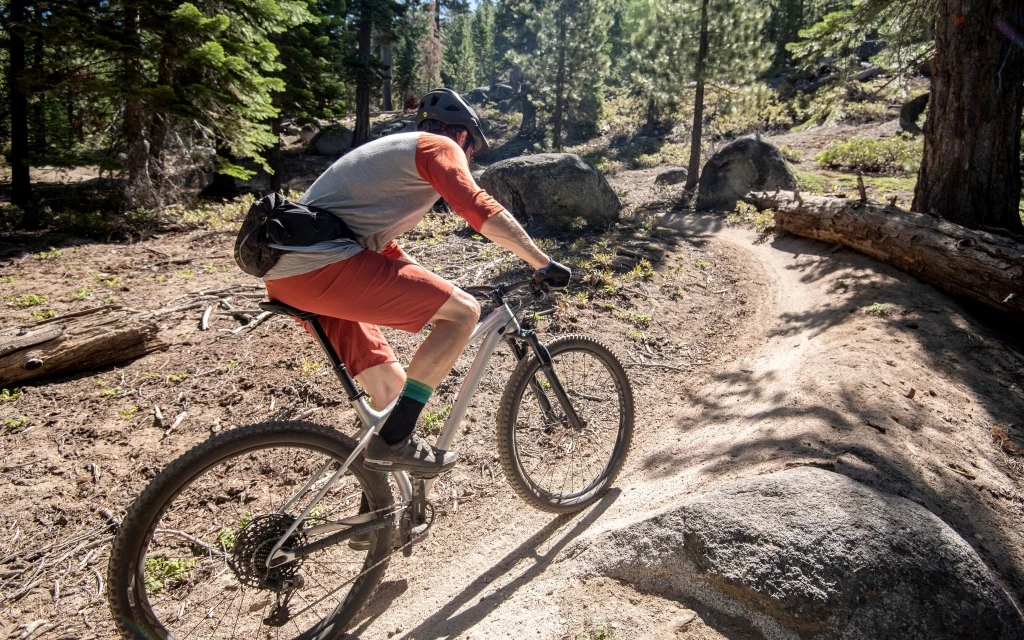
Best Electric Mountain Bike
Specialized turbo levo comp.
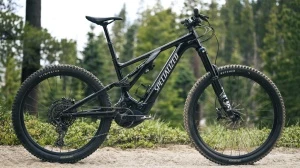
Following the updates to the Stumpjumper EVO , the Turbo Levo Comp Alloy received an overhaul for the 2022 model year. Much like the unpowered Stumpjumper, Specialized gave the Levo a highly adjustable geometry that allows the rider to significantly alter its character to suit their riding style, terrain, and preferences. With six distinct geometry settings to choose from, you can set it up as a more nimble trail bike, an aggressive gravity-oriented slayer, and everything in between. This unprecedented level of adjustability truly expands this bike's versatility and puts it in a class of its own. It boasts 150mm of rear wheel travel with a 160mm fork and mixed wheel sizes for a confident front end and maneuverability out back. Specialized's Turbo Full Power 2.2 motor is quite powerful, with 90Nm of torque and up to 565 peak watts of output, with three customizable levels of pedaling support. 700Wh of battery is housed in the frame's downtube, providing an excellent distance range, and the whole package has been refined and well-integrated with balanced weight distribution for a natural ride feel.
The Comp Alloy is one of the least expensive builds of the Turbo Levo offered, and it comes with a functional build, but there are a couple of weak points. The SRAM Code R brakes are far from our favorite, and the GRID TRAIL casing tires aren't as tough as we'd like for the weight of this hard-charging bike. Additionally, the top tube integrated TCU display is quite basic, although the higher-end models now come with a more advanced system. Finally, 700Wh is a lot of battery capacity, but other brands recently surpassed Specialized in the range wars. Regardless, we feel the Turbo Levo is one of the best and most well-rounded electric mountain bikes you can buy. Its adjustable geometry takes its versatility to another level. If you're in it for the long haul, the 900Wh battery of the Canyon Spectral:ON CF 8 may make it a more suitable pick.
Read more: Specialized Turbo Levo Comp review
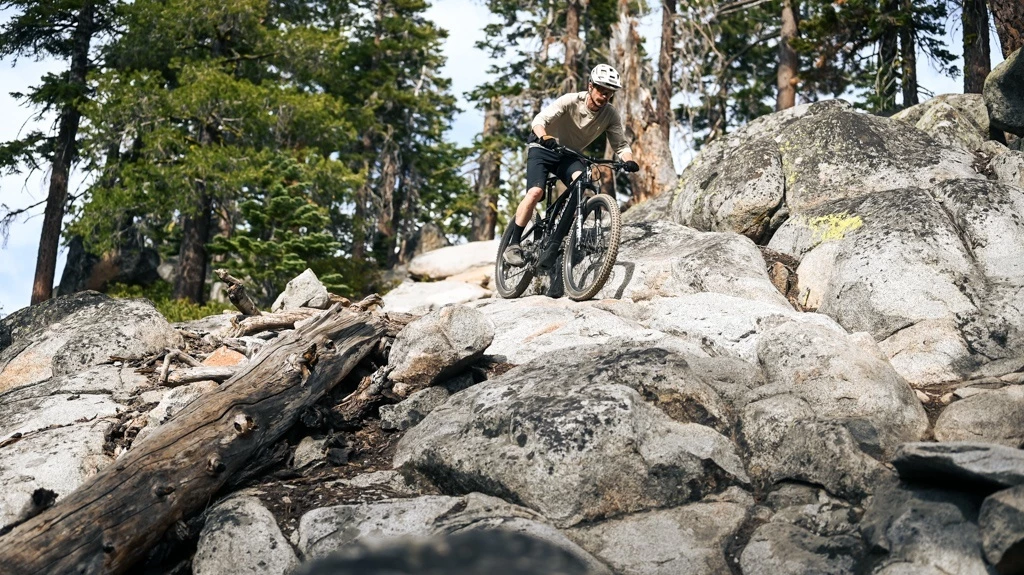
Best Electric Mountain Bike for Range
Canyon spectral:on cf 8.
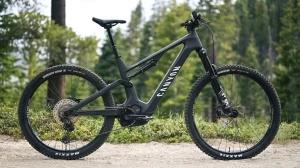
Canyon recently updated their Spectral:ON models, and the Canyon Spectral:ON CF 8 is a versatile trail e-MTB that also happens to be one of the best values on the market. This carbon-framed bike sits atop mixed wheels (29-inch front and 27.5-inch rear), has 150/155mm of front/rear travel, and contemporary geometry that perfectly suits its trail intentions. Despite its 50+ pound weight, it handles well at varying speeds and terrain, with an excellent blend of agility, stability, and composure in all situations. The ever-popular Shimano EP8 motor provides up to 85Nm of torque with three customizable support settings to dial in for your needs. It also comes with a massive 900 Wh battery, providing the longest range of any electric mountain bike we've tested. Canyon's consumer-direct sales model also means this bike comes with an excellent build for the price (though it's still triple the cost of the best electric bikes for commuting). While no drop in the bucket, the Spectral:ON CF 8 is a fantastic value. But if you're already throwing down the big bucks, you should also consider the Turbo Levo Comp Alloy before making your selection. The powerful motor and adjustable geometry are just some of the features that make this eBike worth the investment.
Read more: Canyon Spectral:ON CF 8 review
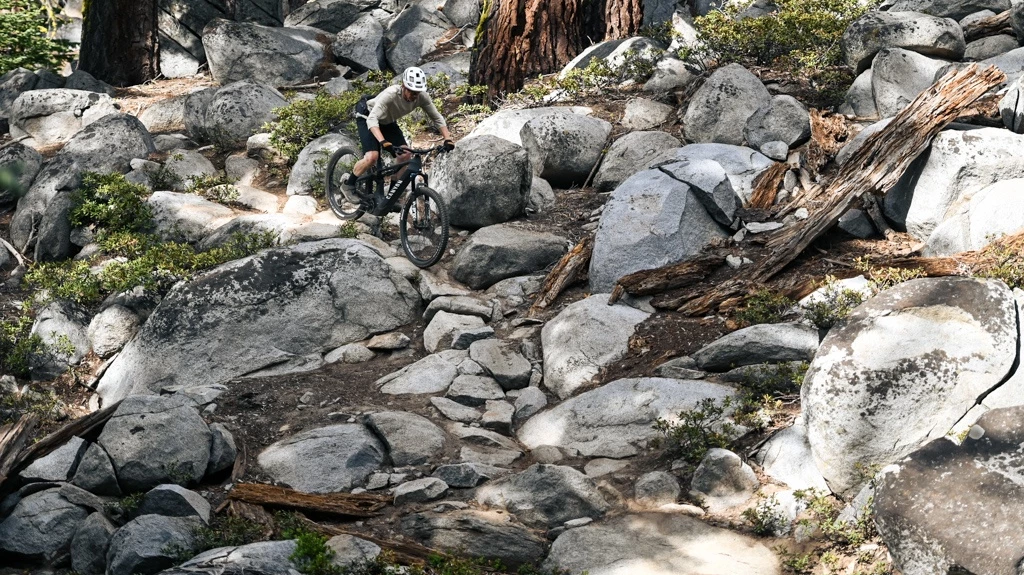
Best Fat Bike
Fezzari kings peak comp.
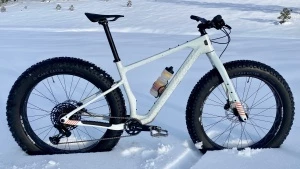
Fezzari may not be a household name in the mountain bike market, but the consumer-direct brand is hoping to change that by producing quality bikes of all kinds, including the Kings Peak Comp fat bike. With a geometry reminiscent of a regular trail bike, the longer and slacker Kings Peak has a very familiar feel when the rubber hits the snow and/or dirt. Fezzari's 23-point custom setup ensures a comfortable fit, and the angles are spot on for typical fat bike riding while still being surprisingly capable when taken out of the normal fat bike comfort zone. With a sleek carbon frame and a weight of only 31 pounds, this bike pedals efficiently across virtually any surface and looks good while doing it. The frame and fork feature a wealth of mounting points for water bottles and other accessories, making it easy to gear up for bike packing or far-flung adventure rides. While not exactly flashy, the build is perfectly functional. Fezzari also offers a more expensive build and a number of component upgrades to choose from.
Aside from a couple of minor gripes, we loved the Kings Peak Comp . We love SRAM Eagle drivetrains, but the SX version isn't impressive. It works well enough, but we find the shifter particularly problematic. It's consistently hard to position it in an ergonomically friendly manner. The slipping grips on this bike could easily be remedied with a simple pair of lock-on grips. The Clarks M2 brakes work well enough to control typical fat bike speeds, but we are unsure of their long-term performance and durability. Otherwise, this bike was excellent, and it gets our recommendation. We also recommend the Ibis Ripmo V2 XT if conditions don't require a fat tire and you want the best trail bike all around.
Read more: Fezzari Kings Peak Comp review
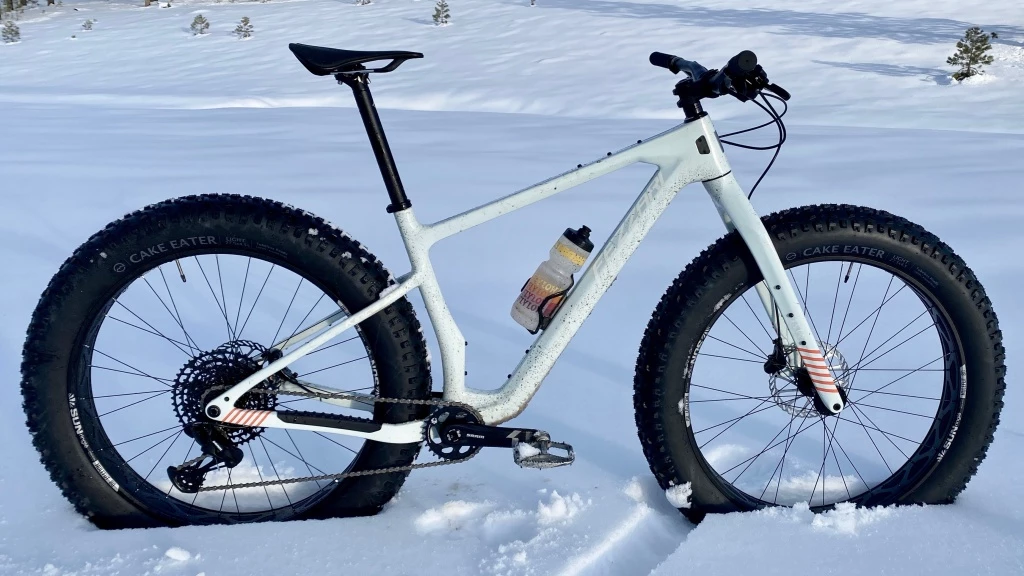
How We Test Mountain Bikes
Our testing process is based on identifying the best MTB bikes on the market and putting them through extensive hands-on testing. Our team of testers ride these bikes to their limits to see how each bike performs in a wide variety of terrain. We do endless laps at bike parks, all-day epic rides, huge multi-thousand-foot climbs, and gnarly descents. Our team has been testing mountain bikes in this rigorous manner since 2017. You name it: trail bikes, enduro bikes, hardtails, fat bikes, electric mountain bikes, and mountain bikes under $3000, and we've tested them. Over the past five years, we've spent over $100,000 purchasing the mountain bikes we review to remain as objective and unbiased as possible. Recent bike availability challenges brought on by mountain biking's recent explosion in popularity, coupled with global supply chain issues, have made it more challenging to buy bikes for testing. In 2020 and 2021, it occasionally became necessary for us to rent demo bikes from local shops or to acquire media demo bikes directly from manufacturers to continue to test and review the latest mountain bikes. In the case of media demo bikes, we insisted on paying for the use of the bikes or making an in-kind donation to a trail advocacy organization to compensate for its use and maintain our objectivity.
Why You Should Trust Us
Our Senior Mountain Bike Review Editor leads our test team, Jeremy Benson . Benson has been mountain biking since the early '90s and has seen and experienced the evolution of mountain bikes firsthand. The 20-year Lake Tahoe resident is an obsessive rider and competitive mountain bike and gravel racer who spends an excessive amount of time training, testing, and simply riding bikes just for fun. Benson is also a local trail expert and the author of Mountain Bike Tahoe , published by Mountaineers Books.
For several years, Benson has received testing input from a diverse group of professional bike testers. Former GearLab Mountain Bike Editor turned bike shop owner, Pat Donahue is a talented rider with a preference for steep and chunky descents. He is particularly tough on and critical of the gear he uses and has a keen eye for the performance characteristics that make a great bike. Joshua Hutchens is a lifelong mountain biker, former racer, guide, and shop owner who rides with finesse and style. He's ridden hundreds of different mountain bikes over the years and can identify the most subtle and nuanced differences between the bikes he tests. South Lake Tahoe native Kyle Smaine was raised at the bottom of some of the area's most iconic trails. Kyle is a talented professional skier with a healthy collection of medals in the halfpipe. In the warmer months, he spends his days putting impressive times both up and down the mountains and is among the most talented multi-sport athletes in the greater Tahoe area.
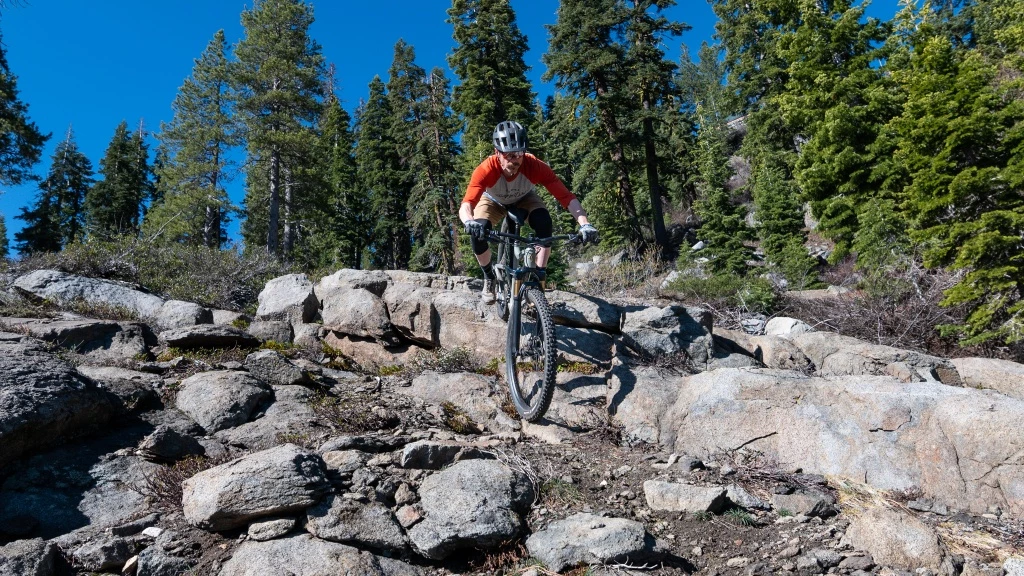
How to Choose a Mountain Bike
Purchasing a mountain bike is an expensive endeavor and can be downright scary. Slapping down the credit card for a large purchase requires serious research. All of this research can bring to light loads of jargon and terms. Terms like mid-travel, short-travel, and enduro are always thrown around. OutdoorGearLab is here to make sense of it all.
We will explain the different types of mountain bikes and what they are designed for. Once you settle on a category of bike, you will need to consider wheel and tire size. 29-inch, 27.5-inch, plus-sized, they all have strengths and weaknesses. Female riders have to decide if they need a women's bike or if they can tweak a unisex bike to fit them better. We will walk you through all of these decisions.
Types of Mountain Bikes
It is essential to be realistic about what kind of terrain you want to ride because the right type of mountain bike will vary depending on where you will ride. Determining what sort of trails you have in your hometown is important. Also, it can be worth considering if you will be regularly traveling to bike parks or trail centers.
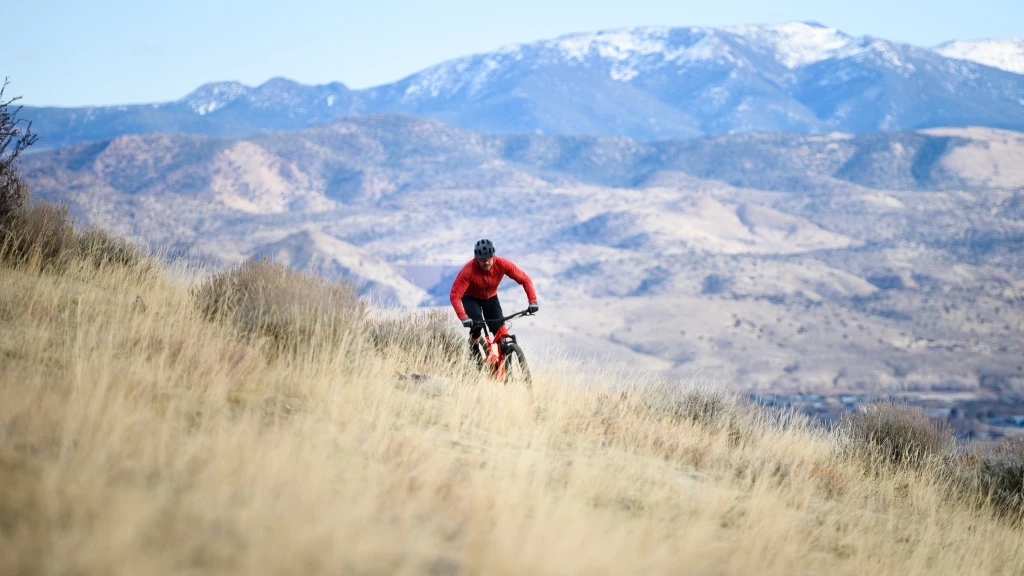
Cross-Country Bikes
Cross-country bikes are very much a niche category. If you are reading this, chances are most of these bikes probably aren't for you. Folks interested in a true cross-country bike are likely thinking about racing and value weight and efficiency over fun, comfort, and practicality. XC bikes are fun on a more limited range of trails. Stiff and brutally efficient, cross-country bikes are either hardtails, meaning they have no rear suspension, or they have about 100mm of rear suspension. Steeper geometry, a low stem, and firm and unforgiving performance are features of these bikes.
Riders who gravitate to very smooth trails might enjoy the outright efficiency of these bikes. If you want a playful ride or live where the trails have roots and rocks, these probably aren't the best choice unless you're planning to race on the XC circuit. A short-travel trail bike is almost as efficient while offering a far more fun and capable ride.
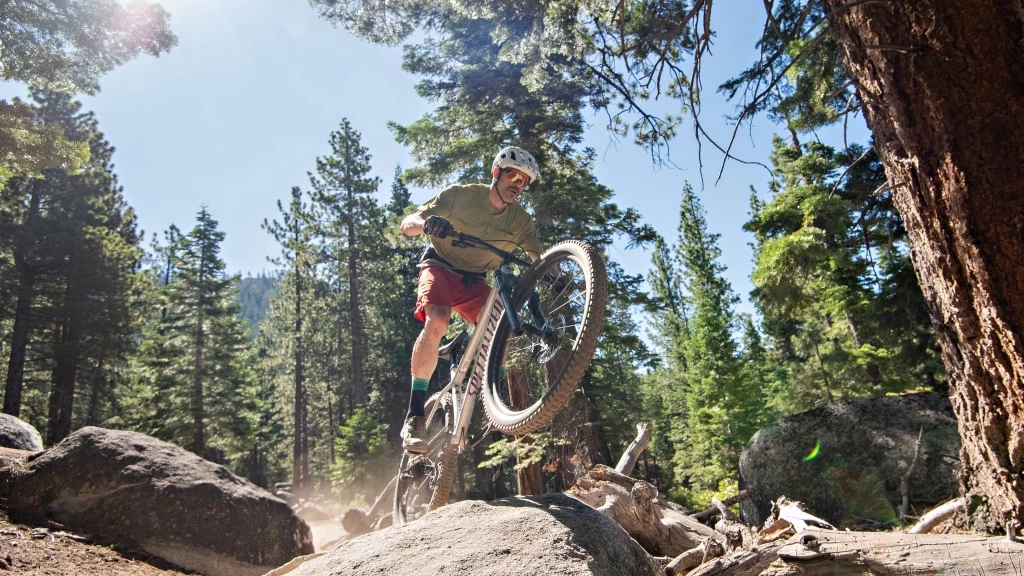
Trail Hardtails
Hardtail mountain bikes are a great option if you'd rather get out and ride than attack steep or rough terrain regularly. Simple, low maintenance, and speedy — these no-frills bikes do not have a rear suspension but feature more aggressive trail bike geometry. As a result, they are very efficient pedallers and are perfectly capable of getting a little rad. Less experienced riders will gain valuable skills on these less forgiving bikes, which benefit from excellent line choices and proper form. Hardtail trail bikes are relatively versatile but require some caution on the descents as they tend to be somewhat harsh. Riders who prefer to attack steeper and rougher terrain with any regularity should look into a full-suspension bike.
Since hardtails require less technology, they are usually less expensive than full-suspension bikes. A lower price point makes hardtails an excellent option for passionate riders on a budget. If you think these are the bikes for you, check out our review selection of hardtail mountain bikes.
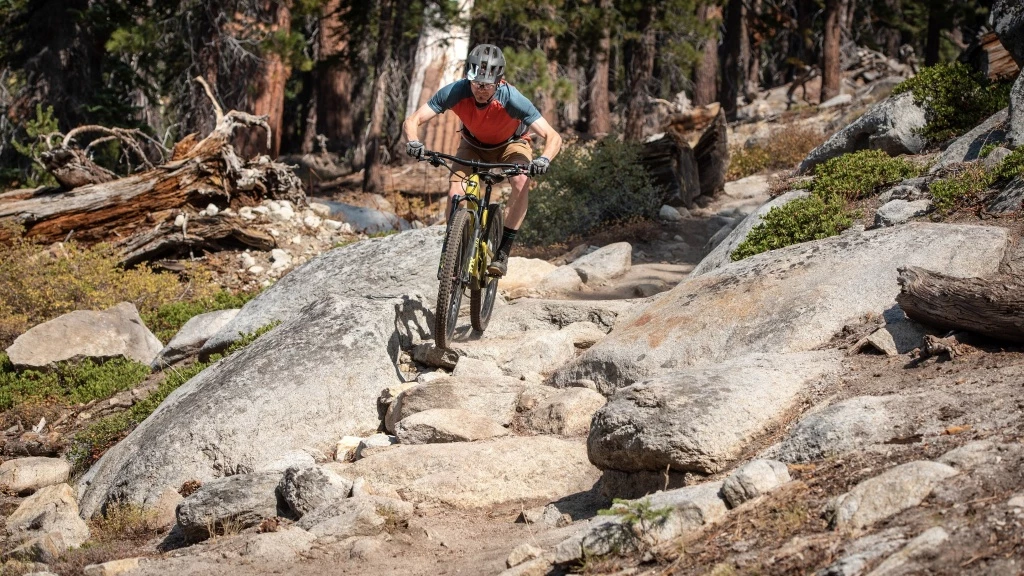
Short-Travel Trail Bikes
Short travel bikes are excellent if you value variety and efficient climbing and aren't hell-bent on slaying descents. Short-travel trail bikes feature about 110-130mm of rear-wheel travel. They are practical for those looking for full-suspension confidence and comfort without sacrificing efficiency. Riders who like to pound out serious miles will feel comfortable aboard these short-legged steeds. Bicycles in this category would be an excellent option for those who ride flatter terrain or live in mountainous areas but don't want to push the envelope to get aggressive on the descents. Riders seeking a more well-rounded climbing/descending experience might be interested in pulling some more heft with a mid-travel bike. If this seems like the balance of bike skills you've been looking for, check out the 110 to 130mm options in our constantly updated review of the best trail mountain bikes . Travel numbers appear in Suspension & Travel row of our Test Results and Rating Table.
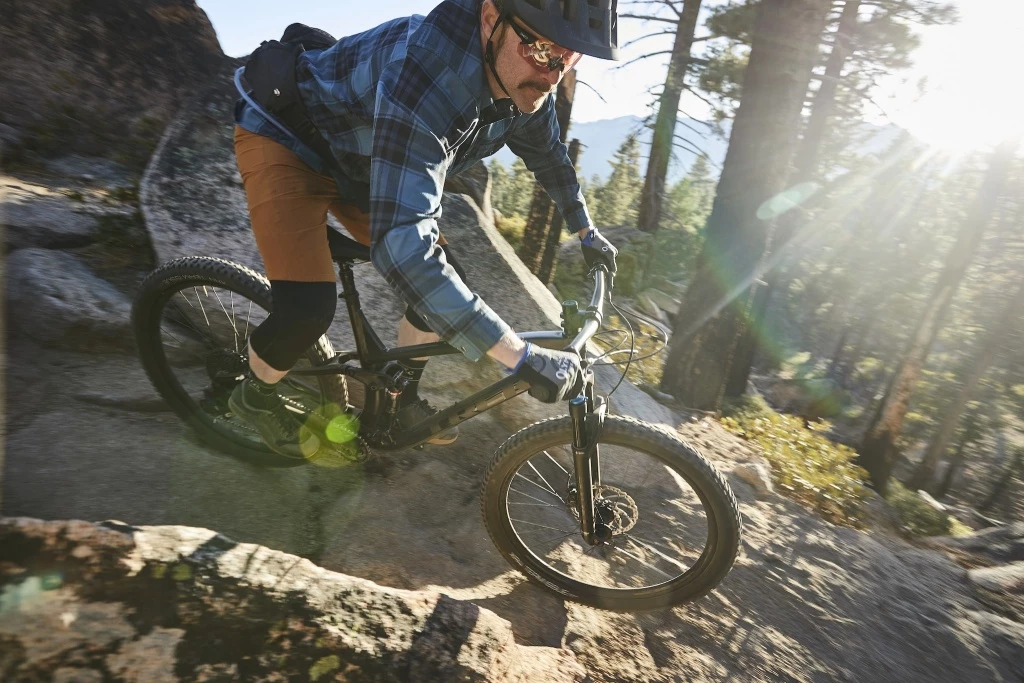
Mid-Travel Trail Bikes
Mid-travel bikes are an MTB sweet spot perfect for anyone who destroys descents but still values climbing skills. These bikes are very versatile and provide strong performance in all areas. They balance climbing skills and descending capabilities beautifully and are comfortable on the overwhelming majority of trails. Mid-travel bikes are just as comfortable making the occasional trip to the bike park as they are doing a 30-mile trail ride. This suspension range, 130-150mm, works for a large portion of riders. If you live in a primarily flat or smooth region, these bikes could prove to be overkill. If the highlight of each of your rides is flying down the super-gnar, you should look into an enduro/long-travel rig. If you're interested in this multi-faceted and fun category, head over to our ever-evolving best trail mountain bike review to read about fantastic daily drivers in the 130 to 150mm range. Find travel numbers near the bottom of the Test Results and Rating Table.
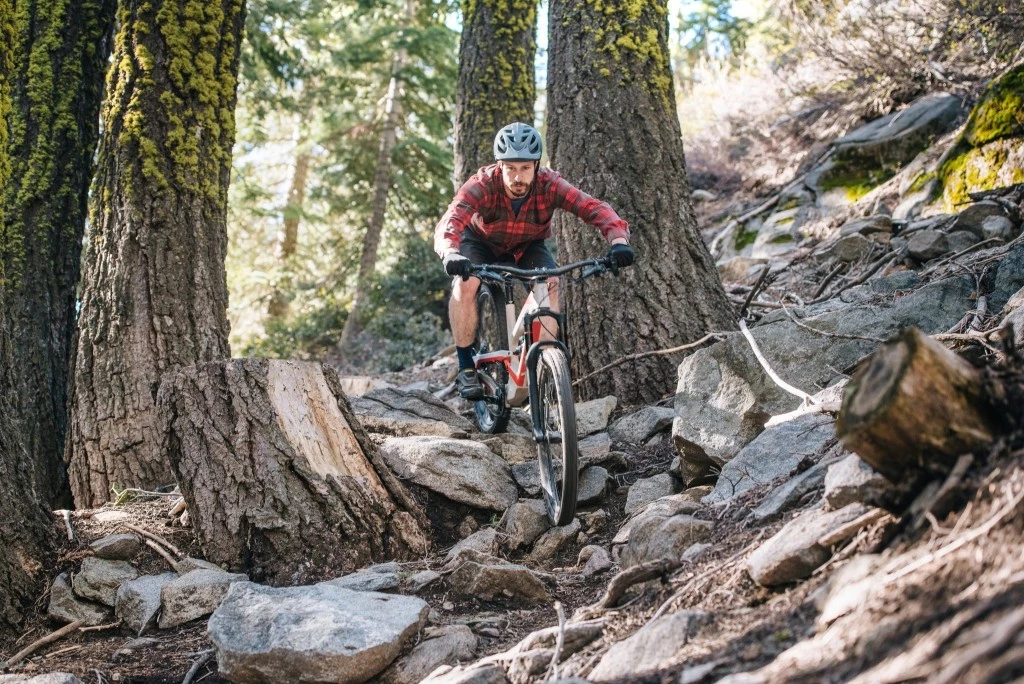
Enduro Bikes
Enduro is an often over-used buzzword, and enduro bikes love to bomb technical descents and climb just enough to get to the top. Long-travel, or enduro, bikes are awesome for those who don't mind carrying some extra bike around in the name of getting rowdy. With 150 to 170mm of travel, they pedal reasonably well, but efficiency is far from their defining trait. These bikes are not the best for long-distance rides, and will not set any climbing records. Enduro bikes focus on high speeds and rough downhills. Those looking for freeride lines or park laps will be more than comfortable aboard these shred sleds.

Choosing Bike Components
Once you know what kind of mountain bike suits your riding style and terrain best, a few component decisions will help you narrow down the field considerably.
Not all that long ago, all-mountain bike wheels were all 26 inches in diameter. Now, 27.5-inch and 29-inch versions are far more common on the trail. The 26-inch wheel size is all but forgotten. The benefit of bigger wheels is that they make trail features smaller by comparison. As a result, you can roll over obstacles on the trail more efficiently and with less effort. Bigger wheels are also faster and carry speed and momentum well through chunky terrain. The argument for smaller wheels is that they are easier to maneuver and, therefore, more fun. For a few short years, many riders thought 27.5-inch wheels were the sweet spot between the rollover benefits of 29ers and the agility of 26-inch bikes. Modern frame geometry has drastically improved the performance of 29ers, and they are allowing for more precise and playful handling than ever before. Mixed-wheel sizes have recently grown in popularity. A 29-inch front wheel paired with a 27.5-inch rear is commonly referred to as a "mullet" or MX setup, with business in the front and party in the back. The idea is that it combines the best traits of both wheel sizes. The larger front wheel rolls over obstacles more easily and provides stability and confident handling, while the smaller rear wheel offers agility and maneuverability for the rear end of the bike. One may want to consider their body size in their wheel size decision, as smaller wheels may feel more comfortable for smaller riders, and larger wheels might work better for larger riders on larger frames. Many frames now offer a few wheel and tire size options. It's still valuable to think through which one you want to commit to. We don't know anyone who regularly switches between wheelsets.
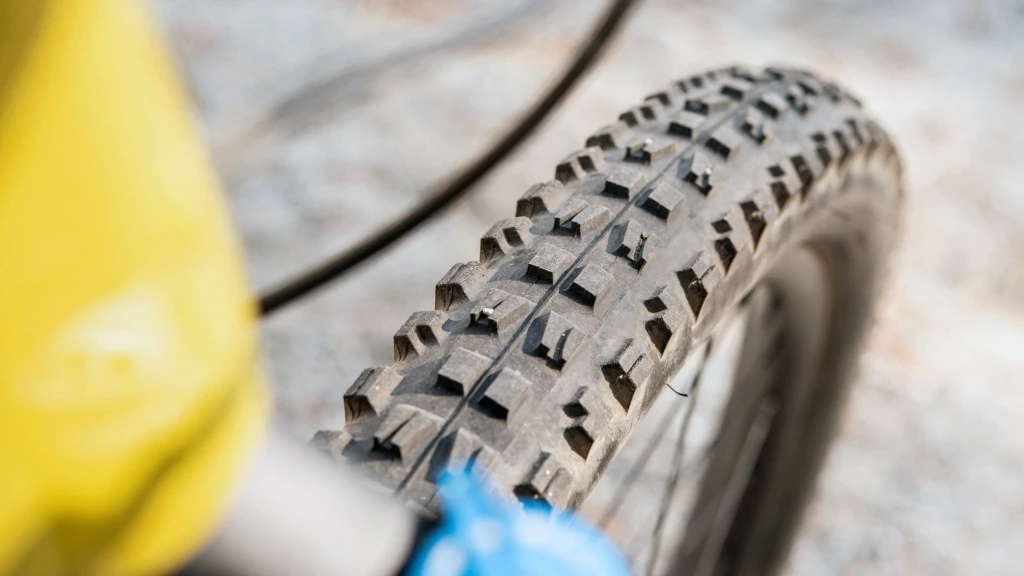
Tire Size and Rim Width
Normal tire widths have slowly been getting wider over time. Previously, 2.35-inch tires were considered relatively standard, but now they tend to run in the 2.4-2.5-inch range on most trail bikes or even 2.6-inch versions on wider rims. Wider tires have more air volume and a larger contact patch that offers tons of traction and a little softer ride, although they may provide more resistance when heading uphill. Then, there are your plus-sized or mid-fat tires. These run from 2.8-inches to 3-inches. We like the 2.8-inch versions as they offer traction and often give you defined cornering knobs to dig into turns. Three-inch tires provide you with plenty of grip but often a more vague cornering feel due to smaller, more uniform knobs. To get geeky about tires, check out our review of the best mountain bike tires .
Tires are easy to switch out and are among the most cost-effective ways to upgrade the performance of your bike. Rims are a much pricier and more time-consuming fix. Anything less than a 25mm rim is now considered narrow for an aggressive trail or enduro bike. We recommend trying to find something in the range of 28mm to 35mm, with the sweet spot right around 30mm. For less aggressive bikes, it's less critical, but traction is traction. We like it on all of our bikes. It's a good idea to ask manufacturers or dealers what range of tires you can run on their rims.

Choosing a Complete Bike Build
- Frame . Aluminum vs. Carbon is your first big decision point. Choosing an aluminum frame typically involves substantial cost savings. It's typically slightly heavier, flexes more easily, and doesn't have the strength of modern carbon. If you're just trying to get out on your bike, aluminum is great. Carbon fiber is more expensive, lighter-weight, and stiffer than aluminum as a frame material; it's also superior at dampening vibrations. Consider carbon fiber if investing in your bike is a priority and you plan on having it for an extended period. Carbon fiber ages better than aluminum.
- Fork and Rear Shock . Suspension components come in a huge range of price points. The differences between low-end and high-end suspension componentry are significant, though it may not be apparent to riders just starting out. A higher-end fork and rear shock will be more adjustable to your weight, riding style, and personal preference. Heavier riders will find more comfort and durability with coil-sprung suspension than shocks that rely solely on air reservoirs.

- Drivetrain . It's important to note if the drivetrain has one (1x) or two (2x) chainrings. Two chainrings require a front derailleur, meaning you have shifters on both sides of your handlebars. We like 1x better. It's simpler, easier to shift, leaves more room for a dropper seat post control, and is less to destroy. Most modern mountain bikes come with 1x drivetrains, which typically have 11 or 12 total gears.
- Wheelset . Higher quality is better, but pay attention to the rim width, which can drastically alter how effective your tires are. Rims are getting wider along with tires, making traction plentiful and bikes more comfortable. Like bike frames, rims come in aluminum or carbon fiber, and the latter are typically much more expensive.
- Seatpost . We highly recommend a dropper seat post. Here's a review of some of the best . If you're not a convert already, it will change your game more than any other single shift. Sometimes, it's worth jumping up to a higher quality complete build to get one, and sometimes, it makes more sense to get one separately.

Women's Bikes
The majority of mountain bikes are considered unisex models. What makes any bike a woman's bike is whether or not a woman is riding it. The problem with only providing unisex models for both men and women is that these bikes are set up for the average rider. The average rider still skews male and is around 30 pounds heavier than a woman of approximately the same height (according to women's MTB company Juliana and the Center for Disease Control and Prevention). Men are also taller than women on average. This means that frames can be too big, and standard shock tunes can be too stiff for smaller, lighter riders.
Several bike manufacturers address this issue by making women-specific models. Some take a step further and branch off into separate, women-specific companies. Examples of the latter include Santa Cruz's Juliana and Giant's Liv . It used to be more common to build women's bikes from the ground up with unique geometry. Now, most companies provide unisex frames with lighter shock tunes, different colors, and women's specific touchpoints. These touchpoints include women's saddles, smaller grips, and sometimes shorter cranks and narrower handlebars.
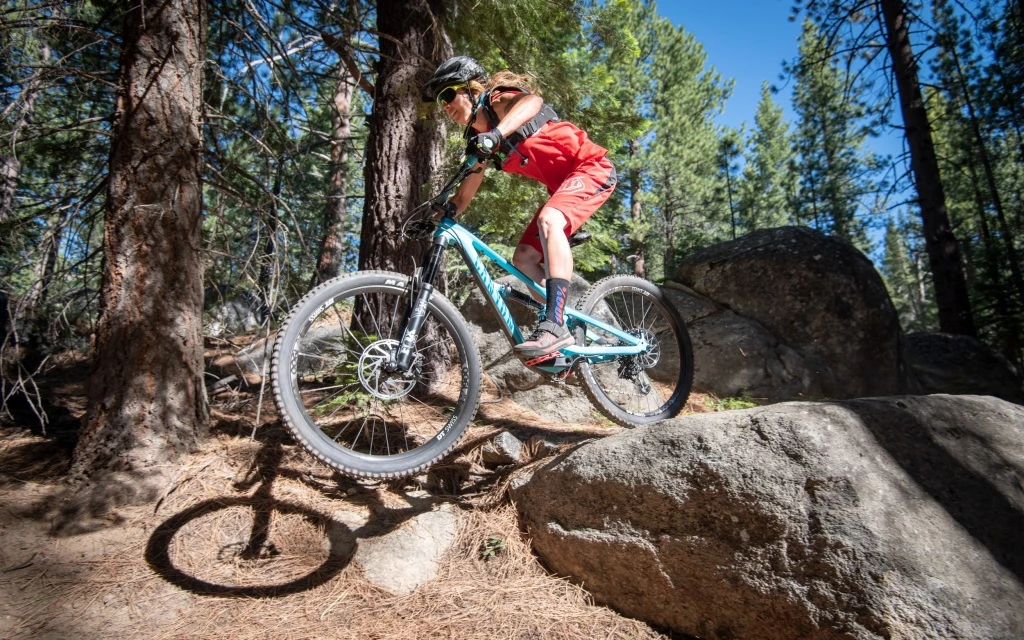
Setting frame design aside, we find sizing and shock tunes to be the most essential elements of a women's mountain bike. First, a bike has to fit. Second, its fork and shock need to respond to small impacts and use their full travel range on larger hits. At that point, you have a functioning mountain bike. These days, many manufacturers are using lighter shock tunes on their smaller-sized bikes to work better for smaller riders.
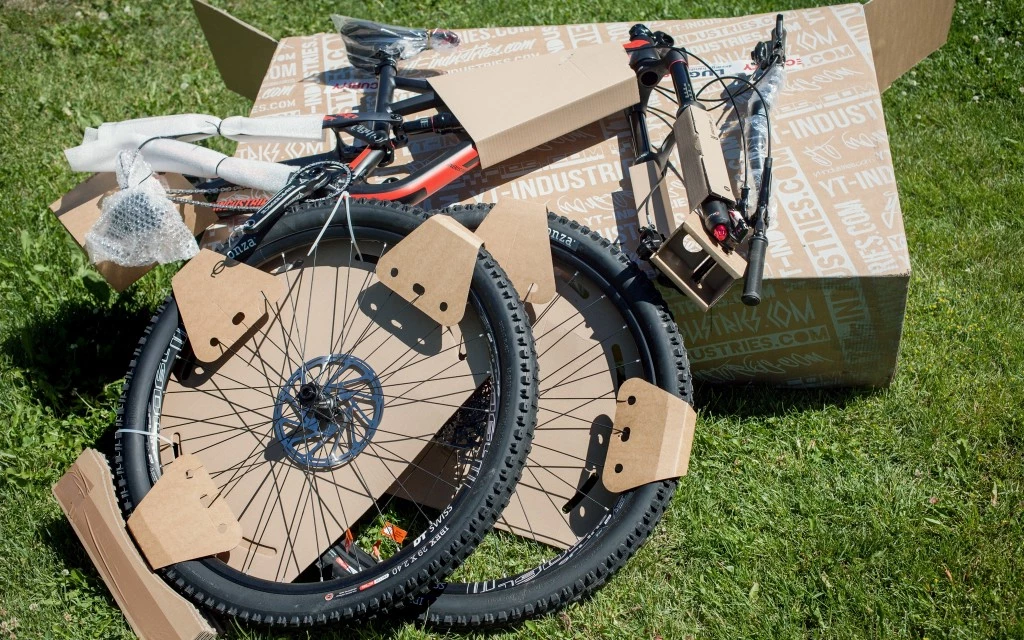
Consumer Direct vs. Local Bike Shop
Consumer direct sales are a growing trend in the mountain bike industry. More and more brands are selling their bikes directly to the consumer, cutting out the local bike shop. With the middleman cut out of the sales chain, companies can sell their bikes at extremely attractive prices. Brands like YT , Commencal , and Canyon are the biggest consumer-direct brands in the USA.
Convenience and savings often come at a cost, and buying consumer-direct is no different. Purchasing a mountain bike at a bike shop buys you a relationship with a shop and maybe some small complimentary services. Quick repairs and warranty services may often be conducted for free. In addition, your local bike shop can be a wealth of knowledge, and well-trained mechanics can spot issues before they become problems.

Multiple Bikes?
Having a quiver of mountain bikes is the definition of luxury. A multi-bike quiver can be the best solution to get the most out of this fantastic sport. That said, it certainly isn't cheap. Having a short travel bike and an enduro bike will have you covered on the bulk of trails. Since this is somewhat unrealistic, we place a lot of emphasis on mid-travel trail bikes. These are often the best solution as they are comfortable on a huge variety of terrain. Long rides, some shuttle laps, after-work hot laps, these bikes can do it all. You can always rent a longer travel bike for an occasional trip to the bike park.
Related: How to Select the Right Mountain Bike
Trainers, Exercise Bikes, and the Off-Season
Some people are lucky enough to have year-round trails in their backyards. For the rest of us, the off-season and time constraints are real. Luckily, there have never been more options for training at home if you can't get on the trails. Many of the best exercise bikes have evolved into interactive machines you can ride solo or with groups. These bikes now allow you to join a live group ride or follow some of the most scenic road rides around the globe. Perhaps even more intriguing are the latest and best bike trainer options, which allow you to train on your favorite bike with most of the features of high-end stationary bikes. And for those who want to use the off-season as an excuse to specifically take a break from riding, a model from our best treadmill review might be the call.
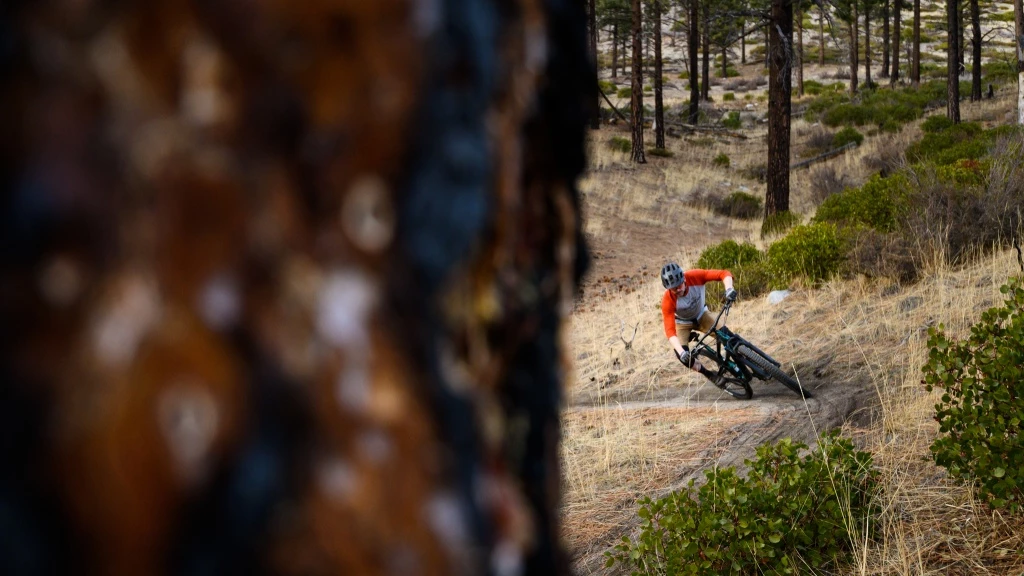
Best Bike Gear of 2024

12 Best Electric Bikes of 2024

Best Trail Mountain Bikes
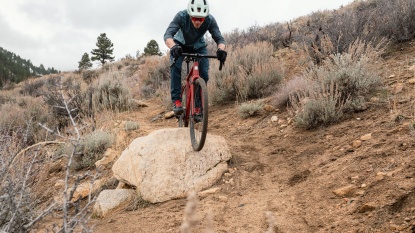
Best Gravel Bikes of 2024

The Best Bike Racks of 2024

Best Hitch Bike Racks of 2024
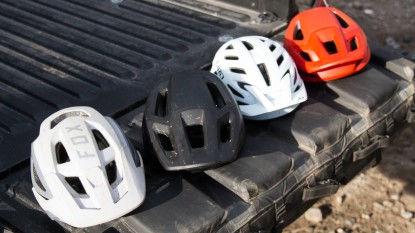
Best Mountain Bike Helmets
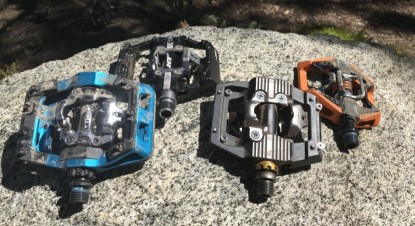
Best Mountain Bike Pedals

Best Mountain Bike Shoes

The Best Short-Travel Trail Bike – 6 Mountain Bikes in Test

Bikes are growing increasingly versatile, lines are blurring and long-travel bikes are climbing more easily and faster than ever before. But does that mean that short-travel trail bikes are growing more potent on the downhills too?
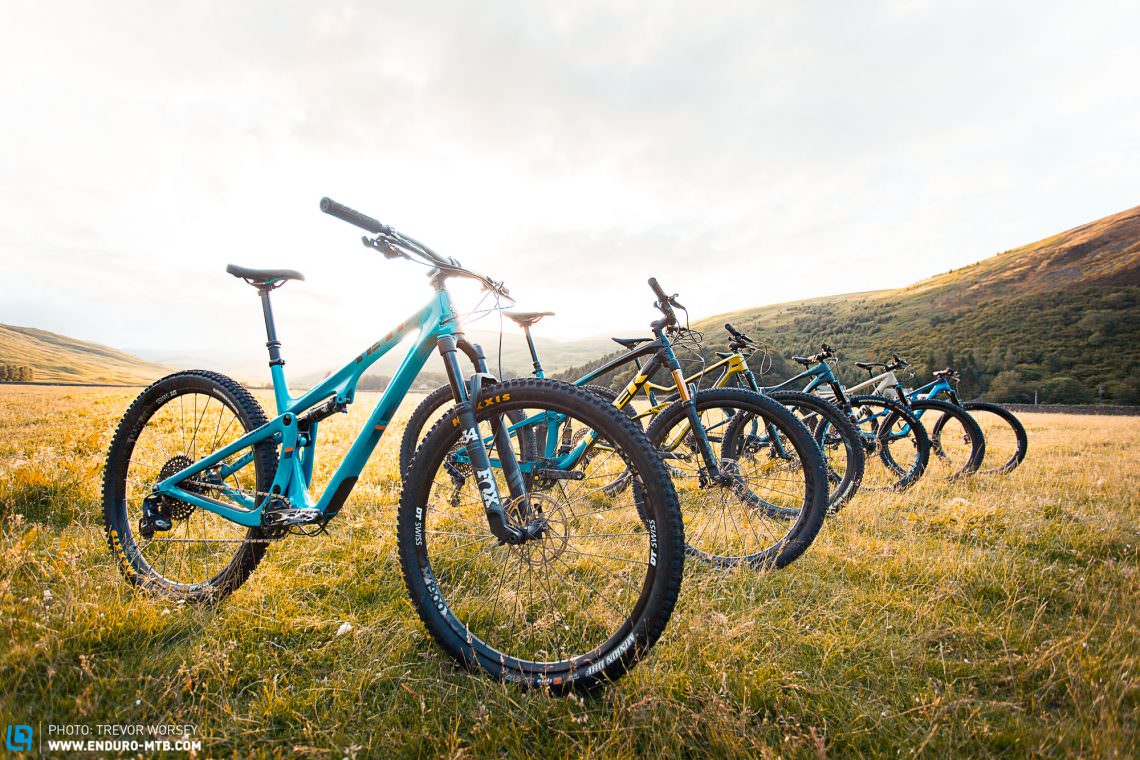
Our trail bikes are changing. We now have suspension kinematics that minimise pedal bob, while maximising big-hit fun. Seat tubes are growing steeper so we can climb better and bikes are growing increasingly lighter. The latest generation of 140–150 mm trail bikes have become the holy grail of do-it-all machines. So why do manufacturers still offer short-travel trail bikes? Is there a benefit to bikes with 130 mm or less travel? Are we missing something? So many questions. It’s time for some answers.
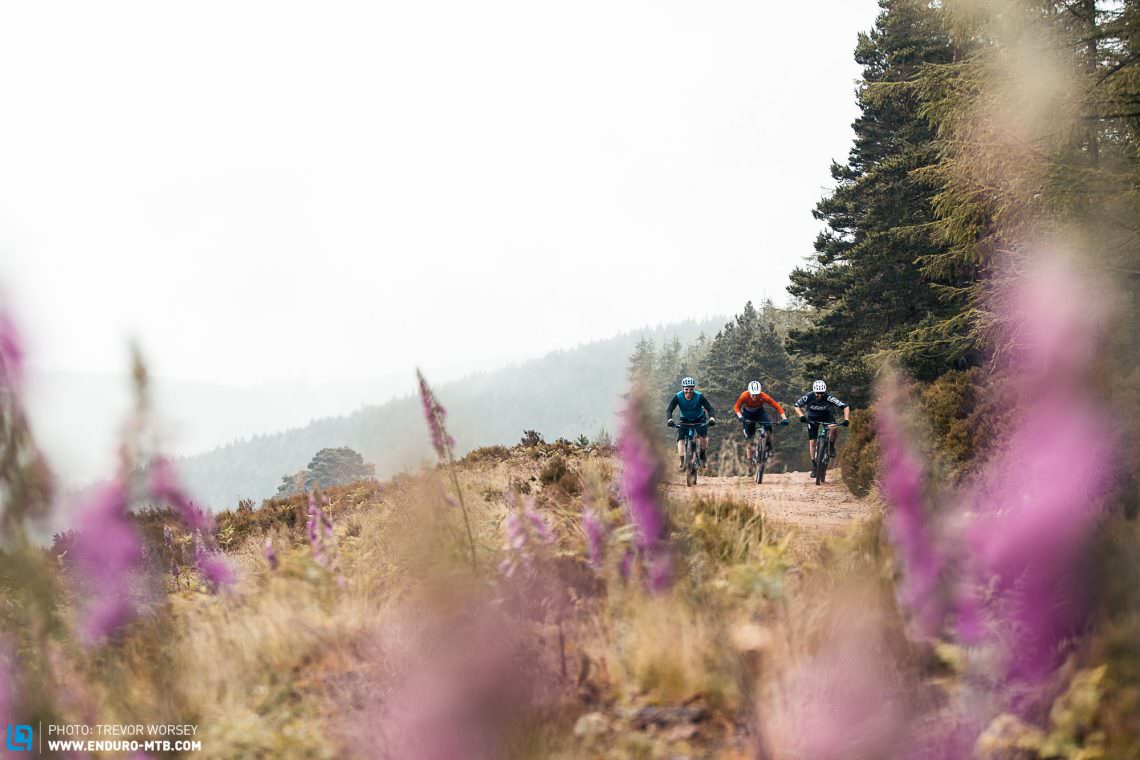
Does short-travel mean less fun?
Does short-travel mean less fun? No way! If your local mountains are more like molehills, and your Sunday ride involves long connections between the trails, a short-travel bike will be a quick-riding passport to adventure and endless fun. On flow trails, a short-travel bike will pump faster through compressions and stay higher in its travel, rewarding you with more smiles and heaps of excitement. On many rides, carrying extra travel only dulls the sensations and feedback from the trail, meaning less agile and engaging handling than a well designed short-travel bike can provide. While a 140–150 mm trail bike is a great choice for many riders, the best bikes in this test show it’s important to choose a bike based on where and how you want to ride, rather than just numbers on a spec sheet.
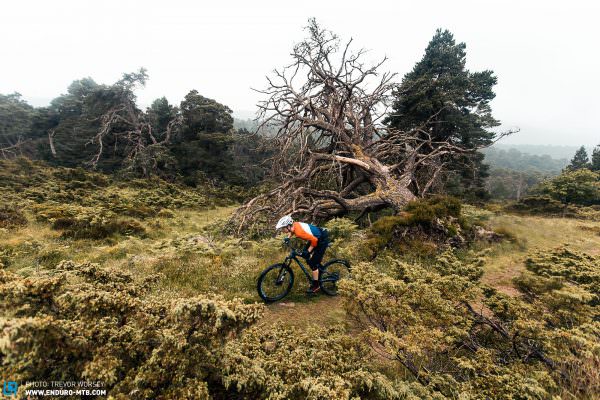
Imagine driving a Dodge V8 and a stripped out rally hatchback down a tight-twisty road. We can guarantee you’ll have more fun in the lighter, more agile rally car.
The short-travel trail bikes in this group test
For this group test, we wanted to include a diverse selection of bikes at a range of prices. On paper, all six bikes share similar geometry (with one exception) and range of application. All are 29ers, a wheel size that best suits the kilometre eating, corner railing nature of a good short-travel bike. The Specialized Epic EVO and Trek Top Fuel both mark a step up in versatility from dedicated XC race machines. They essentially take a racing platform but slack and stretch it out. The Whyte S-120C enters from the opposite end of the spectrum, packaging an enduro bike ethos in a short-travel chassis. Sitting in the middle, the Canyon Neuron, Merida ONE-TWENTY and Yeti SB100 are purpose built to be good at everything from marathon epics to fast laps of your local loop.

Suspension kinematics are important
The saying “It’s not about the size, it’s about how you use it” has never been more apt. With short-travel bikes, progressive suspension kinematics are essential. With less to play with, the suspension needs to maintain control and can’t give up all its travel too quickly. For active riders, the Merida ONE-TWENTY, Trek Top Fuel and Whyte S-120C excel with a supportive kinematics that give just enough travel to smooth out big hits and almost always retaining some reserves. The result is that these bikes provide massive support for pumping to generate free speed from the trail and also provide lots of feedback from the trail. In contrast, the Canyon Neuron and Yeti SB100 have more linear kinematics, sacrificing a little mid-stroke support in pursuit of comfort and control through rock gardens, as well as boosting comfort and reducing fatigue on longer rides.

Be suspicious of a low weight on the spec sheet
If you think that less travel equals less weight, you might have to reconsider. Given how hard we ride our bikes, both short- and long-travel bikes will actually require very similar components and in turn, it becomes hard to cut down weight without significant compromises in performance.
No matter if you have 100 or 150 mm of travel, you’ll still be riding effectively the same suspension units, need the same high-performance tires and will want to be able to brake just as quickly. Many brands make compromises to lower their bikes’ weight, saving a few grams on the scales by fitting inferior components. Brakes are often an easy and not immediately obvious downgrade. Fitting delicate 160 mm rotors on the rear and specifying smaller callipers might save 200–300 g, but the brakes still have to slow down the mass of a hard-charging 80+ kg rider. Do you ride a flow trail slower than an enduro trail? We don’t. Merida is the only brand to get this right, fitting powerful SRAM Code RSC brakes to their ONE-TWENTY. Tires are the next place to cut weight. While short-travel trail bikes do not need to come fitted with super heavy downhill casings, we still expect to see a versatile, capable and above all durable tire.
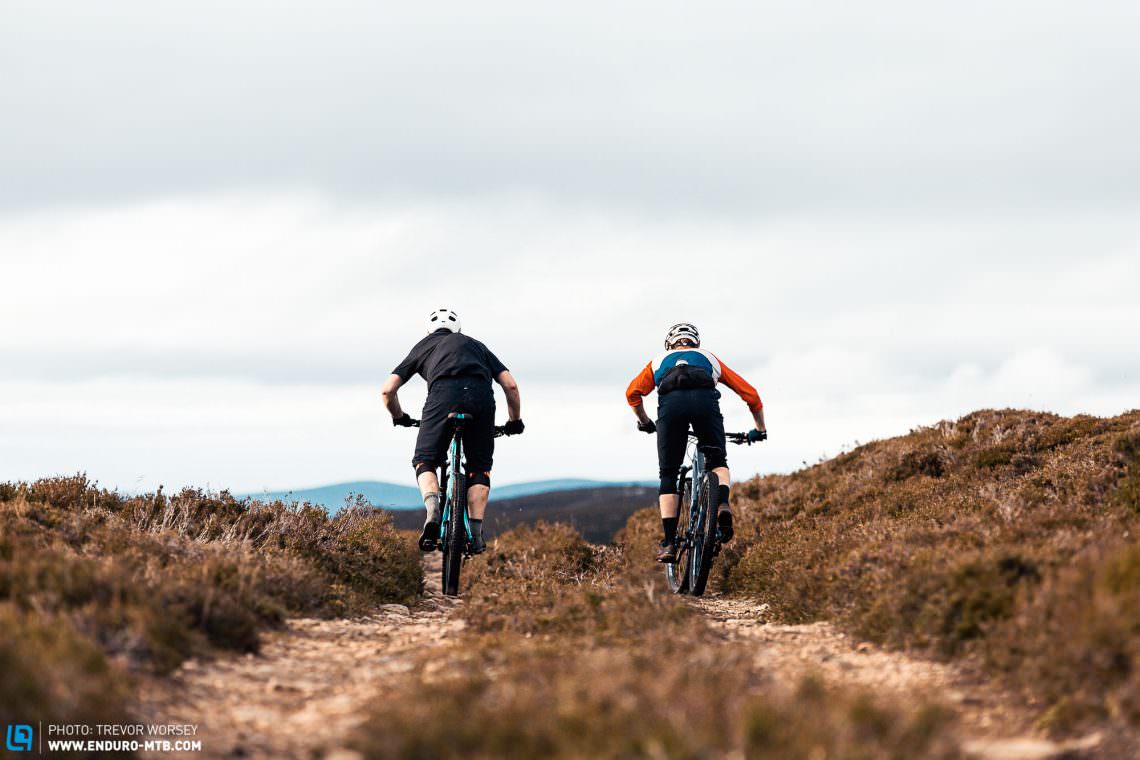
Carbon vs Aluminium Wheels
You can have a lighter bike without performance compromises but it will come at a cost. Spending more allows manufacturers to fit better components that reduce weight while maintaining or even improving performance. We are generally big fans of aluminium rims, especially on harder hitting bikes where they are more affordable if damaged and offer a smoother ride feel. However, lightweight carbon rims accelerate quicker and give the bike a more lively and agile feel, properties that in our test enhance the ride of our short-travel bikes. The Merida ONE-TWENTY 8000 scores well here, saving over 400 g on the combined wheel weight (4.38 vs 4.79 kg) when compared to the Yeti SB100 fitted with similar all-round tires. The Trek Top Fuel and Specialized Epic EVO both have very lightweight wheelsets, but also ‘cheat’ a bit by fitting lighter but less durable and versatile tires for combined wheel weights of 3.94 and 4.02 kg respectively.
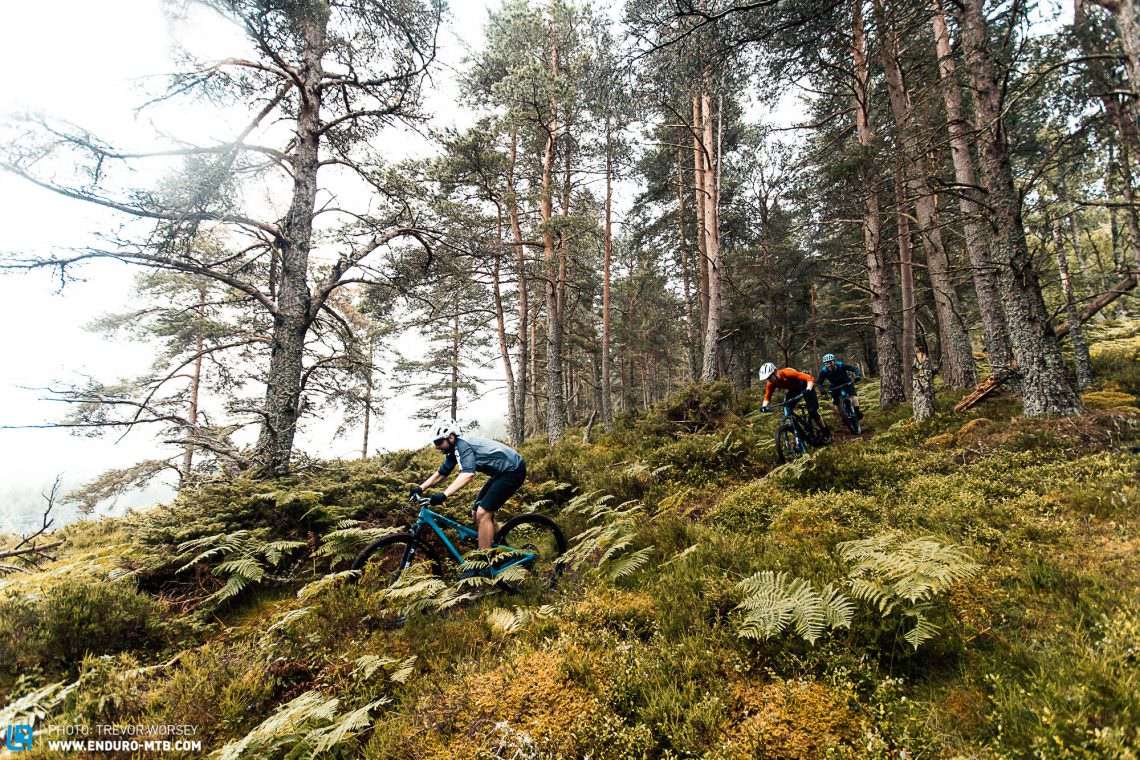
These bikes are made to climb fast so why don’t they have steep seat tubes?
This is a great question and one that consumed our team during much of our testing. The bikes in this group test have an average seat-tube angle of 74.8° , making them slacker than the latest geometry trends in trail and enduro bikes. The Merida again takes the win with a 75.5° seat tube angle, but still falls short when compared to the latest enduro bikes. Take the Yeti SB100: its 74° seat tube angle is far slacker than the newer and longer travel SB130 and SB150 which both have 77° effective seat tubes. It’s true that short-travel bikes sit higher at sag than long-travel bikes, reducing the effective seat tube angle less, but could they learn a lesson in efficiency from their bigger brothers? Yes, they could. All the bikes in this test climbed better with the saddle far forwards on the rails, indicating that slightly steeper seat tubes would benefit overall pedalling efficiency. We hope that short-travel bikes follow the steep seat tube trend that is sweeping through the trail and enduro sector.
Tops & Flops
Often small details can make a huge difference: seamless integration, first-class ergonomics and carefully selected parts. Easier said than done – here are some of the tops and flops from this grouptest.
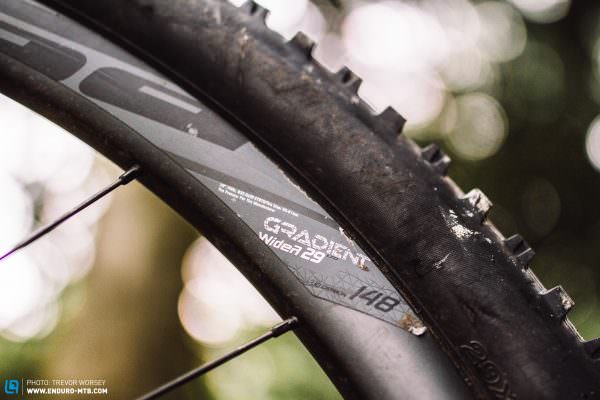
How we tested the bikes and where?
We packed the bikes into the back of a van and headed to the amazing trails of Ballater in the Scottish Highlands. Ballater is the hidden gem of Scottish riding, offering long flow trails, gruelling ascents and an iconic fast and furious ridgeline descent that is the perfect test of a short-travel ripper. We braved the Scottish midges and challenging weather conditions to push the bikes hard. Parts broke, tires were slashed but great fun was had. For a more thorough test of the bikes’ downhill performance, we also challenged them hard on shuttle assisted runs in the notorious Innerleithen bike park.
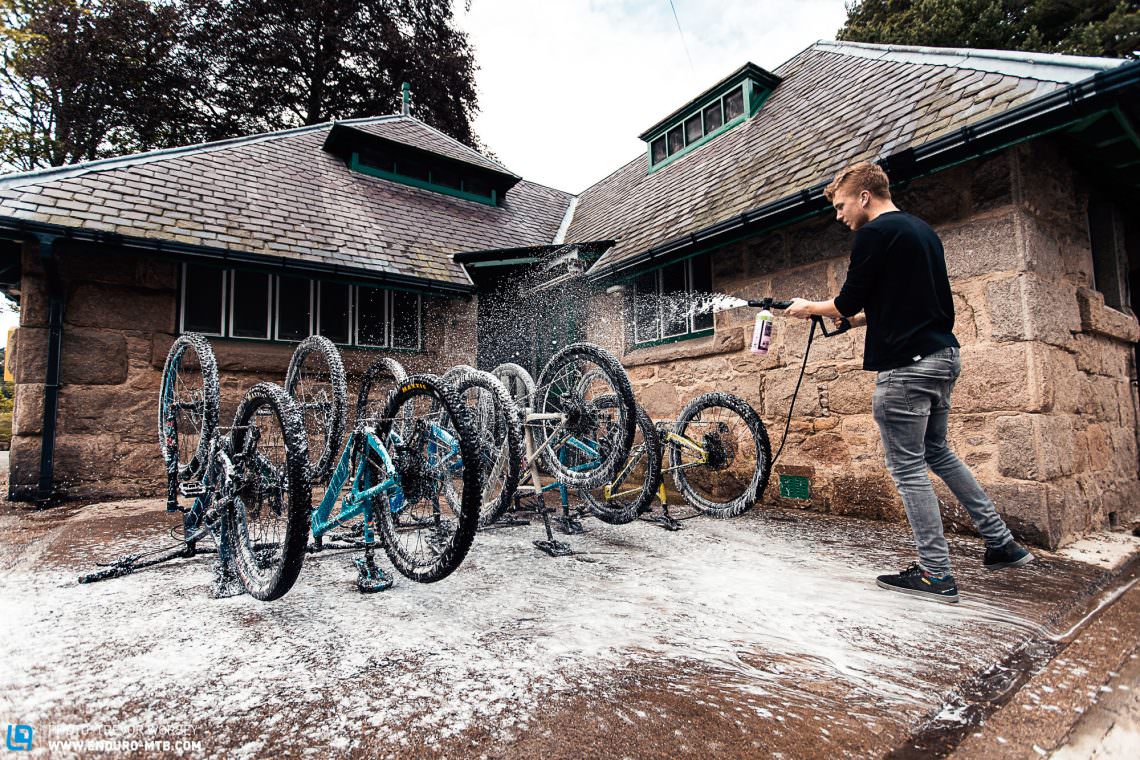
The test team

Six bikes with six very different personalities left us with many surprises. After extensive testing, the biggest surprise has been just how versatile short-travel bikes have become. Yes, many of the tires lacked grip and the brakes were weaker, but we soon found ourselves effortlessly straying onto full-bore enduro trails. The second surprise is just how much fun short-travel bikes are to ride. After-work rides become longer and big climbs are relatively speaking effortless. Staying high in their travel with supportive suspension, they turn even the most boring trails into a playground. Every compression is the opportunity to pump for more speed and every bump becomes the lip of a jump. If your trails are more flow than gnar, you’ll have more fun and smiles on a short-travel bike.

When it came to choosing our favourites, it was a tough call. With an XC oriented build kit, the Specialized Epic EVO was a beast on the climbs but it felt least at home on variable terrain. We also weren’t completely convinced by the Micro Brain shock, especially the noticeable delay before the inertia valve opens the compression damping under compression. The Canyon Neuron is the polar opposite: linear and efficient it would make a perfect bike for comfortable long tours but lacked spark when pushed to the limit. As is usual for Canyon, it does represent excellent value for money though. The Whyte S-120 C is the fastest bike on challenging terrain, where its progressive geometry and capable build kit give it an advantage that can be measured in seconds on the descents However, the uncompromising enduro specification and heavier wheelset is noticeable on the climbs when chasing the best in this test.
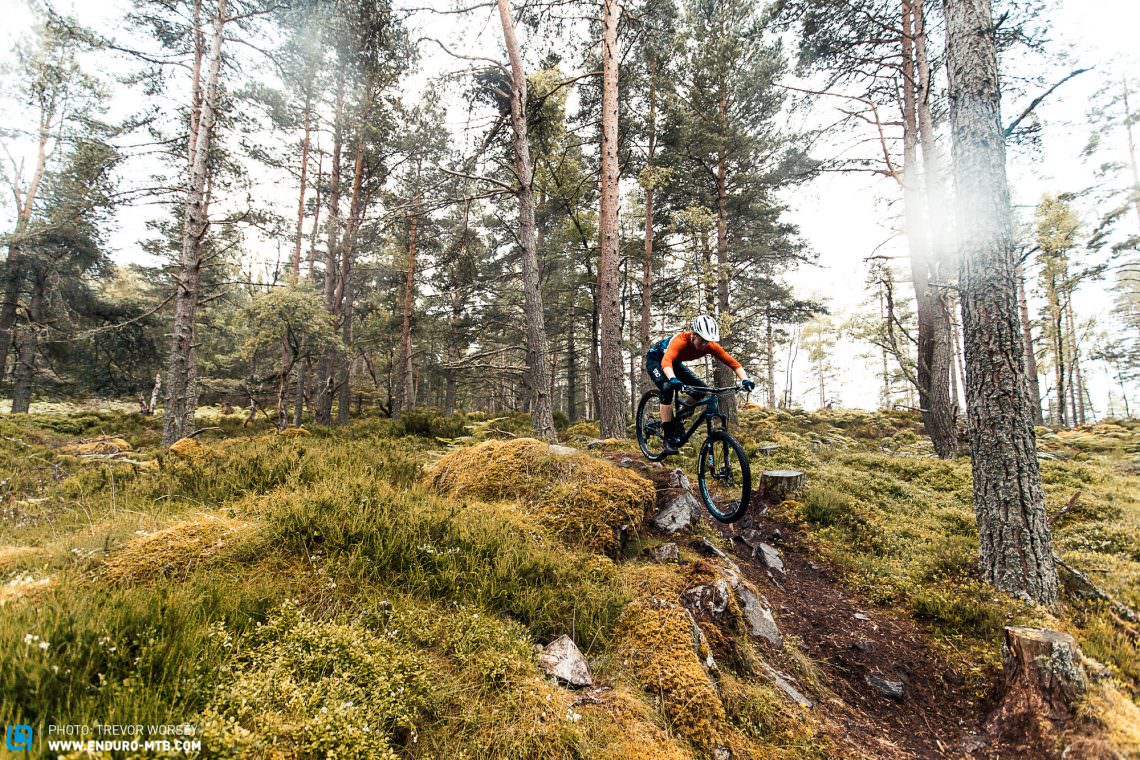
It was almost impossible to separate the top three bikes with all of them receiving high praise from the testers. The Trek Top Fuel is a testament to a new way of thinking. Potent, versatile and fiercely competitive, we can’t think of many situations where it would not excel. It was only the increased complexity of the TwistLoc (a grip shifter style suspension lockout) and the weak brakes that pushed it off the top spot. The Yeti SB100 was also a team favourite, blending effortless ground-covering efficiency with an easy-going playfulness that delighted all our testers. With a beautiful frame that deserves upgraded components, it’s a bike that we would be proud to own. For the first time ever, a Yeti takes our Best Value award. That leaves the Merida ONE-TWENTY : a versatile trail rocket that happily went everywhere and anywhere we took it. With a faultless build kit, great brakes, great suspension and an agile and engaging ride that will delight riders of all experience levels, there is nothing to fault, giving it the well-deserved Best In Test award.
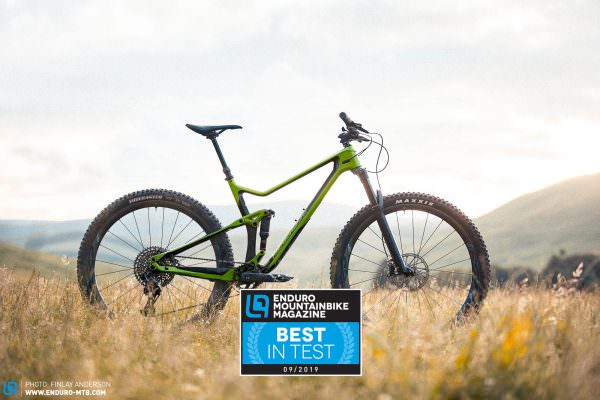
All bikes in test: Canyon Neuron CF 8.0 | Merida ONE TWENTY 8000 | Specialized Epic Expert Evo | Trek Top Fuel 9.9 | Whyte S-120C RS | Yeti SB100 C GX
If you’re looking for a bike with more travel you should definitely check our test about the best enduro bike of 2019: The best enduro bike you can buy
This article is from ENDURO issue #040
ENDURO Mountainbike Magazine is published in a digital app format in both English and German. Download the app for iOS or Android to read all articles on your tablet or smartphone. 100% free!

Did you enjoy this article? If so, we would be stoked if you decide to support us with a monthly contribution. By becoming a supporter of ENDURO, you will help secure a sustainable future for high-quality mountain bike journalism. Click here to learn more .
Words & Photos:
You may also like

The FOX Transfer Factory 2025 seatpost with 240 mm travel in review...

New 2024 Yeti SB165 on test – Fun > Fast

New RAAW Jibb V2 on test – Old terrier, new tricks?

Unstoppable – the new ENDURO issue #059 is here!

New 2025 FOX dampers on test – GRIP X2, GRIP X and GRIP SL

Light eMTB or just a lighter eMTB? The new Mondraker Dune Carbon in...

- Mountain Bikes
- Gravel Bikes
- Hybrid Bikes
- Electric Bikes
- Commuter Bikes
- Exercise Bikes
- Women’s Bikes
- Kids’ Bikes
- All Best Bike Brands
- Mountain Bike Brands
- Electric Bike Brands
- Bike Rack Brands
- Brand Review: Rad Power Bikes
- Brand Review: Ride1UP Bikes
Disclaimer: Bikexchange is reader-supported . We may earn an affiliate commission when you buy through the links on our site.
Best Trail & All-Mountain Bikes (130-160 mm travel)

Mid-travel full-suspension MTBs tend to cover a broader spectrum of mountain biking applications than other more specific MTB styles. With front and rear travel in the 130mm to 160mm range, these mountain bikes are usually classed as trail or all-mountain bikes.
These bikes are able to handle relatively mountainous conditions like rocky trails and singletracks but are less agile on descents than dedicated downhill MTBs. The suspension is usually just tight enough that it can still swallow up obstacles and vibration without losing too much speed and momentum while having a comfortable geometry to climb as well.
Check out the best models we recommend!
- You may also like: Best Full-Suspension Mountain Bikes
Best Full-Suspension Trail & All-Mountain Bikes
1 . ghost – riot am essential.

MSRP: $3,300 REI.com
The mighty Ghost Riot AM Essential stands out for its versatility and surprisingly high component level given the price.
Ghost chose a reliable RockShox Deluxe Select+ shock and FS-35 Silver fork, each with 160mm travel, modern trail bike geometry, and a one-piece rear triangle and rocker link that enhances stiffness and power transfer.
The Riot AM Essentail is worthy of consideration for anyone looking for a bike made by a reliable brand with solid componentry. However, the downside of this bike is that the Shimano BR-MT500 brakeset with 180mm rotors isn’t powerful enough.
- Drivetrain: Shimano Deore/SLX 12-speed, 10-51t
- Shock : 160mm travel RockShox Deluxe Select+
- Fork : 160mm RockShox FS-35 Silver
- Tires: Maxxis Minion DHF 2.5″/DHR 2.4″ EXO+
2 . Ibis Ripmo SLX

MSRP: $6,699
The new Ibis Ripmo SLX is one of the best trail mountain bikes on the market today, built around a premium full carbon frame with internal cabling and 2.6″ tire clearance.
It features a Shimano SLX 12-speed drivetrain with SLX M7120 hydraulic disc brakes and 160mm and 147mm DW-Link suspension.
With high travel suspension, the Ibis Ripmo is clearly intended for rougher terrain than most trail bikes. So lower the dropper post and charge down steep declines with stability and confidence, knowing the Maxxis Assegai 2.5″ EXO+ tires have your back.
- Frame: Carbon
- Fork : 160mm, Fox Float Factory 38
- Shock : 147mm Fox Float Factory X2
- Drivetrain: Shimano SLX 12-speed
Buy on Mike's Bikes
3 . Cannondale – Moterra Neo 4
Best all-around e-mountain bike by a well-known bike brand
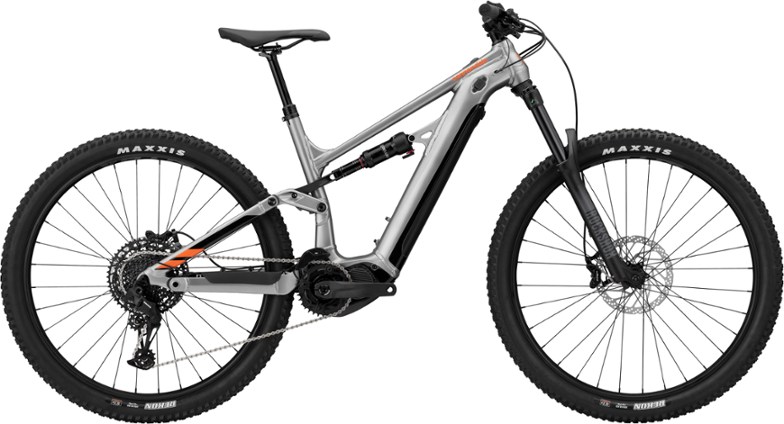
MSRP: $5,900 REI
Cannondale’s Moterra Neo 4 delivers an impressive combination of smart design, modern technology, and carefully chosen components.
The progressive geometry is low on the ground with a long wheelbase, steep seat tube, and slack head angle. This makes for a stable and comfortable ride on chunky descents.
Travel is at 150mm front and rear. This makes the Moterra Neo 4 an ideal enduro bike, best for charging down singletrack and through rock gardens. The RockShox suspension and SRAM SX groupset are solid choices, with Cannondale using its own in-house handlebar and stem.
- Fork : 150mm, RockShox Recon RL Silver
- Shock : 150mm, RockShox Deluxe Select R
- SmartForm C2 Aluminum
4 . Yeti – SB130 CLR Factory (Lunch Ride)
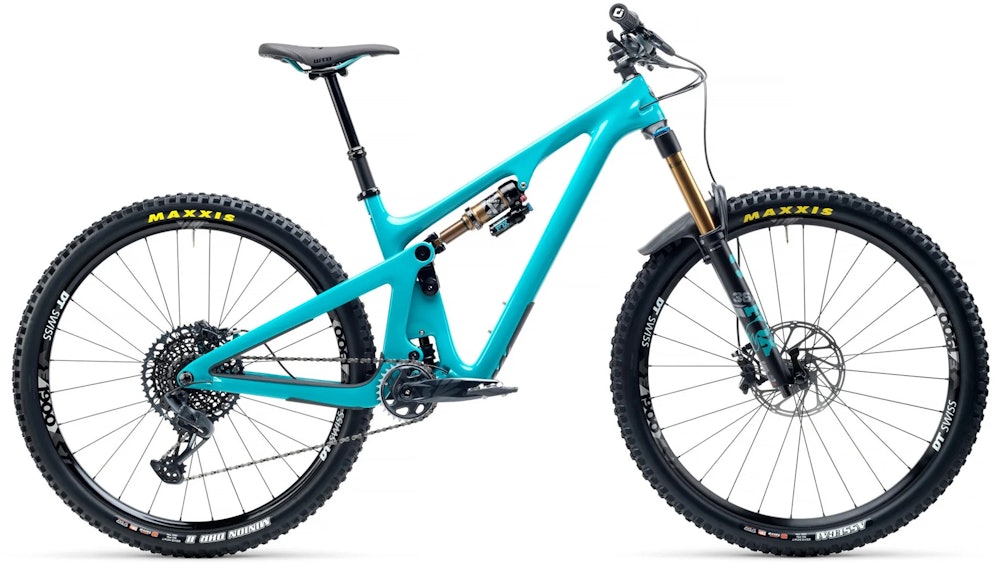
MSRP: $7,400 Jenson USA
This top-quality, versatile carbon all-mountain bike from Yeti will take you anywhere you want to go. Whether attacking flat desert terrain or rocky mountain passes, you’ll find the SB130 29er adapts to whatever you throw at it.
The C-Series Lunch Ride version of the Yeti SB130 features more capable geometry, tires, and longer-travel suspension.
With Yeti’s Switch Infinity suspension platform, this bike has super efficient pedaling and an almost bottomless feel.
Some standout components include the Fox Factory Float X 147mm shock, Factory 36 160mm travel fork, Fox Transfer Dropper, SRAM Code R 4-Piston, and Maxxis Assegai 2.5″ EXO+ and Minion DHRII 2.4″ EXO+ tires.
- Fork : Fox Performance 36 160mm travel
- Shock : Fox Performance Float X 147mm
- Drivetrain: SRAM GX Eagle 12-speed
- Frame: Carbon C-Series
Buy from Jenson USA
5 . Santa Cruz – Hightower 2

MSRP: $5,499 Evo.com
The Santa Cruz Hightower fits the needs of an advanced mountain biker and is one of the best-rated mountain bikes for trail riding.
The Hightower comes in aluminum or carbon frame versions, with SRAM gears, Maxxis tires, and high-quality suspension. The Hightower is on our list as it is considered one of the more capable bikes in its category.
The Hightower C R Kit features a carbon frame with VPP suspension and flip-chip tuning. It has 150mm of front travel on the Fox Yari RC and 145mm on the rear with a Fox Float DPS Performance shock.
- Fork : 150mm, Fox Yari RC
- Shock : 145mm, Fox Float DPS Performance shock
- Drivetrain: SRAM NX Eagle
- Frame: Carbon fiber
Buy on Evo.com
6 . Niner – RIP 9 RDO 2-Star
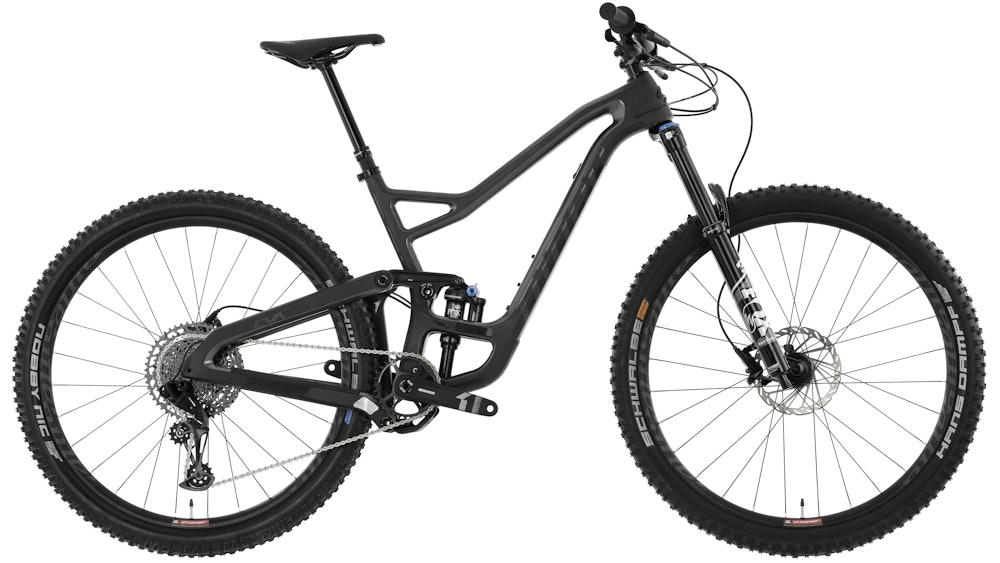
MSRP: $4,799 Jenson USA
The Niner RDO 2-Star is a high-performance trail 29er with a mid-range price. It comes packed with excellent technology like CVA suspension, full-sleeve internal cable routing, and an SRAM SX Eagle 12-speed drivetrain.
The RDO Carbon frame uses progressive and adjustable geometry that can handle a huge variety of trail scenarios. With 140mm of rear Fox Float X Performance EVOL 2 shock combined with a Fox 36 Float Rhythm fork the RIP 9 RDO 2-Star is the perfect bike for charging along singletrack and bouncing over rock gardens.
- Fork : Fox 36 Float Rhythm 150mm
- Shock: Fox Float X Performance EVOL 2 140mm
- Drivetrain: SRAM SX Eagle
- Frame: RDO Carbon
Buy on Jenson USA
7 . Juliana – Furtado

MSRP: $5,799 Mike’s Bikes
Juliana is one of the top mountain bike brands for women, having developed the first female-specific MTB back in 1999. The new 27.5″ Furtado is a carbon full-suspension trail bike with lower link suspension for better traction and a low center of gravity for stability. It’s built supreme maneuverability on all types of off-road terrain, whether you’re going downhill or uphill.
The Furtado benefits from RockShox Super Deluxe Select+ shock with a RockShox Pike Select+ fork that provides 140mm of travel. Combine this with SRAM G2 R hydraulic disc brakes and Maxxis Minion DHR 2.4″ tires and you get a MTB that closely resembles the excellent Santa Cruz Hightower.
- Fork : 140m, RockShox Pike Select+
- Shock : 130mm RockShox Super Deluxe Select+
- SRAM GX Eagle
- Carbon C frame
Buy from Mike's Bikes
8 . Revel – Rascal XT
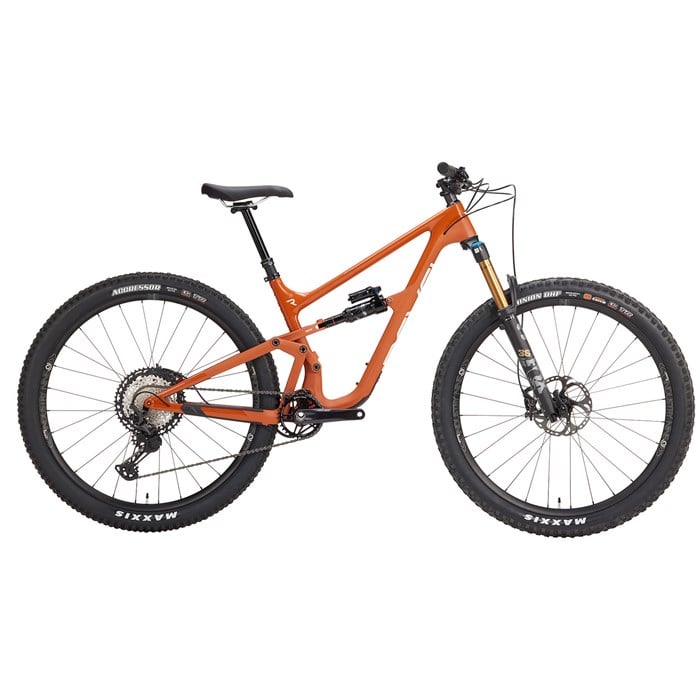
MSRP: $7,199 evo.com
For pro-level competitive riders, Revel mountain bikes have created the Rascal: a full carbon dream team of killer components and groundbreaking technology. For maximum pedaling efficiency, the Rascal’s Japanese Toray fiber frame utilizes the Canfield Balance Formula (CBF) to focus 100% of your power into the chainring, providing you with solid, stable speed over any terrain.
Add a RockShox Super Deluxe Ultimate shock and a Pike Ultimate fork, and the ground seems to melt away below while you float around corners and over obstacles with ease. This is all driven by Shimano’s podium-winning XT M8100 drivetrain and controlled by the solid XT 8120 hydraulic braking system. For the trail, all-mountain, or even enduro, you’ll struggle to find a better MTB than the Revel Rascal.
- Fork: 140mm Fox Float 36 Factory
- Rear Shock : 130mm RockShox Super Deluxe Ultimate
- Carbon fiber
Buy on evo.com
9 . Marin – Alpine Trail Carbon 2
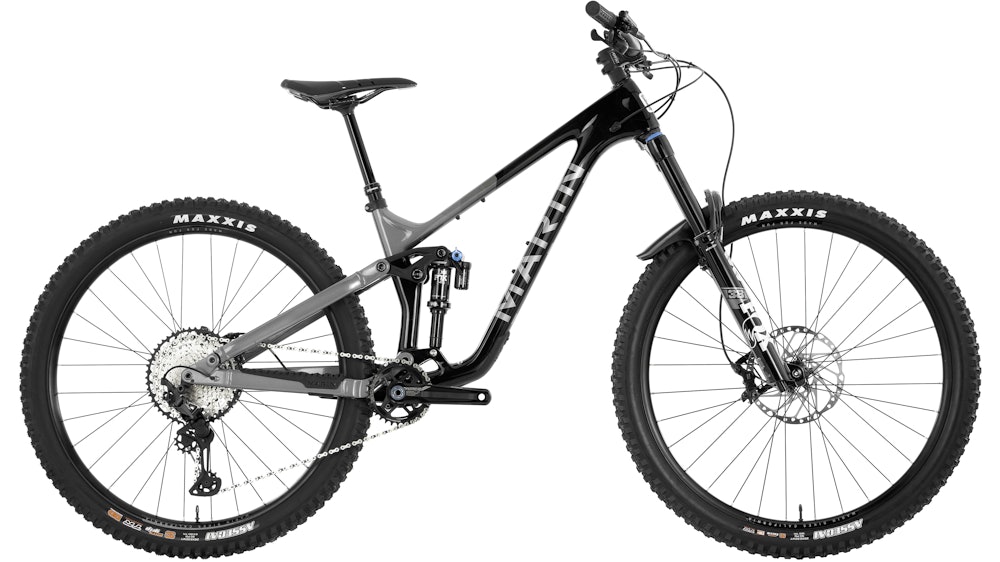
MSRP: $4,499 Jenson USA
Marin Bikes is a renowned mountain bike brand for those who like affordability and reliability from a MTB company.
The Alpine Trail Carbon 2 is the premium model of this 29er series, offering excellent climbing and descending abilities in one package.
Quality components include a 12-speed Shimano SLX M7100 groupset, a Fox 38 Performance Elite, 160mm fork, a 150mm Float X Performance shock, and Maxxis Assegai 2.5″ Maxx Terra/Assegai 2.5″ Maxx Grip tires.
With Marin’s proprietary MultiTrac suspension, you get a balanced platform that improves efficiency and bottom-out control simultaneously. When the aggressive geometry of the Alpine Trail is combined with high travel suspension, it makes for an adaptable all-mountain bike that can tackle every kind of ride.
- Fork : Fox 38 Performance Elite 160mm
- Rear Shock : Fox Float X Performance 150mm
- Frame: Carbon fiber front triangle, alloy rear triangle
10 . Transition – Sentinel X01
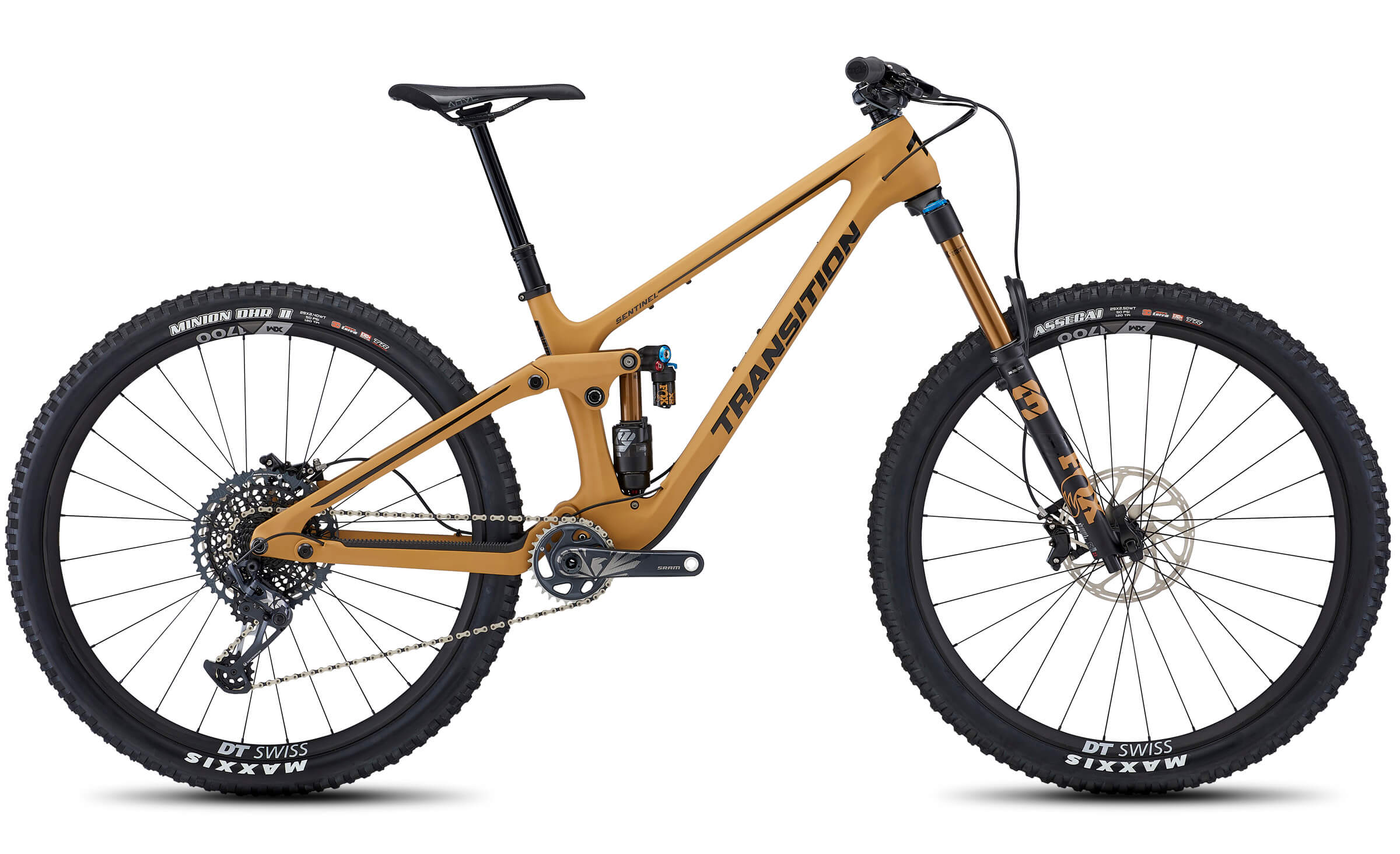
MSRP: $5,250 evo.com
This 29″ beast from Transition bikes pairs 150mm of rear with 160mm of front travel, putting it on the high-end of mid-travel MTBs. You’ll feel just as comfortable hitting jumps or tackling steep drops with this bike, as you will charging over rock gardens and along a single track.
It’s the perfect all-rounder and it comes in a range of builds, with drivetrains ranging from SRAM NX Eagle and Shimano Deore XT to the GX Eagle and SRAM’s top-quality X01. The top range X01 combines Fox Float suspension with SRAM Code RSC disc brakes, leaving you with nothing but confidence as the mountainside blurs past beneath you.
- Fork : 160mm, Fox Float 36 Grip 2 Factory
- Rear Shock : Fox Float X2 Factory 2-Position
- SRAM X01 Eagle
11 . Orbea – Occam H30
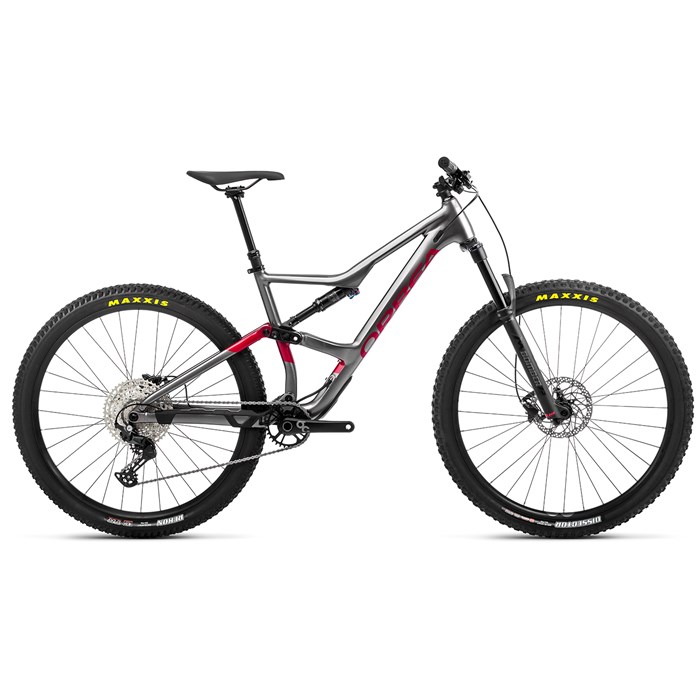
MSRP: $2.999 Jenson USA
The Orbea Occam is a high-performance MTB for a relatively low price, considering it boasts a hydroformed aluminum with a Shimano Deore groupset and high-quality suspension. You even get an OC MC20 dropper post and internal cable routing.
The lightweight setup makes for easy, all-day riding, and with 140mm of front and rear travel you can take on a variety of terrain. A broad gearing range takes the pain out of uphills, and solid Shimano hydraulic brakes make steep descents easy to control.
- Fork: 140mm, Marzocchi Bomber Z2
- Rear Shock : 140mm, Fox Float DPS Performance
- Shimano Deore 1×12-speed
Buy on JensonUSA.com
12 . Rocky Mountain – Instinct Carbon 50
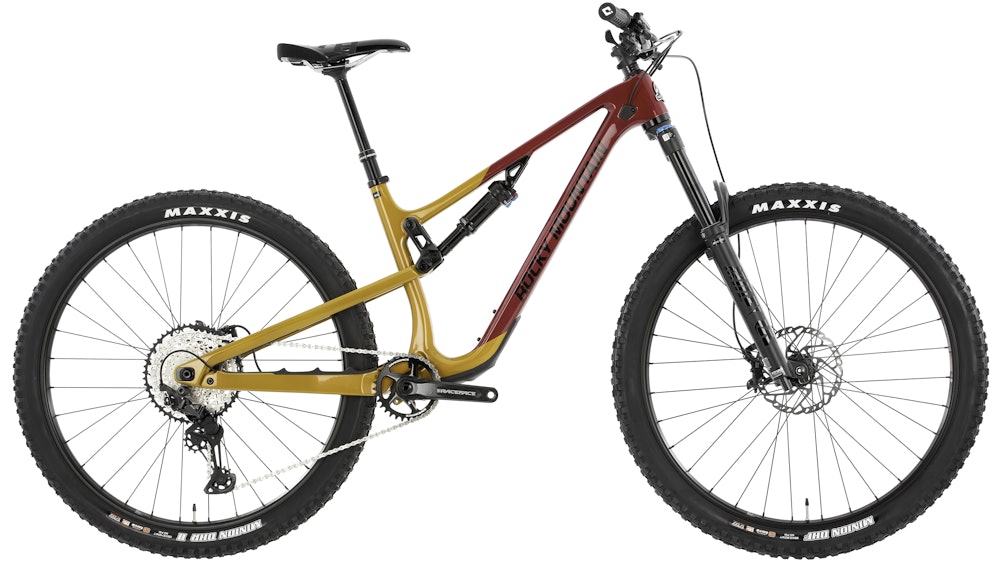
MSRP: $5,809 Jenson USA
For a top-quality and highly versatile all-mountain bike, look no further than the Rocky Mountain Instinct Carbon 50, with a Smoothwall carbon frame built to accommodate 29″ wheels.
Sure, it’s not the cheapest on the market, but with a 1×12 Shimano XT drivetrain and SLX 4-piston hydraulic brakes, we’d expect nothing less.
The lightweight frame uses Rocky Mountain’s RIDE-9 adjustable geometry, progressive sizing, and high-end suspension components for a premium trail feel.
Highlights of this bike include the Fox 36 Float Performance 150mm fork, Fox Float DPS Performance 140mm shock, Maxxis Minion DHF 2.5 and DHR II MaxxTerra EXO+ tires, and the smooth shifting XT drivetrain.
- Fork : 150mm, Fox 36 Float Performance
- Rear Shock : 140mm, Fox Float DPS Performance
- Drivetrain: Shimano XT
13 . Devinci – Troy C/A29 GX

MSRP: $5,419 Jenson USA
Devinci is a lesser-known bicycle brand that produces highly affordable MTBs and gravel bikes. The Troy 29er uses Split-Pivot suspension on a premium carbon/aluminum frame with 150mm of travel for a customizable feel with better compliance and traction.
As one of the best full-suspension bikes on this list, the Troy has surprisingly good front and rear suspension, supplied by Fox. It includes an adjustable Flip Chip for quick changing between Hi/Lo mode. The brakes are SRAM Code R four-piston hydraulic discs with Race Face AR35 Offset TR rims and Maxxis Minion DHF/DHR II tires.
- Fork : 150mm Fox Float 36 Performance GRIP
- Rear Shock : 150mm Fox Float DPX2 Performance Elite
- Drivetrain: SRAM GX 12-speed
- Frame: Carbon front triangle, aluminum rear triangle
14 . Diamondback – Release 3

MSRP: $4,100 REI
The Release is a 29″ Diamondback full-suspension mountain bike with an aluminum frame, providing a stiff and durable ride without raising the price too high. It rides on a top-quality Fox Performance Float setup with 140mm front and 130mm rear travel and Diamondback’s Level Link suspension platform, an ideal balance of speed and absorption. Additionally, a Shimano XT M8100 12-speed drivetrain offers tough components where you need them most.
No corners are cut on the wheels though, with Diamondback Blanchard running Maxxis Minion DHF/DHR 29 x 2.3″ tires, a combination that is well supported by Shimano XT M8100 hydraulic disc brakes. Overall, the Release is a killer trail bike that expertly keeps down costs without sacrificing quality, resulting in great value for money.
- Fork : 140mm, Fox 34 Performance Float
- Rear Shock : 130mm, Fox Performance Float DPX2
- Shimano XT 12-speed
- Aluminum frame
Buy on REI.com Buy on GovVelo.com
15 . Marin – Rift Zone

MSRP: $1,899 Jenson USA
The Rift Zone is a highly affordable MTB from Marin that combines impressive frame design with reliable components. On the frame, you get stiff, lightweight Series 3 6061 aluminum with Boost spacing, has ISCG05 tabs, and internal cable routing.
- Fork : 1RockShox Recon Silver RL 130mm
- Rear Shock : X-Fusion O2 Pro R, Custom Tune 120mm
- Shimano Deore, 11-Speed
With a balanced 130mm of front and 120mm rear travel from RockShox and X-Fusion, you will be able to descend with ease. Shimano BR-MT200 hydraulic disc brakes and a high-ratio Shimano Deore11-Speed drivetrain ensure you won’t struggle to keep up with the best out there. You don’t need to be a genius to know that this bike offers excellent value for money.
Buy on Jenson USA Buy on GovVelo.com
16 . Yeti – SB140 TLR T2

MSRP: $9,100 Jenson USA
A pro mountain bike for pro riders, the Yeti SB140 TLR T2 is as much a mouthful as it is a bike packed full of features. Hop on and feel the ground smooth out before you as the Fox Factory suspension swallows up vibrations and the SRAM X01 drivetrain powers you forward without faltering.
- Fork : 160mm, Fox Factory 36 GRIP 2
- Rear Shock : Fox Float X Factory
- TURQ-series Carbon fiber
With a huge 160mm of upfront travel, you’ll have no trouble taking on big jumps or steep drops, with a Fox Factory Transfer dropper seat post giving you the space you need. The stiff SB140 carbon frame complements low-slung stability with an aggressive 65-degree head angle, resulting in a fast and fun all-mountain trail bike that excels in extreme conditions.
17 . Evil – Following LS
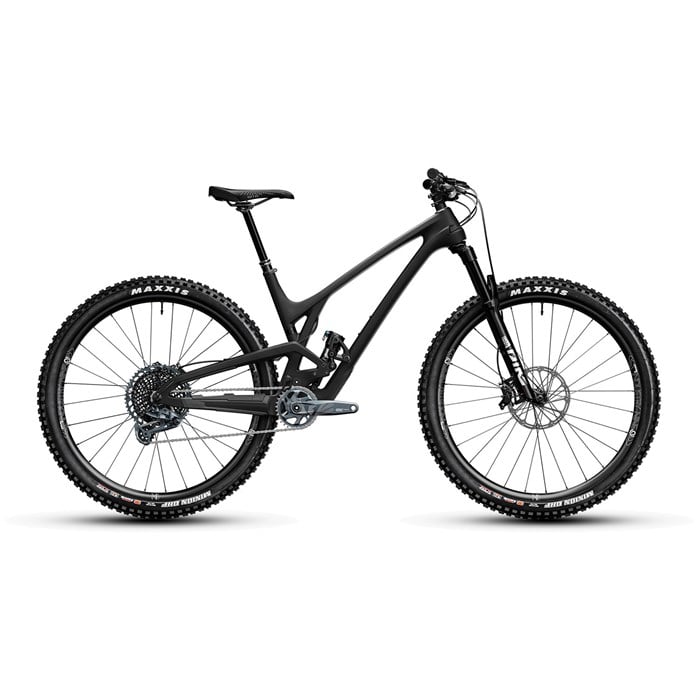
MSRP: $6,450 Evo.com
Evil is one of those underrated mountain bike brands that seldom fail to impress. The carbon-framed Following comes in various groupset flavors , with the one pictured featuring SRAM GX Eagle running a 12-speed drivetrain with SRAM G2 RS disc brakes and RockShox suspension.
- Fork: 130mm Rockshox Pike Ultimate Charger 2 RC2
- Rear Shock : 121mm RockShox Deluxe Ultimate RCT
It’s an agile 29″ trail charger that can tackle rough terrain with a decent 130mm of upfront travel on a RockShox Pike Ultimate fork. The bike has a fun feel to it, bouncing along with confidence and just an edge of excitement. With this setup, the Maxxis Minion DHF tires work especially well wrapped on Industry Nine Enduro S rims.
18 . Cannondale – Habit 4

MSRP: $3,025 REI
The Cannondale Habit 4 29er is a burly trail machine designed with speed in mind.
A RockShox 35 Gold RL 140mm fork and Deluxe Select+ 130mm shock allow for some aggressive riding, while the progressive geometry and Proportional Response design make for a consistent ride across the sizes.
- Fork : RockShox 35 Gold RL 140mm
- Rear Shock : RockShox Deluxe Select+ 130mm
- Drivetrain: SRAM SX Eagle 12-speed
- Frame: Aluminum
Both the SRAM SX drivetrain and two-piston Shimano disc brakes are great parts that are trail-proven. The slack geometry and Maxxis Minion DHF 2.5″ and Aggressor 2.4″ EXO tires also make it easier to tackle chunky terrain with confidence.
Buy on REI.com
19 . Ibis Ripley XT

MSRP: $6,999
Ibis has long been touted as one of the best mountain bike brands worldwide and its flagship Ripley XT carbon trail bike hammers home that truth with a premium component list and ultra-light design.
With 130mm of front and 120mm of rear travel, supported by DWLink suspension and V5 Kinematics, the Ripley is the perfect carbon trail bike.
- Fork : Fox Float 34 Factory Series, 130mm Travel
- Rear Shock : Fox Float 34 Factory Series, 130mm Travel
- Drivetrain: Shimano XT M8100 Shadow Plus
The steep 76-degree seat tube and high ratio 1×12 Shimano XT drivetrain make hill climbing a cinch, while the XT M8120 4-piston disc brakes combined with thick Maxxis DHRII/Dissector 29 x 2.4″ tires ensure descents are safe and nimble.
Notable extra details include internal cable routing and an ISCG mount plus a polycarbonate downtube protector.
20 . Norco – Sight A1

MSRP: $5,599 Jenson USA
The Norco Sight A1 is a 29er aluminum bike fitted with premium RockShox suspension and designed with Norco’s Ride Aligned Design System for exceptional ride characteristics. This bike has excellent climbing and descending capabilities.
- Fork : RockShox Lyrik Ultimate RC2, 160mm
- Rear Shock : RockShox Super Deluxe Select+ RT, 150mm
Norco bikes produced the Sight with ease in mind, so you can spend longer in the mountains supported by a 12-speed a SRAM GX Eagle 12-speed drivetrain should power run low. Additionally, Maxxis Assegai and Dissector tires and SRAM Code RSC four-piston hydraulic disc brakes keep you in control at all times.
21 . Santa Cruz – 5010 5 C R

MSRP: $5,300 Mike’s Bikes
The 5010 5 C R from Santa Cruz Bicycles is a powerful trail bike designed for agility and speed. This bike benefits from pure MTB DNA from Santa Cruz, with a lightweight Carbon C frame that tears through the countryside, powered by a high ratio SRAM NX Eagle 12-speed drivetrain and Guide T hydraulic disc brakes.
- Fork : RockShox Pike Base, 140mm
- Rear Shock : Fox Float Performance DPS 130mm
- SRAM NX Eagle
Utilizing Santa Cruz’s proprietary VPP suspension link system, this bike rides like a high-end bike. For any adventurous rock hoppers out there, you get 140mm of front and 130mm of rear travel to absorb the impact of those particularly courageous maneuvers.
Charge along with confidence knowing your innovative suspension system and Maxxis Minion DHR II tires will ensure you stay on track.
Buy on Mike's Bikes Read Our Full Review
22 . Devinci Marshall
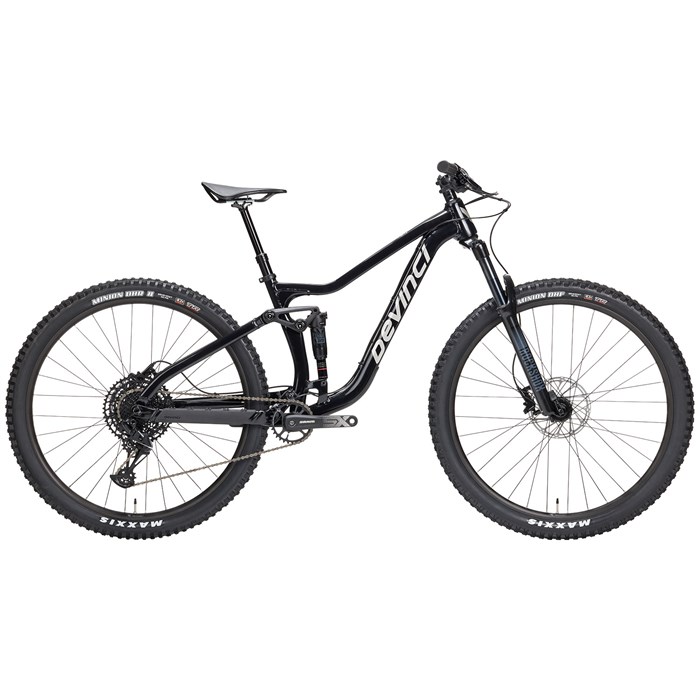
MSRP: $2,649
The Devinci Marshall is a serious alloy beast with more to give than you could read from the specs.
Besides having all the boxes ticked to conquer the rough and smoother trails with ease, what stands out the most is the mixture of solid mid-range components from TranzX dropper seat post, Maxxis Minion tires, and of course, the SRAM SX Eagle derailleur.
Finally, the bike comes with an 11-50t cassette and SRAM’s Level T precise hydraulic disc brakes that will stop you on a dime.
- Fork – RockShox 35 Silver TK SoloAir
- Rear Shock – RockShox Deluxe Select R Debonair
- Aluminum Optimum G04 Frame
- SRAM SX Eagle 12-speed drivetrain
Buy from evo.com
23 . Norco – Fluid FS 1
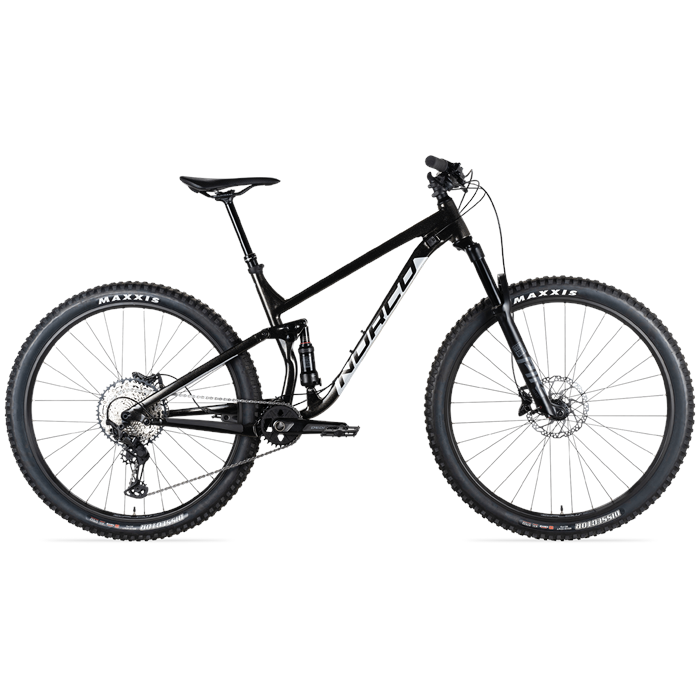
MSRP: $3,399 Evo.com
The Norco Fluid FS 1 is an affordable trail bike that combines a dependable Shimano SLX/XT drivetrain with a supple RockShox Pike Select 130mm fork, Deluxe Select 120mm shock, and aluminum frame.
The design of spec of this bike results in respectable performance without breaking the bank. It’s a great intermediate full-suspension bike for trail or XC riding without any extreme jumps or drops.
- Fork : RockShox Pike Select 130mm
- Rear Shock : RockShox Deluxe Select 120mm shock
- Drivetrain: Shimano SLX/XT 12-speed
Norco’s progressive design and modern trail geometry lend to this bike’s playful and confident trail performance. It has the perfect amount of suspension to ride comfortably along rocky singletrack and mountainous trails without swallowing up all your power.
Buy from Evo.com
Buying Guide

Ibis Ripmo – Big Wheel, Big Travel Speed Demon. What’s great about this bike is that Ibis Cycles manufacturers their own set of 29″ carbon wheels that can accomodate tires up to 2.8″ in width. “
What to Expect & How to Choose?
Trail bikes have quickly become the most common form of full-suspension MTBs, designed to tackle all forms of terrain while maintaining comfort over a long distance. Trail bikes fall between XC and Enduro bikes, offering sufficient downhill handling while retaining speed over flatter sections.
They usually have a seat tube angle in the 74-75 degree range, with shorter chainstays and longer reach. Travel ranges from as little as 120mm all the way up to 160mm, with both 29″ and 27.5″ wheel sizes popular.
You should consider your style of riding before selecting a mid-travel MTB. While they all have similar characteristics, the type of riding you intend on doing will define how much travel is ideal.
Suspension Travel
If you enjoy charging downhill or attempting small jumps, you’ll want to choose something in the higher travel range . If you prefer racing along bumpy off-road or gravel tracks at high speed, aim for something in the lower travel range .
Wheels & Tires
Other points to consider include wheel and tire size. Larger 29″ wheels are better for speed and absorption, whereas the small 27.5″ wheel size is more agile on downhills and sharp corners. 2.5″ width is somewhat average, while 2.8″ is considered as wide.
Different MTB Disciplines
Xc vs. trail.
Cross-country (XC) is generally considered the most traditional mountain bike style with the most versatile usage. Hence the name, Cross-Country Mountain Bikes can handle all types of terrain from smooth singletrack and gravel roads to rocky trails and technical mountain tracks.
XC mountain bikes typically have a shorter wheelbase for agility and steeper geometry for easier hill climbing. Head angles are in the range of 69-71 degrees, with seat tube angles between 74-75 degrees. They usually have the lowest amount of travel, from 90-100mm , and 29″ wheels for a faster, stiffer ride.
>>> Related: Best Short-Travel Mountain Bikes (100-130mm range)
Trail/All-Mountain vs. Enduro
Enduro bikes attempt to combine aggressive downhill geometry with uphill climbing ability, resulting in a bike that can tackle highly technical courses over varied terrain.
They typically have the longest, lowest, and slackest geometry of all MTB styles, making them less comfortable over long distances, but also more versatile. They are both stable on downhills and powerful on ascents, with suspension in the 150-180mm range and tires from 2.3″ to 2.8″ thick.
>>> Related: Best Enduro Mountain Bikes (150-180mm range)
27.5″ vs. 29″ – The Endless Debate
Mountain bike wheel sizes have become a hot topic recently, after years of 26″ wheels dominating the market. Since the 29″ wheels began gaining popularity in the mid-2010s, manufacturers began experimenting with different wheel sizes, introducing the mid-sized 27.5″ or also known as the 650b wheel size. Nowadays, almost all MTBs use either 29″ or 27.5″, with subtle but noticeable differences between the two. You’ll still find 26″ wheels on smaller frame sizes on some models.
- Being larger, 29″ wheels are better for taller riders and while they offer less acceleration, they have better traction and attack angle which eventually means better speed .
- 27.5″ wheels are faster and lighter , with better maneuverability and greater versatility .
27.5″ MTB wheels are also known to have the availability to fit wider tires of up to 3″ in width, while the standard max clearance for 29″ tires is 2.6″
>>> Related: Best Mullet Mountain Bikes
Which are the best mountain bike brand on this list?
Ibis, Yeti, Santa Cruz, Revel, Transition, and Evil are some of the boutique-type brands in the MTB business, while Salsa has the most models available. Cannondale has also done a great job providing online shoppers with a variety of mountain bikes from their fleet.
What is the best all-mountain bike?
The different types of mountain bikes might confuse most riders, but it isn’t actually as confusing. An all-mountain bike is basically built 70% for ascending and 30% descending, making it a few notches harder to ride than the regular trail bike.
Do you need the rear suspension lock-up switch?
Climbing is a part of mountain biking, and if you tend to be the climber who climbs while seated, a rear suspension-lock-up switch might be useful for you. The switch works wonders on longer-travel bikes with slacker geometry, while you’ll generally see the switches on higher-end models.
Where to buy trail and all-mountain bikes?
These are the best online bike shops to buy mountain bikes online
Mike’s Bikes Awesome set of high-end and mid-range mountain bikes, both full-suspension and hardtail
JensonUSA Obviously one of the more known stores that will fix you up a good deal
Evo.com Bikes & frames by the best brands available
GravityCoalition You can find pretty sweet last-size deals there on full-suspension and eBikes as well.
REI Cannondale, Co-op Cycles, and Salsa mountain bikes are represented.
Share this on:
About the Author

Mark Hartley
One thought on “ best trail & all-mountain bikes (130-160 mm travel) ”.
How come no Banshees on this list?
Leave a Reply Cancel reply
Your email address will not be published. Required fields are marked *

Trail Bikes: Short vs Long Travel
Q: Other thoughts?
Noah : Travel is there for three reasons. The first is to keep you in control over rough terrain. You don’t really need much travel for that on the vast majority of trails out there, particularly those of the newer, smoother variety.
The second reason is to reduce fatigue over long rides. Again, you don’t need all that much travel to achieve this end.
The third reason is that (whether they’ll admit it or not) lots of people—myself included—like more travel because it masks mistakes. Line choice on a rigid bike means placing your tires in the exact right place at the exact right time. Line choice on a 160mm-travel bike means casually avoiding obstacles that can appropriately be described as “trees” and “boulders,” and otherwise pointing it straight. Any idiot can flounder down a moderately technical trail on a long travel bike. You can run into stuff and it just doesn’t matter.
Some people make a lot of mistakes because they’re pushing their limits and pinning it. Some people make a lot of mistakes because they pretty much just suck at riding a bike.
People in either of those categories can have a bunch of fun on long travel bikes. They just have to balance their love of blowing past mistakes with their willingness to drag a relatively heavy, relatively inefficient bike uphill.
I’d also add that there’s an ever changing dynamic of bike geometries, bike travel, and trail styles. It used to be that bikes were steep, tall, didn’t have much travel, and the trails we were riding were more likely to be slow and techy. Now there’s lots of “flow” trails getting built that are much faster, much less technical, and favor a shorter travel, lower, slacker bike.
Popular bike designs, including geometry and travel classes, have a direct relationship with the trails people are riding. As trail design evolves (whether for the better or the worse, depending on your preferences), so too do the bikes. That’s why lots of people are trending towards shorter travel bikes with modern geometry, and also why the few bastions of technical riding (British Columbia, parts of Utah, etc.) still have a disproportionate number of longer travel bikes.
Marshal : Many people seem to care about the things which are least important to me: travel and geometry.
For a long time, geometry and suspension quality totally sucked, and finding a bike that worked properly was really hard, and it was easy to discard most bikes on the market and find one bike purely off those two statistics.
Modern suspension is so good, you just don’t need as much travel as once required, and geometry has finally caught up as well.
For me and where I ride, it has been all about minimizing the last year or so: what is the least travel, best pedalling, most controlled yet fully active rear suspension? What are the fastest rolling and lightest tires that don’t compromise on traction or durability? What is the most efficient pedalling position that does not give up handling on the down?
In my opinion, here’s a great example: The EWS is elite pedal-accessed multi-stage timed downhill racing. Those cats are on 140-160mm rear travel bikes. In my estimation, unless you are pedal accessing real deal downhill trails and riding them with very fast speeds, most people just don’t need a bike that big. You are way better off (a) getting an appropriately efficient bike so you can ride more vert in a given hour or two, and (b) learning the required skills to shred on it.
Tom : As Noah and Marshal describe, how and where you ride matters a lot. Riding precision can make up for travel, and smooth trails don’t benefit from excess travel. Conversely, sloppy riding and/or rough trails often benefit from every millimeter of travel available.
To that end, long and short travel bikes can provide a great way to handicap riders and level the playing field. Intermediate riders will likely be able to ride more challenging terrain if they are put on a longer travel bike. An advanced rider can squeeze more fun out of easy trails by riding a shorter travel bike that requires them to more carefully and precisely choose lines through rough sections.
The one thing I haven’t discussed yet is my belief that wheel size matters a lot. I find that with 29” wheels I don’t need as much travel to monster truck over rock gardens. The bigger wheels smooth out the trail enough to negate the need for quite as much travel. Very unscientifically, I’d put them down as equal to 10-20mm of suspension travel.
If you haven’t spent time on a short travel bike in a while, do it. It reveals any bad habits you’ve developed and can make old trails exciting again. If you haven’t ridden a long travel bike, get on one and ride some hard trails, you may surprise yourself.
Variety keeps biking fun. Don’t get too set in your ways.
8 comments on “Trail Bikes: Short vs Long Travel”
Suspension tuning and style wasn’t mentioned much. I’m not an expert tuner or anything, but even with flipping through dials and playing with air pressure, bikes, just like skis, do tend to have a certain personality of sorts. For example, lively, poppy and playful vs plush, stable and planted. For example, I found SB66s to feel more like the former (and skittish) and Nomads to feel more like the latter (and sluggish). Some of this could be geometry, but I think suspension characteristics are definitely playing a large role in the personality of the bike. I’m surprised this wasn’t mentioned by anyone. As an aside, I think shorter travel bikes are better suited towards the former, and longer travel bikes better suited towards the latter. I haven’t really looked at 275ers, mostly because they seem like a really poor allocation of my dollars with so many good 26ers going for dirt cheap (2 good bikes for the price of 1 mediocre, anyone?).
Really enjoyed this article. Great insights all around. I’m just going to need to convince the wife that I need a minimum of 3 mountain bikes. I’m sure it will go over great (haha). Lindahl, they actually have multiple articles on suspension including one that goes into a decent amount of depth on tuning your ride. Just go back to mountain biking 101 and you can find all the links there. Completely agree with your comment on the low prices of 26ers – unreal.
I’ve basically been in cryo-storage for the last decade as far as mountain bikes are concerned so this might be a question with an obvious answer but why aren’t there more long travel 29ers out there? I recently bought a Niner WFO and while I’m very happy with my purchase, there definitely isn’t the same level of selection in this category as there is in the LT 650b category. For instance, why doesn’t Santa Cruz make a 29er version of the Bronson? Is this a VHS / Beta question where one type of frame won the day “because”? Did these bikes initially come out and no one bought them? Are long travel 29ers the mono-skis of mountain biking? I’m obviously missing something. Interested in your thoughts. Thank you!
When I first got onto a 29er this summer, my thought was that bigger wheels are to mountain biking what tip rocker is to skiing: they make the sport easier to do and therefore more accessible, more fun, etc. They’re not better than smaller wheels in every situation but in places where greasy roots and steep technical trails are common, I would imagine most riders would be happier on bigger wheels than smaller. So, when I started looking around for a new bike I was expecting to find lots of companies adopting them, across the spectrum of bike types, especially on enduro bikes. But what I found was that it’s mostly XC / trail bikes with less aggressive geometry and shorter travel (Santa Cruz Tallboy, Trek Remedy, Scott Spark, etc.) that have adopted 29″ wheels while the popular enduro (aggressive, long travel) bikes from Santa Cruz, Pivot, Devinci, Yeti, Norco, etc. are all 650b/27.5 – why is this? Maybe it’s because relatively short travel but aggressive 29ers like Evil’s The Following are facilitating the same kind of riding experience a LT 650b/27.5″ bike does (i.e. you don’t “need the extra travel because of the bigger wheels… but since when does that line of thinking apply to mountain bike manufacturers)?
Being short at 5’8″ and the lack of longer travel 29ers ruled wagon wheels out for me. I don’t buy the argument that the bigger wheel make up for 20mm of travel. Travel is travel. The real reason you don’t see long travel 29ers is that your already higher on them so longer travel would negativity impact the handling of the bike and create geometry issues. 140mm 27.5 hits the sweet spot for playful trail riding for me personally. I don’t care for flowy groomed trails so xc short travel bikes aren’t for me.
One more vote for the importance of the trails you ride: Sure, langer travel bikeswap with slacker head angles climb very well these days. So, out in the big mountains, you climb for 2 hours, then rip a sustained descent for 45 minutes, that’s a great set-up
On our Midwestern trails, much of the distance of a trail is spent on short rolling hills. Having a bike that is lively pedaling out of the saddle on a short rise, having geometry that is nimble for the tight turns at slower speeds on the flats, and having firm suspension to pump every little feature, even on the uphills, makes that bike a lot more fun on these sort of trails.
So I’d argue there IS STILL a penalty for longer travel, slacker bikes.
Great article, give me more insights. Written well. We need more article like this in different subjects Thanks
Beeson, I am just under 6′-0″ and I feel that the 29ers with long travel are just way to Tall. I do not like to maneuver on stilts, and I would need a Medium with 29 and anything over 130 mm travel. also at some point the suspension will tweak, bind, or feel like it is hanging up as you are flicking around corners or clipping rocks. I tend to use my dropper any time I see Technical or tight turns, and the high profile only helps for pedal strikes… not confidence in riding my outside lugs. We need a lower center of gravity without grinding down front cogs.
Leave a Comment Cancel reply

7 Best Trail Mountain Bikes of 2022
For versatile bikes that can tackle long climbs and moderately technical descents, we break down the year’s top trail models.
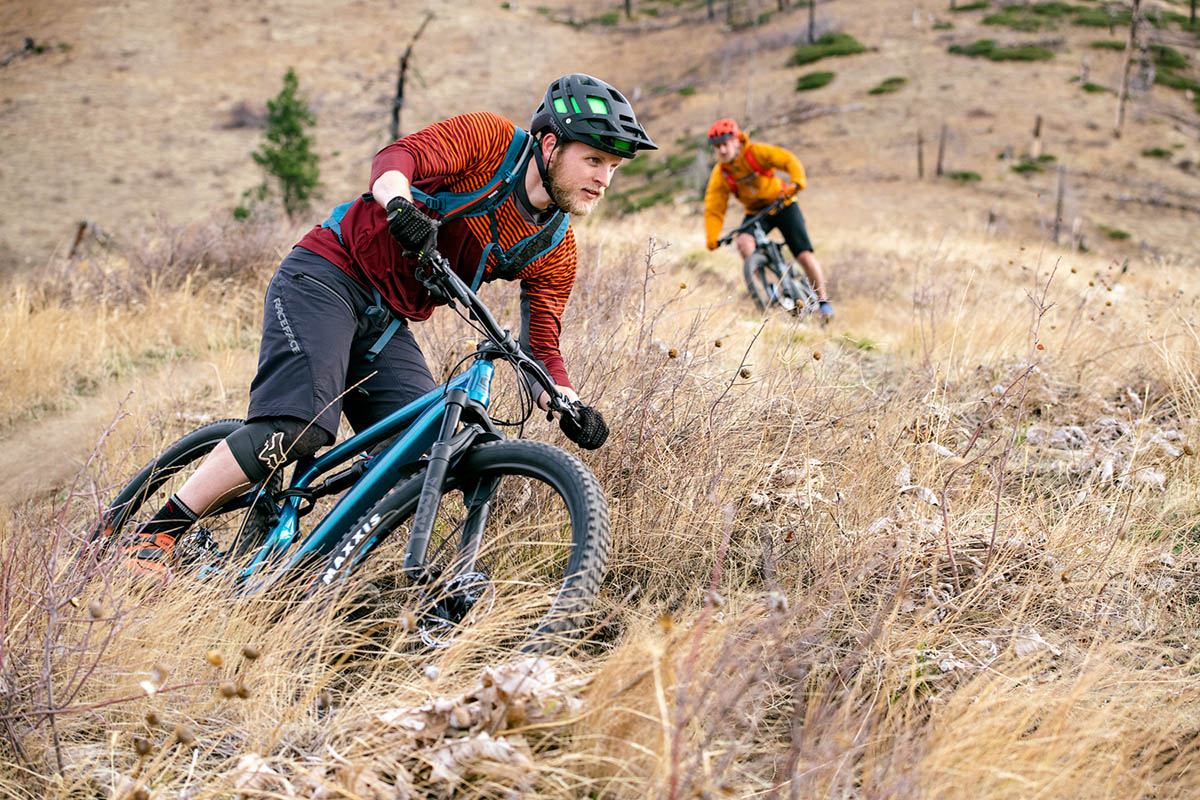
Switchback Travel ( Jason Hummel )
We use affiliate links and may receive a small commission on purchases. Read more about us .
From smooth and flowy post-work rides to rough and rowdy all-day backcountry epics, the trail mountain biking category covers a wide range. And with rapidly changing technology and an ever-growing number of options, it can be hard to nail down the best ride for your needs. Below we detail our top seven picks for 2022, which are broken down by type and best use and include everything from a beginner-oriented hardtail to fast and fun full-suspension rigs. For more, see our buying advice and comparison table below the picks.
Our Team's Trail Mountain Bike Picks
- Best Overall Trail Mountain Bike: Yeti Cycles SB130
- A Close Second (For Rougher Terrain): Ibis Ripmo V2
- Best E-Mountain Trail Bike: Specialized Turbo Levo Comp
- Best Hardtail for Trail Riding: Salsa Timberjack XT 29
- Best Budget Full-Suspension Trail Bike: YT Jeffsy Core 2
- Best Short-Travel Trail Bike: Evil The Following
- Top Entry-Level Trail Bike for Beginners: REI Co-op Cycles DRT 1.1
Best Overall Trail Mountain Bike
1. yeti cycles sb130 c2 gx eagle ($6,500).
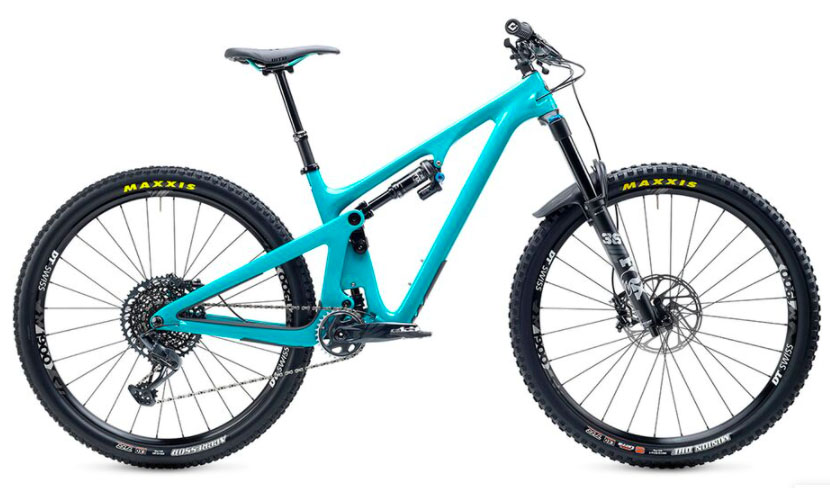
While we readily admit that the term “quiver killer” is overused, we can’t help but think Yeti made just that with the extremely versatile SB130. Sporting 150-millimeters front and 130-millimeters rear travel, it falls nicely in the heart of the trail category, and its progressive geometry and plush suspension mean it’s planted and composed when tackling technical trails. Just as importantly, it’s an efficient climber and has a very light and playful personality that’s a ton of fun on flowy and smooth sections (unlike some burly bikes, it’s not overkill on easier terrain). Finally, the SB130 is impeccably built and easily one of the best-looking bikes around, sporting Yeti’s famous, turquoise-colored frame (the “Brick” color option isn’t too shabby either).
The main knock against Yeti bikes is that they’re not great values, and this mostly holds true for the SB130. Their “entry-level” model rings in at $6,200, and the lightly upgraded GX Eagle variation here comes in at a steep $6,500. That said, Yeti sticks to high-end parts, and when spec’d the same, its pricing actually is quite close to competitors like the Ibis Ripmo and Santa Cruz Hightower. And with the premium price, you’re getting some nice extras, including a lifetime guarantee against defects on the frame and a crash replacement warranty where they’ll offer you discounted replacement parts. All told, the Yeti’s do-it-all nature earns it our top spot for 2022. See the Yeti SB130 C2 GX Eagle
A Close Second (For Rougher Terrain)
2. ibis ripmo v2 slx ($6,099).
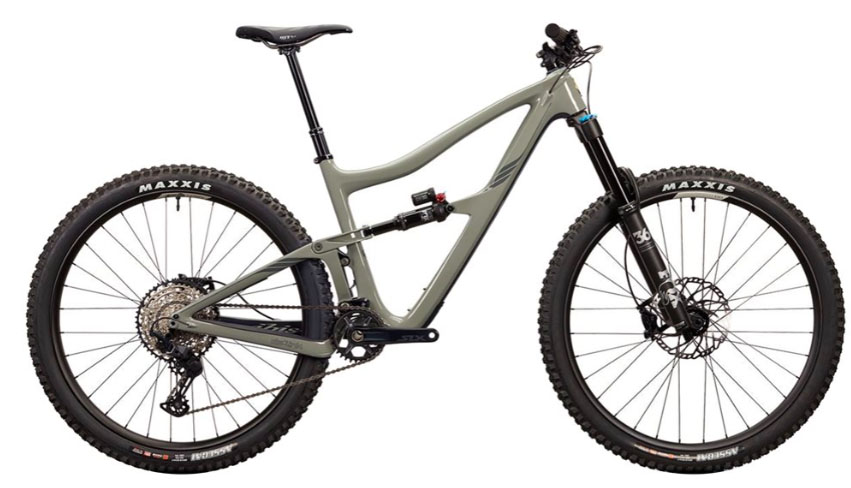
If you live in an area like the Pacific Northwest and your local trails are filled with rough and steep terrain, or you simply want a cushier ride for absorbing big hits, it’s hard to beat Ibis’s latest Ripmo. Stepping up in aggressiveness from the Yeti above, you get an extra 10 millimeters of travel at the front and 17 millimeters at the rear, along with a slacker head angle and burly Maxxis Assegai tires. There’s even an option to select a coil shock if you plan to dabble in the enduro world. What makes the Ripmo a favorite among trail riders, however, is its do-everything performance. The steep seat tube and DW-Link suspension make it out-climb expectations, and the carbon frame and quality Shimano SLX groupset help keep weight in check.
Combining 29-inch wheels and a lot of travel does mean the Ripmo is overkill for flatter, flowy, and less technical trails. And while it’s energetic and happy to pop off features along the way, it’s realistically more bike than a good number of trail riders actually need. As such, it comes up a little short of the slightly more versatile and better-climbing SB130 above. Plus, we think the Yeti is a bit more refined—the Ibis’s internal routing needed a little work to keep from rattling, as one example—and the styling of the Ripmo does leave a little to be desired (although that’s subjective). Of note, Ibis covers both ends of the trail category really well, and their lighter and snappier Ripley is a top choice among short-travel options. See the Ibis Ripmo V2 SLX
Best E-Mountain Trail Bike
3. specialized turbo levo comp alloy ($7,500).
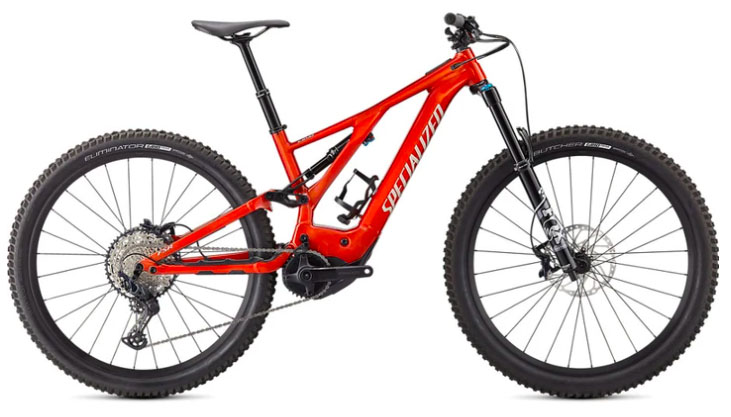
Specialized has been at the forefront of electric mountain bikes in North America, and their Turbo Levo is a leading all-mountain design. The latest bike is a real grin-maker—trust us on this one—and received a host of improvements that set it apart. Its new mullet setup (29 in. wheels at the front, 27.5 in. at the back) gives it a balanced and easy-to-control feel but still can smash through technical terrain, and its electronics have seen a nice upgrade in durability and refinement. Further, their Mission Control App provides quick access to the battery’s status and allows for easy customization of performance. Overall, among a fast-growing and competitive field of e-mountain bikes, we think the latest Turbo Levo is at the top of the list.
Currently, the biggest barrier to an e-mountain bike of any kind is price. Despite packing an aluminum frame, the Turbo Levo Comp here is $7,500, and carbon models start at a whopping $9,000. Additionally, the extra drive system adds a significant amount of weight–it’s not uncommon for e-bikes to weigh upwards of 50 pounds or more. This added heft also has performance drawbacks, and we found the Turbo Levo is quite a bit less flickable and more reluctant to get off the ground than the brand’s analog Stumpjumper Evo (or the less-powerful Levo SL e-bike). Finally, land managers and lawmakers still are trying to figure out where e-bikes fit into outdoor recreation. Regulations vary by state and riding area, but oftentimes they technically are not legal to ride on singletrack trails. See the Specialized Turbo Levo Comp
Best Hardtail for Trail Riding
4. salsa timberjack xt 29 ($2,099).
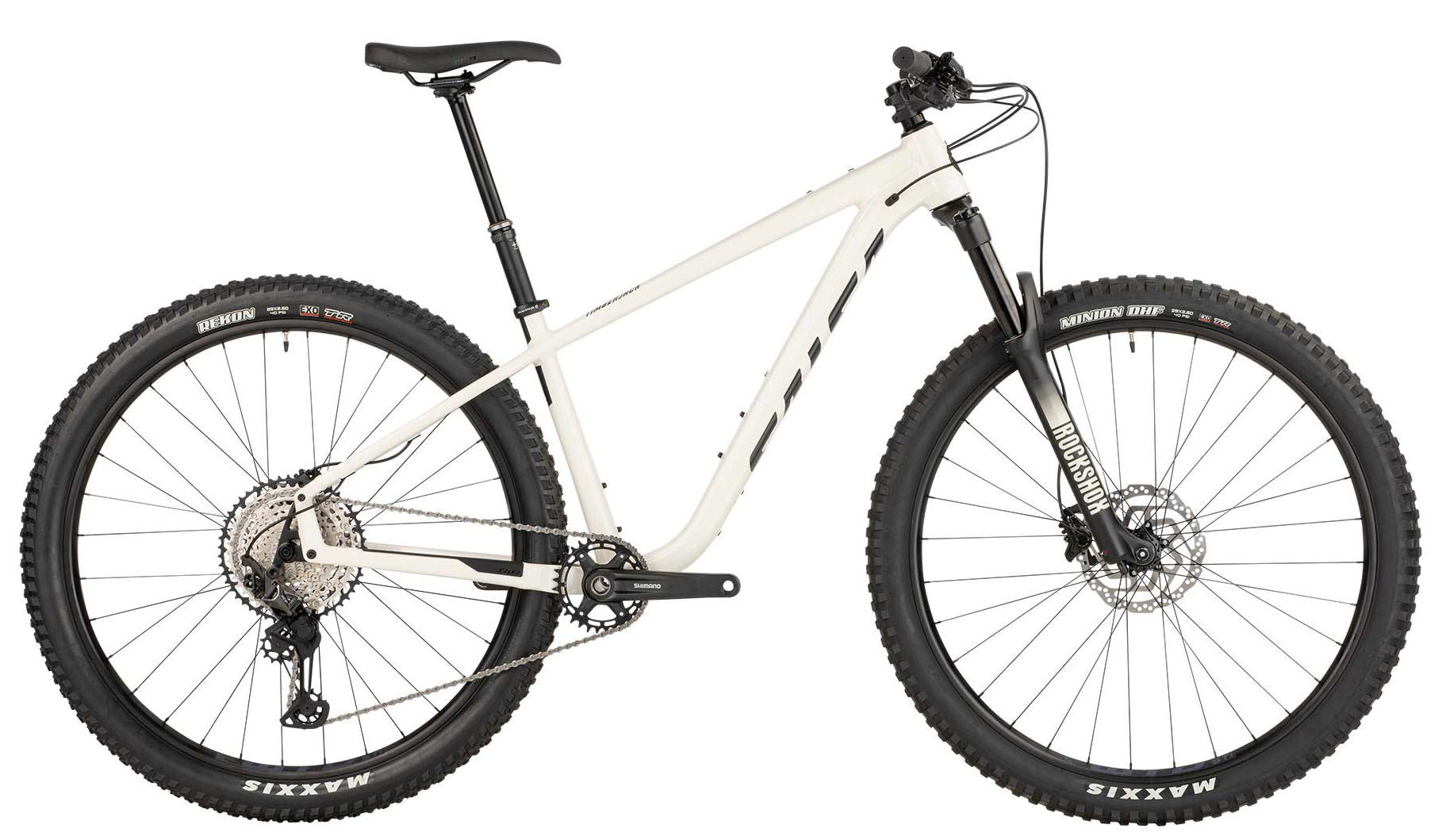
Minnesota-based Salsa Cycles is best known for their bikepacking, touring, and gravel-oriented designs, but they’ve been making some serious headway in mountain biking of late. Their Timberjack XT 29 hardtail is case in point with its well-thought-out spec package and adaptable design. The bike’s burly 2.6-inch tires and highly adjustable 130-millimeter RockShox 35 Gold RL fork provide more than enough cushion for rocky and rooty descents (by hardtail standards). And the relatively slack geometry and fast-rolling tires encourage shenanigans like popping off trailside lips and manualing down the trail. What we really like about the Salsa, however, is its nod to bikepacking. You simply won’t find too many other hardtails that offer as many mounting locations for gear as the Timberjack.
Salsa updated the Timberjack last year, and key changes include a slacker head tube (66.4° on all sizes) and an impressively expansive number of build kits (including 27.5+ wheel sizes). The 29er XT model here features premium components like Shimano’s XT drivetrain at a reasonable price point. The design offers fast and reliable shifting—it even smooths out shifts that would otherwise clunk into place while on an incline—and its 12 speeds have a very wide range. This gives the Timberjack excellent versatility for hauling you up extended climbs and over variable terrain. That said, the burly construction and wide tires mean the bike isn’t as nimble and fast as a more cross country-focused design. But for a capable and well-rounded hardtail that’s built to last, the Timberjack is an excellent choice. See the Salsa Timberjack XT 29
Best Budget Full-Suspension Trail Bike
5. yt jeffsy core 2 ($2,999).
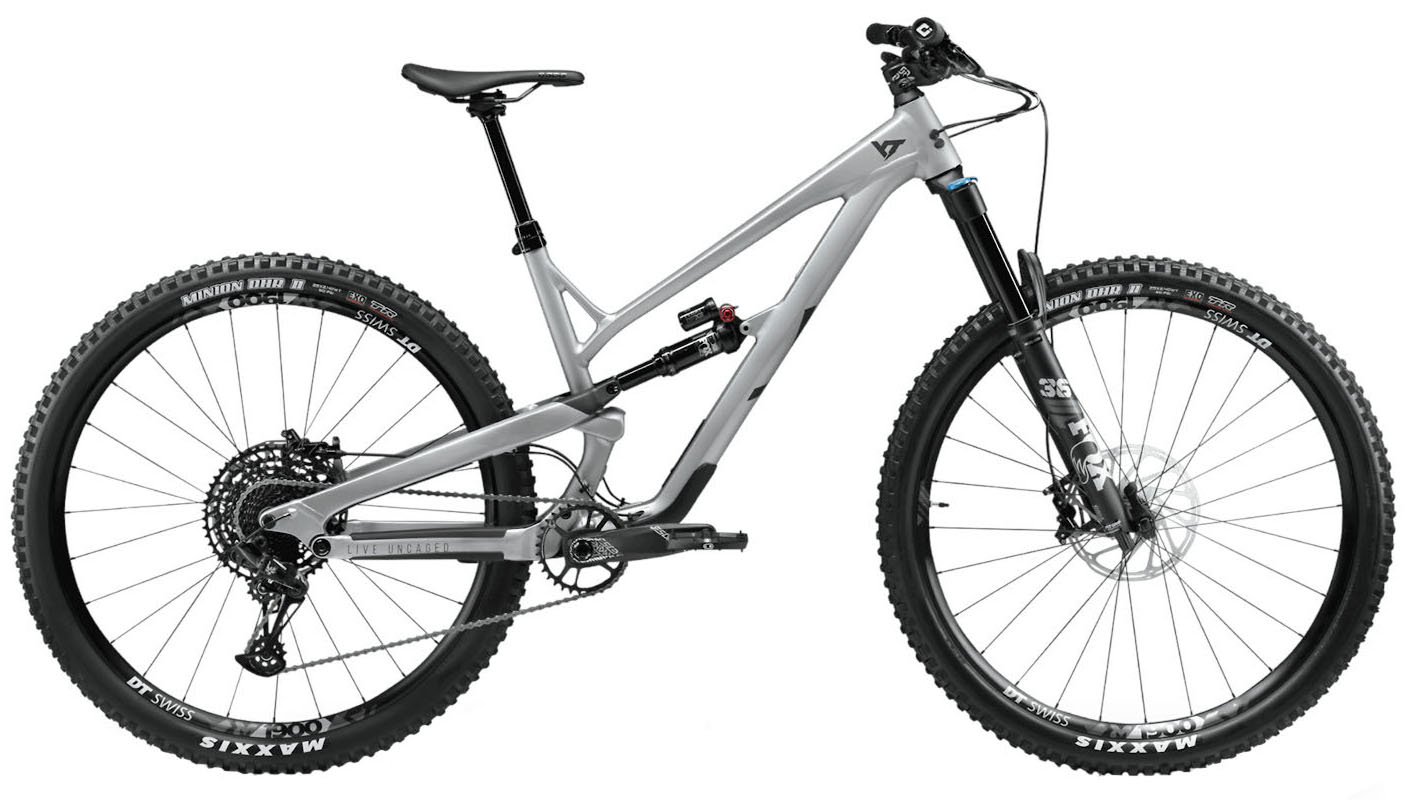
In contrast to premium brands like Santa Cruz or Yeti, YT Industries has built its popularity around offering big-time value. The German-based manufacturer is the best-known direct-to-consumer company that forgoes the middleman (bike shops) and allows shoppers to purchase directly from their website. The Jeffsy is their popular trail/all-mountain offering, and the Core 2 29 base model is a screaming deal: You get quality Fox suspension components front and rear, a DT Swiss wheelset, dropper post, and top-performing Maxxis Minion tires for hundreds less than its competitors. And jumping up to their top-flight Core 4 model ($5,199) will get you components typically found on bikes that cost thousands of dollars more.
What are you giving up by shopping from a consumer-direct company? For one, inventory is hit-or-miss, and at the time of publishing, many sizes and colors are multiple months out (or unavailable altogether). In addition, it can be difficult to get replacement frame parts as bike shops generally don’t stock them. Moreover, buying online means you don’t get a chance to test ride the bike before throwing down some serious cash. But for those who prioritize saving money and are willing to take on a little extra risk, the YT is an enticing option and a solid value. For another direct-to-consumer option, check out Commencal’s Meta TR (starting at $2,500), which also outperforms its modest price tag. See the YT Jeffsy Core 2
Best Short-Travel Trail Bike
6. evil the following ($6,599).
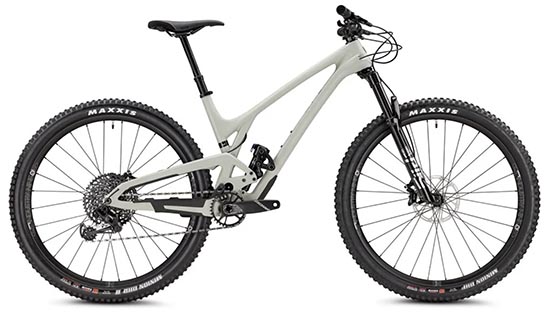
Short-travel full-suspension bikes hit a sweet spot for many riders, and the light and fast Evil The Following currently is our favorite of the bunch. Updated a couple years ago, the bike’s well-balanced riding position hits that desirable combo of near-XC-level climbing that doesn’t terrify you on the descent, 29-inch wheels, and enough suspension travel (130mm front and 120mm rear) for smaller drops and moderately techy terrain. Plus, it’s an extremely refined build with a high-end carbon frame, well-thought-out dimensions, and a creative rear linkage that’s both durable and great to look at. The Evil is not a value leader by any stretch—the $6,599 MSRP for the GX model is Yeti territory—but the bike’s snappy and extremely energetic personality will quickly win you over.
Where does the Following fall short? To start, like the SB130 above, we’d love to see a true entry-level (or even mid-range) version offered with an aluminum frame for those just starting out or wanting to stick to a lower price point. If you fall into that camp, we recommend looking at YT’s Jeffsy Core 2 ($2,999) above. Additionally, riders who prioritize rough and rowdy descents likely will find the Following a little under-gunned—both the Yeti SB130 and Ibis’s Ripmo get the advantage for this type of terrain. That said, the Evil is a faster, nimbler, and more efficient climber than those alternatives, which makes it a better choice for big days. See the Evil The Following
Top Entry-Level Trail Bike for Beginners
7. rei co-op cycles drt 1.1 ($599).
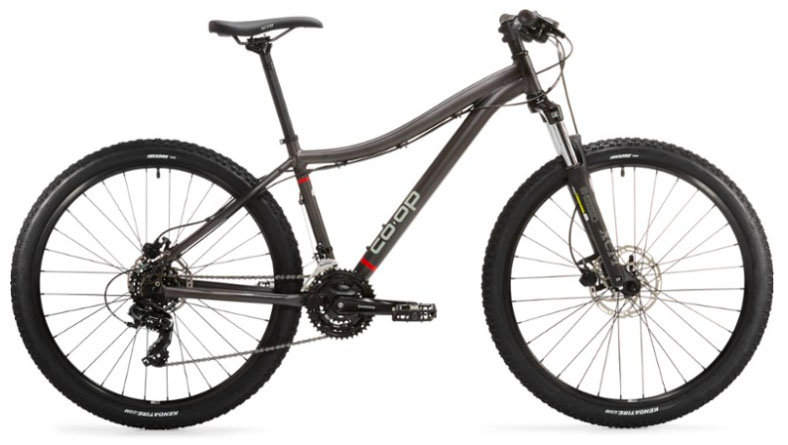
Sub-$600 mountain bikes may conjure up images of cut-rate big-box-store specials, but REI’s Co-op Cycles DRT 1.1 packs a surprisingly good punch. To start, it checks the right boxes for a budget build with a lightweight aluminum frame, 100 millimeters of front suspension travel, and proven Shimano drivetrain. Arguably its biggest selling point is the Tektro hydraulic disc brakes, which have superior stopping power compared with the cable-actuated brakes that you typically find at this price point. And it’s all backed up by REI’s excellent warranty—something you definitely don’t get from the Targets and Walmarts of the world.
What do you give up with the entry-level Co-op Cycles DRT 1.1? For starters, this bike is aimed more at gravel bike paths and mellow singletrack than anything technical. Additionally, the budget-oriented SR Suntour fork will certainly be out of its element during rough and bumpy descents (the quick-release axles don’t help either). If you’re looking for something much more trail-worthy, check out the brand’s DRT 1.2 (our top pick in our article on mountain bikes under $1,000 ). The upgraded model is more aggressive in just about all ways, including more suspension travel, wider tires, and a better overall spec package. However, at nearly half the price, the DRT 1.1 is a great option for most recreational or first-time riders. See the REI Co-op DRT 1.1
Trail Mountain Bike Comparison Table
Trail mountain bike buying advice, frame material: carbon fiber vs. aluminum, full-suspension vs. hardtail, wheel size: 27.5 vs. 29er, drivetrain and gearing, electric mountain bikes (e-mtb).
- Unisex vs. Women's-Specific Models
Trail Bike Price Guide
Buying a mountain bike online, consumer-direct bikes.
- Should I Buy a Used Bike?
As a whole, aluminum-framed bikes still dominate the trail category, but carbon fiber is becoming increasingly common. What’s driving its growing popularity? The main advantages are less weight—approximately 1 pound depending on the frame—and increased stiffness. The additional rigidity of the material compared with aluminum leads to better power transfer and higher efficiency. For committed cyclists, those are pretty convincing performance advantages.
Carbon does come with its fair share of downsides, however. Right off the bat, you can expect to pay about a $1,000 premium for upgrading from an aluminum to carbon frame. Additionally, aluminum does a better job absorbing impacts from trail debris and surviving a high-speed crash (carbon can crack from hard hits). Finally, aluminum is easier to be recycled once a bike has reached the end of its life, although that’s still a hotly debated topic. In the end, it often comes down to budget: carbon has plenty of advantages, but it’s a hard sell if you’re only dabbling in the sport. And we can’t help but think that the extra cash may be better spent on a visit to Whistler instead.
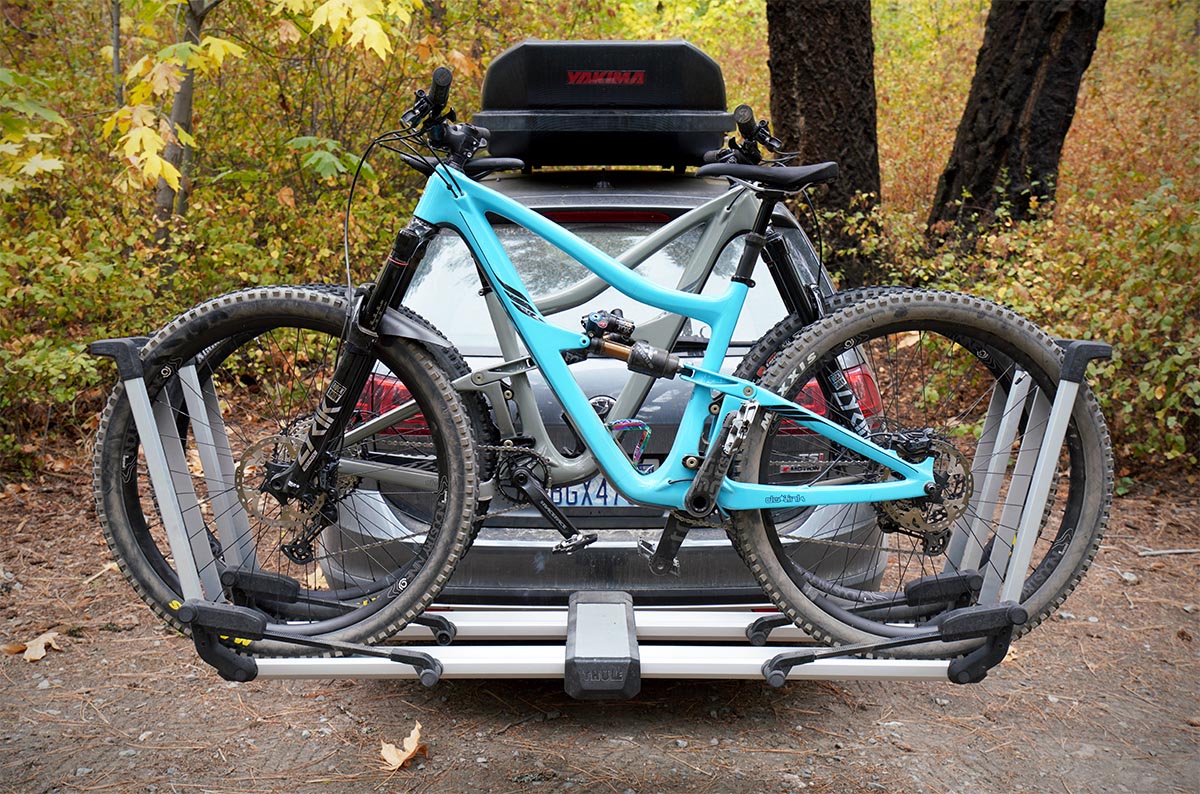
When buying a new trail bike, one of the most commonly asked questions is: should I buy a hardtail (suspension fork only at the front) or full-suspension (includes both a front suspension fork and rear shock) model? There are a number of factors to consider when making this choice. Are you on a tight budget? Are you just starting out? Are your local trails smooth and with few obstacles? If so, a hardtail is probably the best choice for you. However, should your local terrain be rooty and rocky, or maybe you just like going downhill fast, then a full-suspension rig probably is the better option. This is just the tip of the iceberg, however, and we break down the additional considerations below.
Performance In terms of overall riding performance, hardtail and full-suspension mountain bikes each come with their fair share of pros and cons. Starting with hardtails, their lower weight and lack of suspension travel makes them fast and easy to pedal quickly. As a result, they excel on long rides and climbs. But should the going get rough—especially on the downhill—a full-suspension bike quickly takes the lead. The added rear suspension helps soak up bumps and offers a much more comfortable ride in general. FS bikes are the weapon of choice for most intermediate to advanced riders. Having said that, full-suspension designs like our top-rated Yeti SB130 typically weigh more, are significantly more expensive, and will not be as efficient at climbing or on non-technical trails.
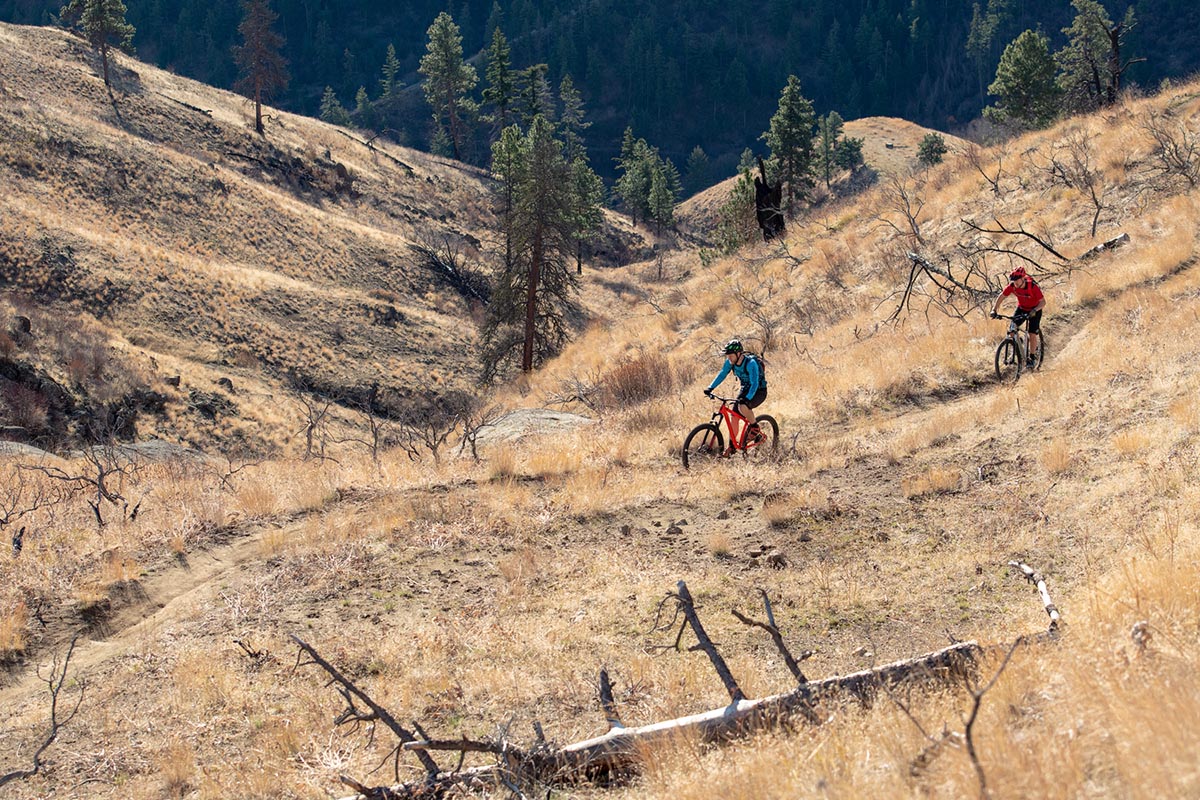
Maintenance If you’re looking for a simple and low-maintenance bike, then hardtails take the cake. Their lack of rear suspension means they forgo any bushing, bearing, or pivots that generally require extra care and attention. This becomes especially true should you live in a wet and muddy climate, which can wreak havoc on full-suspension bikes if they go unmaintained. Because of these characteristics, it’s not uncommon for dedicated mountain bikers to own a full-suspension bike for summer use and a hardtail for when the trails turn to slop. Bikes like the Salsa Timberjack are able to hold their own against short-travel full-suspension rigs yet are much simpler to keep fresh should you often ride in the rain.
Price Once again, if a low price is your top priority, then hardtails are the clear choice. Quality full-suspension trail bikes, with their added rear shock and linkage, are simply too complex to design and build on the cheap. From the list above, the $2,999 YT Jeffsy Core 2 is about as low as we’d advise going with a full-suspension design (there are a few just below $2,000 that are suitable as well). Sure, you could certainly spend less than that on a bike from a big-box store, but in reality, it’s going to ride terribly. The parts won’t last, the suspension will be overwhelmed, and you’ll be quickly wishing you bought a lighter and more comfortable hardtail instead.
.jpg)
Unisex vs. Women’s-Specific Models
Many trail bikes are made in a unisex style and a range of sizes (typically from “S” to “XL”). This can work well for both men and women, although riders on the shorter end of the spectrum can run into some challenges getting an ideal fit. Some brands like Trek address this by offering a wider range of sizes within the unisex line. Taking Trek’s Fuel EX as an example, the bike is made in “XS and “S” frame sizes with top tubes that dip down more aggressively right in front of the seat and smaller wheels (27.5 rather than 29). This makes it easier for shorter riders to comfortably stand over and control the bike. For many women, simply having an array of size options is all they need to get a great fit.
In addition, a number of brands make dedicated women’s mountain bikes. In the past, these mostly have been shrunken-down versions of the unisex models in different colorways. And while that’s still true in some cases—especially on the budget end of the spectrum—many quality brands make women’s-specific trail designs with retuned suspensions, handlebars that are narrower with smaller-diameter grips, and reshaped frames. There also are women’s-only bike brands, including Juliana (Santa Cruz’s sister brand) and Liv (Giant). Liv Cycling in particular really stands out as a leader with a growing collection of XC, trail, and e-mountain bikes for women. In the end, a unisex design like the aforementioned Fuel EX can be a great pairing for many lady riders, but there are a number of potential benefits in opting for a women’s-specific model.
.jpg)
The majority of us do a significant amount of shopping online, so why not do the same when purchasing a mountain bike? They’re certainly more complicated to figure out than a set of dish towels, but there’s a lot of recent movement towards online sales from consumer-direct brands (more on this below), major retailers like REI Co-op and Competitive Cyclist , and even manufacturers themselves like Diamondback. If you’re considering going this route, it’s important to ask yourself a few questions before clicking that buy button. Are you comfortable doing basic assembly and mechanical projects? Will someone be at home to take delivery and sign for your new ride? And, perhaps most importantly, are you comfortable choosing the right size and style of bike without taking a test spin?
One of the most important pieces of the new bike puzzle is getting the correct size, which can be the difference between riding your bike down the hill or wanting to throw it down the hill. Luckily for us, most reputable online retailers and brands provide a significant amount of fit-related information. Size charts are often tailored to specific models, and you’ll then get size recommendation based on your height or inseam length. Taking this a step further, Competitive Cyclist offers one of the most comprehensive fit guides we’ve seen, compiling measurements for your inseam, forearm, lower leg, and more. Taking this detailed approach is one way of ensuring you wind up on a bike that fits you properly.
.jpg)
Should I Buy a Used Bike?
The trail bikes listed above are the latest and greatest in their respective categories, but purchasing a used model is a great way to save and cut down on waste. To start, keep in mind that mountain bike technology has been rapidly evolving even in the past few years, so we recommend picking up a pretty new design. Further, it’s a good idea to closely inspect the bike in person to make sure you’re not buying an unmaintained money pit. With the drivetrain, verify that the chainring teeth are shaped like triangles and less like shark fins. If they look like the latter, it’ll likely need to be replaced. The frame, brake pads, and chain should also be inspected for undue or heavy wear. Finally, see if the rubber seals around the suspension components are cracking or if oil is running on the outside of the fork—both are signs that service is required.
If you’re not comfortable with checking a bike’s mechanical soundness, it’s often worth having a local shop take a look (or you could purchase a former demo bike from a shop, so you can ensure it was properly maintained). Even a modest hardtail can set you back a few hundred dollars, and higher-end models hold their value well enough to justify getting a professional opinion. We recommend calling ahead to make sure they offer the service and that they can fit you in. In the end, used bikes have their place—especially for those just getting into the sport—but it’s a good idea to make an informed, smart decision. Back to Our Top Mountain Bike Picks Back to Our Mountain Bike Comparison Table
Read More From Switchback Travel
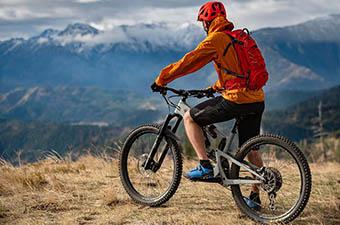
Mountain Biking Gear Reviews
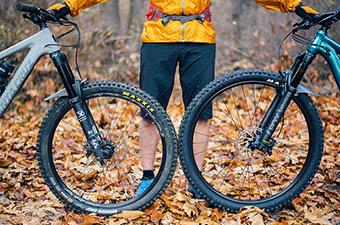
27.5 vs. 29er Mountain Bikes
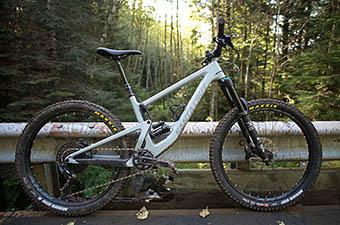

Best Mountain Bike Brands of 2023
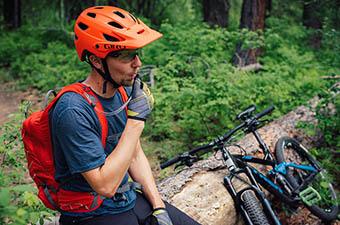
Best Mountain Bike Helmets of 2024
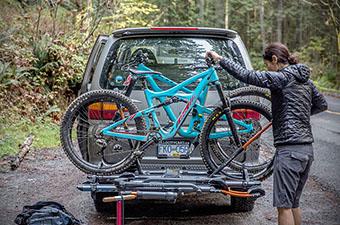
Best Hitch Bike Racks of 2024
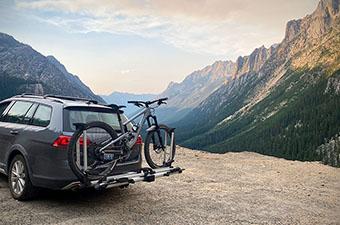
Thule Helium Platform 2 Review
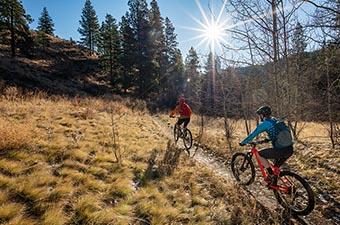
How Much Should You Spend on a Mountain Bike?
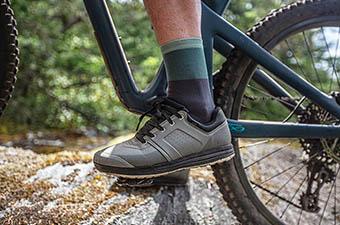
Best Mountain Bike Shoes of 2024
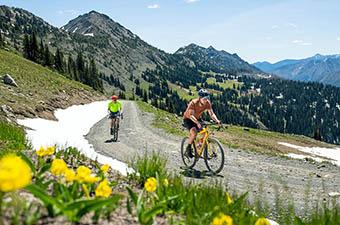
Best Gravel Bikes

Mobile Menu
Megamenu - desktop hamburger menu.
- Hiking Gear
- Backpacking Gear
- Biking Gear
- Camping Gear
- Footwear Reviews
- Climbing Gear
- Skiing Gear
- Winter Gear Reviews
- In-Depth Gear Reviews
- Hiking Shoes
- Hiking Boots
- Trail Running Shoes
- Mountain Bike Shoes
- Approach Shoes
- Climbing Shoes
- Beginner Climbing Shoes
- Mountaineering Boots
- Winter Boots
- Rain Jackets
- Down Jackets
- Synthetic Jackets
- Fleece Jackets
- Hardshell Jackets
- Softshell Jackets
- Windbreaker Jackets
- Ski Jackets
- Winter Jackets
- Hiking Pants
- Hiking Socks
- Trekking Poles
- Baby Carriers
- Running Vests
- Backpacking Tents
- Backpacking Packs
- Backpacking Sleeping Bags
- Backpacking Sleeping Pads
- Backpacking Stoves
- Backpacking Food
- Water Filters
- Altimeter Watches
- Handheld GPS
- Mountain Bike Helmets
- Mountain Bikes
- Mountain Bikes Under $1,000
- Mountain Bikes Under $2,000
- Gravel Bikes
- Bike Brands
- Kids' Bikes
- Hitch Bike Racks
- Camping Tents
- Rooftop Tents
- Camping Sleeping Bags
- Camping Mattresses
- Camping Chairs
- Camping Stoves
- Duffel Bags
- Rock Climbing Shoes
- Climbing Helmets
- Climbing Harnesses
- Climbing Quickdraws
- Belay Devices
- Climbing Ropes
- Climbing Backpacks
- Winter Gloves
- 4-Season Tents
- Ski Helmets
- Ski Goggles
- Ski Backpacks
- All-Mountain Skis
- Ski Bindings
- Backcountry Skis
- Backcountry Ski Boots
- Skis for Beginners
- Hardpack Skis
- Mirrorless Cameras
- Full-Frame Cameras
- DSLR Cameras
- Point-and-Shoot Cameras
- Travel Cameras
- DSLR Lenses
- Mirrorless Lenses
- Lofoten Islands
- Lofoten Hiking
- Hardangervidda
- Jotunheimen
- 10 Great Norway Hikes
- Public Huts
- Torres del Paine
- Chalten and Glaciares
- Lake District
- Patagonia National Park
- Milford Sound
- Abel Tasman
- Marlborough
- Great Walks
- Adventure Towns
Add adventure to your inbox
- Privacy Policy
- Terms of Use
© 2024 Switchback Travel. All Rights Reserved. No part of this site may be reproduced without our written permission.
Best down-country mountain bike: short travel shredders
- Danny Milner
- January 10, 2024
Short on travel but big on geometry, we review the best down-country mountain bike rigs – fleet-footed steeds that blend the speed of an XC bike with the capability of trail bike.

Trek Top Fuel 8 Credit: Roo Fowler
Short on travel, light on weight, but big on geometry, the best down-country mountain bike rippers give you everything you want and nothing you don’t. Fast and fun, in a lightweight, efficient package, these bikes can cover ground with minimal fuss and still be thrashed to within an inch of their lives on proper trails.
- Best mountain bikes: hardtail, XC, trail and enduro to suit all budgets
- Best cross-country XC mountain bikes
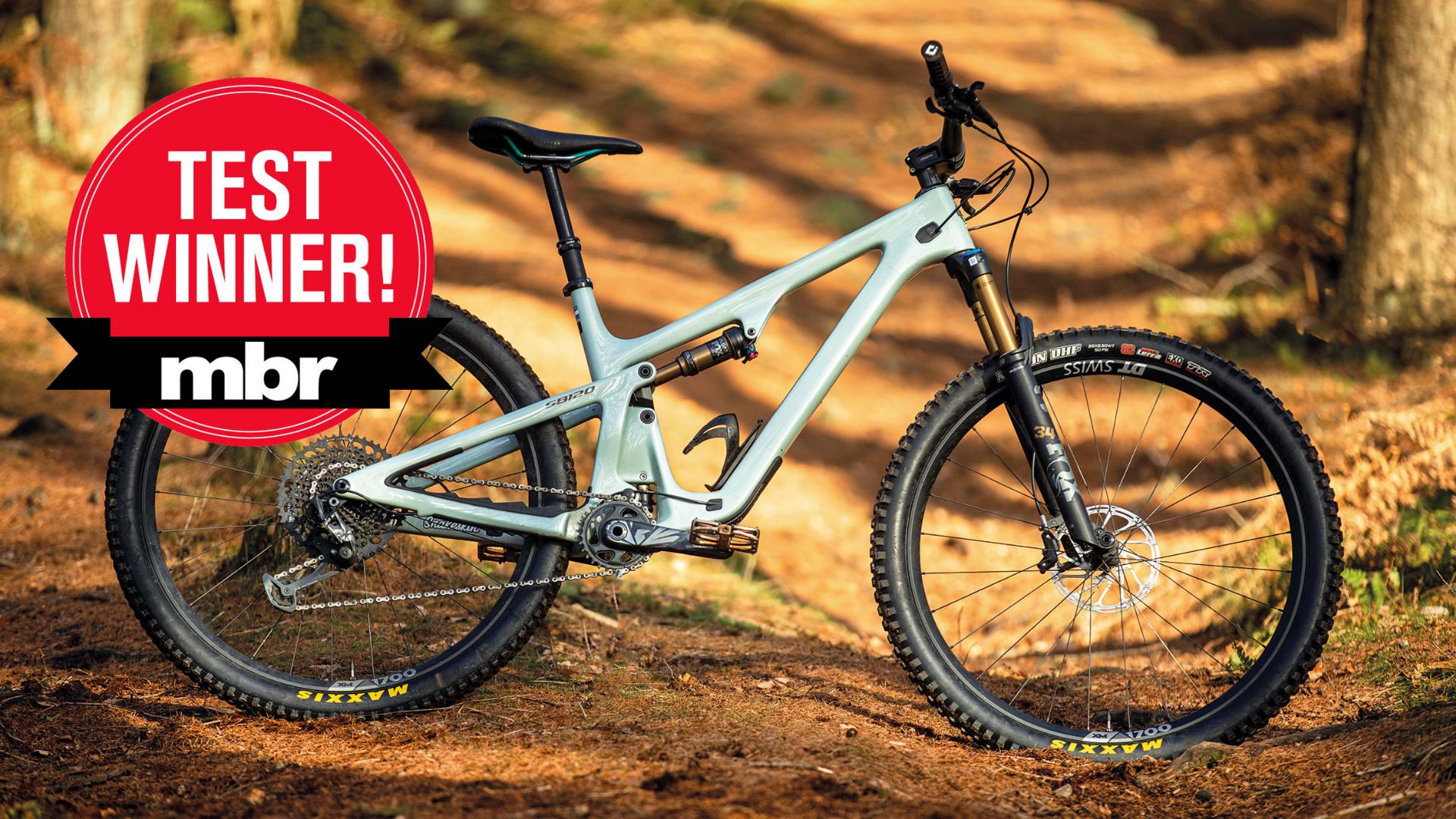
The Yeti SB120 is a down-country bike you can buy with your head as well as your heart
1. Yeti SB120
The best down-country bike if money is no object.
Wheel size: 29in | Frame: Turq carbon, 120mm | Sizes: XS, S, M, L, XL | Weight: 13.3kg (29.3lb) | Rating: 9/10
Reasons to buy:
- All round overachiever with superlative suspension
- Wide size range
Reasons to avoid:
- Agile rather than ultra aggressive
- Not actually that light
- No internal storage
From one of the most aspirational brands in the business comes the impeccable SB120. Yeti shrinks and shoehorns its unique Switch Infinity suspension design into the SB120 chassis. Where the swingarm moves up and down on dual Fox shafts just above the bottom bracket. And the new design has improved seals, bearings, hardware, and pivots, so it should stay in tip-top condition for longer.
And this clever suspension design really works. As we explained in our review, “the supple suspension is stable under power gives a really positive pedalling feel”. Then, when you really hit a something hard and the rear wheel sticks to the ground, giving superb traction and control. It needs a lighter set of wheels to do the flickable geometry and sublime suspension justice, but even out of the box the Yeti SB120 had us smitten.
Read our full review of the Yeti SB120

Santa Cruz’s Tallboy is a terrier that thinks it’s a rottweiler
2. Santa Cruz Tallboy
Best down-country bike for sending it.
Wheel size: 29in | Frame: Carbon CC, 120mm | Sizes: XS, S, M, L, XL, XXL | Weight: 13.08kg (28.84lb) | Rating: 9/10
- Outstandingly fast and focused full-send aggression
- Does things normally reserved for burlier bikes
- Superb size range
- Internal storage compartment
- Needs a pretty skilled rider to avoid pratfalls
- Uncomfortably uncooperative on technical off-piste trails
- Can be tiring to ride
Although often overlooked in the comprehensive, verging on confusing, Santa Cruz range, we think the Tallboy is an undiscovered gem. You’ve heard of small man syndrome, or small dog syndrome, well the Tallboy has small bike syndrome, where it steadfastly believes it’s actually an enduro bike, and deserves to be ridden as such. The stiff frame and aggressive angles beg to be wrung out on every descent, yet the efficient suspension and lightweight mean it’s always the first bike back up to the top of the hill.
For some riders, all that straining at the leash might be too much. But if you love wringing the neck of a short travel whip, and seeing your buddies slack-jawed in amazement as you undermine and overtake their big-travel enduro bikes, the Tallboy is the ultimate sleeper bike.
Read our full review of the Santa Cruz Tallboy

Transition’s Spur is still one of the finest down-country bikes we’ve ever tested
3. Transition Spur
Best lightweight down-country bike.
Wheel size: 29in | Frame: Carbon, 120mm travel | Sizes: S, M, L, XL | Weight: 11.25kg (24.8lb) | Rating: 10/10
- Perfect blend of speed and control
- Lightweight
- Not the most robust build if you’re carrying some timber
- Narrow size range
The Transition Spur is arguably the bike that spawned the down-country category, and also the bike that perhaps best defines it. At under 11.5kg, the Spur flies out of the gate, haring up climbs and tearing along high-speed singletrack. That lack of inertia encouraged us to sprint every rise, pop every jump, and schralp every turn, helped by the stable geometry and supple suspension.
With lightweight RockShox Sid forks up front, the temptation is to add travel and girth, but to do so is to dilute the Spur’s potency and add unnecessary grams. So while there’s a bit of flex when pushed hard, we’d treat that as part of the charm, and lap up the whirlwind of action that accompanies every descent. As we said in our review, the Transition Spur is “the best-realised ‘down-country’ bike we’ve ever tested and the one we all covet if we were spending our own cash”.
Read our full test review of the Transition Spur

Trek’s Top Fuel 8 offers a high-octane ride
6. Trek Top Fuel
Explosive trail weapon.
Wheel size: 29in | Frame: Carbon or alloy, 120mm travel | Frame sizes: S, M, M/L, L, XL, XXL | Weight: 14.89kg | Suspension travel: 130mm f/120mm r | Rating: 9/10
- Poppy, playful and efficient
- Available in six frame sizes
- Internal down tube storage
- Mino Link flip chip allows geometry tweaks
- Needs a 180mm rear rotor
- Accurate rear shock set up is crucial
- A solid build, so not the lightest in its class
While the Trek Top Fuel used to be a lean, mean, cross-country fighting machine, the middle-aged spread has left it sagging a little on the scales. But don’t let that fact put you off, because the ride quality is worth its weight in gold, even if it won’t be competing for gold medals on the race track.
In our test we praised the Top Fuel as offering a “fast, fun and engaging ride”. Where “Its poppy playful nature, combined with generous sizing, means you never feel limited by the travel for regular trail riding”. Combined, this means the Trek Top Fuel provides a high-octane ride that keeps the pace high without compromising on fun. If you can stretch to one of the carbon options, that will help shed some weight, and really light the blue touch paper.
Read our full test review of the Trek Top Fuel 8

The Canyon Neuron 6 is fast and frugal
7. Canyon Neuron 5
Speed freak that also enjoys a party.
Wheel size: 27.5in or 29in | Travel: 130mm | Frame sizes: XS, S, M, L, XL | Frame: Aluminium or carbon | Weight: 14.63kg (32.25lb) | Rating: N/A
- Friendly yet rewarding geometry
- Excellent value
- Seat tube could be a bit shorter
- Saddle is a bit too racy
- Not that light for a down-country bike
The Neuron is Canyon’s back-to-basics trail bike, newly updated for 2023, There are four carbon and four alloy models to choose from, with prices starting from £1,849 for the Neuron 5 and going up to £5,749 for the Neuron CF LTD. There’s also a kids’ Young Hero model with an XS frame and 27.5in wheels for £1,499, and women’s versions of the Neuron 6, Neuron 7 and Neuron CF8 available at no extra cost.
As with the previous bike, all XS and S frames come with 27.5in wheels, while the Medium upwards come with 29in wheels. As with most Canyons, you’ll need to factor in a bike box at £18.99 and delivery at £37.99 to all of the headline prices. Whichever you choose, the latest Neuron is versatile, affordable and a total blast to ride, as happy hitting enduro tracks and sending jumps as racking up the miles on a multi-day ride. The alloy frame has a comfortable, compliant ride that’s never jarring, and the choice of fast-rolling Schwalbe tyres means it rolls along almost effortlessly.
Read our full test review of the Canyon Neuron 6

Looks so sharp you could cut yourself just looking at it: The YT Izzo Uncaged 7
Rapier-sharp speed and agility
Wheel size: 29in | Frame: Carbon, 120mm travel | Frame sizes: S, M, L, XL, XXL | Weight: 11.4kg | Rating: N/A
- Acutely responsive and ruthlessly efficient
- Agile and accurate
- Good spec for the price
- Nowhere to hide in the rough
- Traction/grip is not the best
- Doesn’t really need the remote lockout
- Front tyre could be more aggressive
YT’s razor-sharp Izzo feels a million miles away from the brand’s signature Capra and popular Jeffsy trail bike. It’s blisteringly fast but ruthlessly unforgiving, so you need to be on top of your game and fighting fit to keep it under control and take the punches. It’s much stiffer than the Transition Spur, and not as capable as the Santa Cruz Tallboy or Yeti SB120, so in some ways it’s a bit of an anomaly. But it’s also a great-looking bike, feels amazing in certain situations, and the fact that it’s a challenge to get the most out of will definitely appeal to a certain type of rider.
Read our full test review of the YT Izzo Uncaged 7

Orange knows how to build a great handling bike, and the Stage Evo is no exception
9. Orange Stage Evo
Packs big bike geometry into a nimble 120mm package.
Wheel size: 29in | Frame: 6061-T6 Aluminium, 120mm travel | Frame sizes: S, M, L, XL | Weight: 13.83kg (30.49lb) | Rating: N/A
- Incredibly well-poised handling belies its modest weight
- It’s arguably a trail bike
Orange may have ploughed its own furrow over the years, towed by a horse rather than a GPS-guided John Deere, but despite the UK-brand’s traditional frame materials and construction methods, it continues to bang out bikes that ride every bit as well as more cutting-edge rivals. Often even better. The Stage Evo is one such bike, and effectively a shrunken Stage trail bike. And from the very first corner we were reminded why Orange still commands a loyal customer base – the Stage Evo simply shreds. When we tested it, we noted “yes, it’s easy to ride beyond the physical limits of the travel, but that’s what makes the Stage Evo such an engaging bike on regular terrain”.
Read our first ride review of Orange Stage Evo

As soon as you release the reins, the Spur starts to gallop
What is a down-country mountain bike?
A few rules to help categorise a down-country bike. The first rule is that these rules are made to be broken!
Nothing over 120mm
No more than 120mm of suspension travel at either end. The archetypal down-country bike should have closer to 100mm of rear travel. And if there’s a 130mm travel fork up front, it’s ruled out. Usually. There are some outliers than we allow into the down-country fold. Otherwise the whole thing just gets far too close to a regular trail bike. So, no Norco Optic or Nukeproof Reactor 290c ST. Too trail-bikey.
Having said that, neither rear travel nor fork travel should have less than 100mm. Save that for XC race bikes.

With less mass to manhandle, down-country bikes like the YT Izzo goad you into throwing shapes at every opportunity.
Nothing steeper than 67°
We’re talking head angles here. Non-XC geometry is the key thing that must be included if a bike is to be classed as down-country. And though we say ‘geometry’ we really mean head angle. There’s currently not much consensus about the other angles and measurements on down-country mountain bikes; they don’t all have longer reach numbers, nor steeper seat angles, nor super low BBs.
But the head angle on all down-country bikes cannot be steeper than 67°. 66° is arguably the most commonly seen number.
Big wheels only
You’ll not find any 27.5in wheels here. Nope, not even just on the rear as a modern mullet setup. 29in wheels rule the down-country roost.

Although it doesn’t have the poppiest suspension feel, the Tallboy is great fun on jump trails
What’s the difference between an XC bike and a down-country bike?
That’s a contentious one, and mostly a matter of opinion. But in our view, a down-country bike is a trail bike with the weight and travel of an XC bike, whereas an XC bike generally has steeper geometry, a lower front end and a stronger bias towards efficiency. Using, for instance, remote lockouts to maximise power transfer on smooth surfaces. The lines are blurred, however, and some XC bikes are closer to down-country bikes than others. And the components used also make defining bikes more difficult. Some down-country forks have all-out XC race forks. Some have middling 34-35mm stanchions. Some have four-pot brakes and huge rotors. Others just have 180/160 twin-pot combos. Some have dinky stems. Some still sport stems over 50mm long.

True XC bikes, like the Specialized S-Works Epic WC, are lighter, pricier, and more focussed machines.
It’s the finishing kit that is perhaps key to the down-country experience. And expectation. Some down-country bikes appear to be aimed at ex-XC lycra-heads looking for more fun and less sketch in their rides. Other down-country bikes are aimed at the all-out aggro brigade who have tired of their super-capable enduro bikes and wish to inject a level of limit to their Sunday shredding.
In our opinion, it’s the latter type of down-country bike that is most interesting and exciting. But more capable XC bikes also provide unique thrills, and that injection of effortless pace never gets boring.
Slacker, longer, lower… shorter. Bring it on.

- Cycling Magazine
XC trail versus short-travel trail bikes: what’s the difference?
Parsing out the distinctions between micro-categories.

Bike categories have never really been concrete, clear divisions but, with some recent developments, they are getting more confusing. What makes the difference between a cross country trail bike and a trail bike with short travel? How about the difference between XC and XC Trail? Or long-travel and short-travel trail bikes? And why are there so many categories now?
Brands try to put bikes in categories to make it easier for riders to understand what bike is best suited to their riding. But as the basic categories proliferate into endless micro-categories, the picture gets blurry. Especially when some cross country bikes, like the latest Rocky Mountain Element, have the same travel as some short-travel trail bikes, like the Giant Trance 29. These two bikes have quite different purposes.
So how do you tell them apart if suspension travel is no longer an easy guide? More importantly, how do you find the right bike for you? Below, we’ll break down the differences between categories and how to decide which one suits your style of riding best.
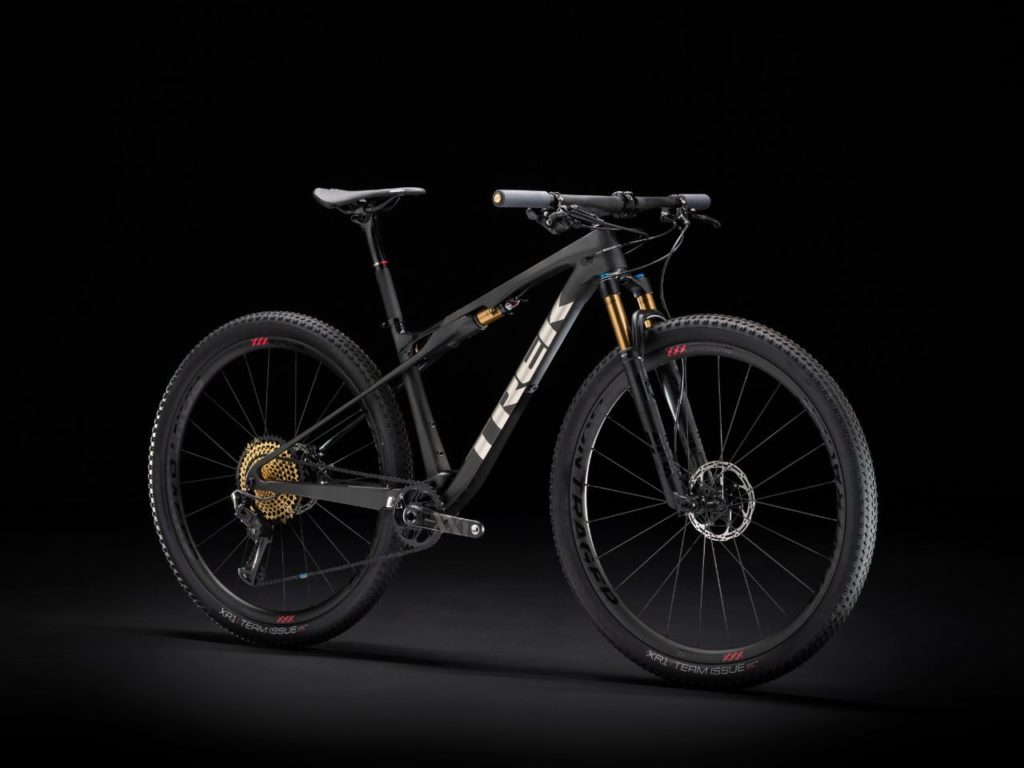
Trek Supercaliber is 100 per cent focused on XC racing
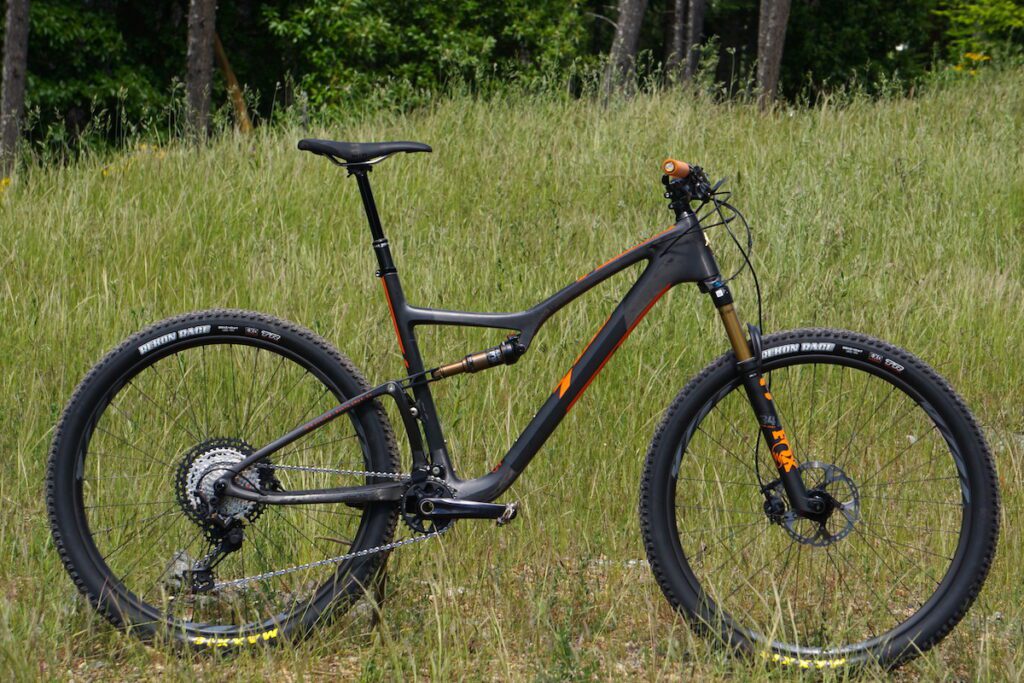
Ibis Exie is a 100-mm travel XC race bike, but with the option to run a 120-mm fork.
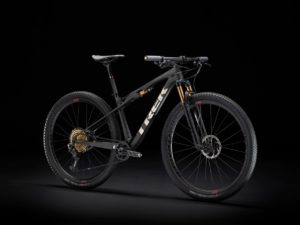
Cross country (XC)
Cross country bikes are designed to be fast and efficient, especially while pedalling. They have geometry that makes them comfortable for spending long hours in the saddle, typically have faster steering for winding through tight, technical trails and aim for a lower weight to aid in easier acceleration and climbing. They can be hardtails or dual suspension with just enough travel, up to 100 or 110mm of rear wheel travel, to take the edge off of roots and rocks and improve speed and control on descents. XC bikes usually use 29″ wheels for efficiency, though some brands still offer 27.5″ wheels in smaller sizes.
Cross country bikes are usually thought of as race bikes since they put such a strong emphasis on pedalling and climbing efficiency. They are, though, a great option for anyone who tends to ride flatter, smoother trails or anyone who enjoys climbing as much as they do descending.
Examples: Ibis Exie , Trek Supercaliber , Canyon Lux World Cup , Norco Revolver FS 100, Scott Spark RC.
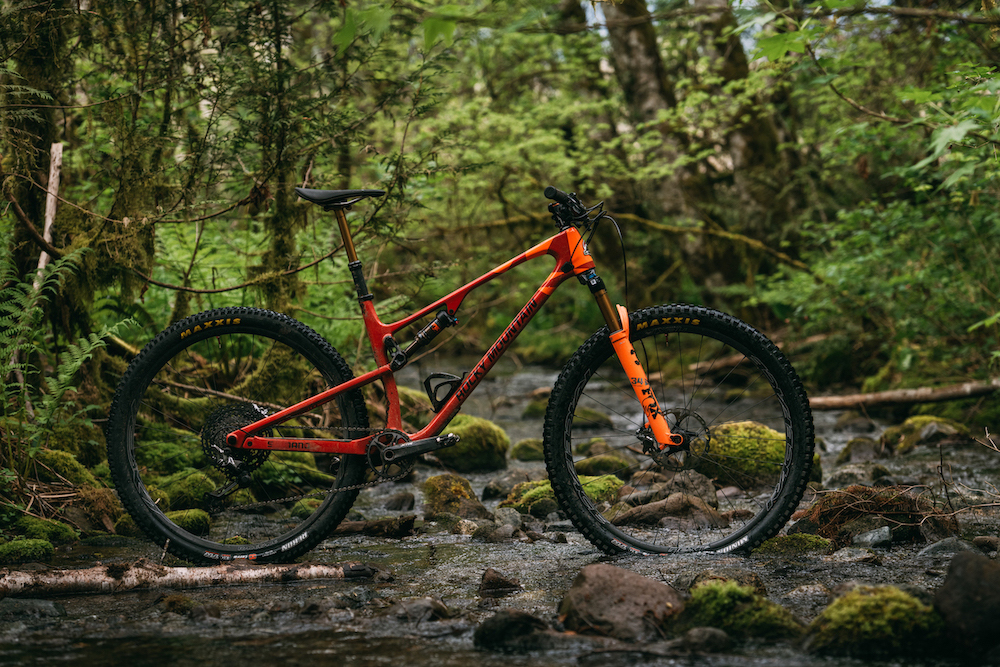
2022 Rocky Mountain Element pushes the limits of XC with 120mm rear travel, 130mm forks and aggressive geometry. Photo: Margus Riga

Canyon Lux Trail builds off of the brand's World Cup bike for a race-focused take on XC trail
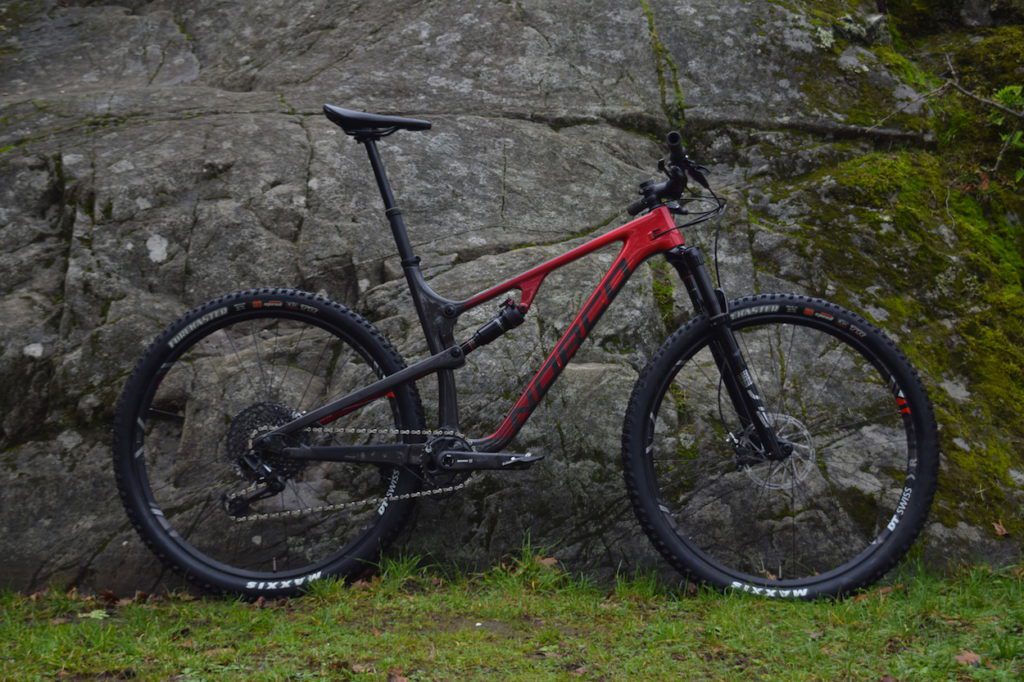
Norco Revolver 120 similarly builds off the Revolver 100 platform to blur lines between racing and riding for fun.

Scott Spark is a slightly longer-travel version of the Spark RC
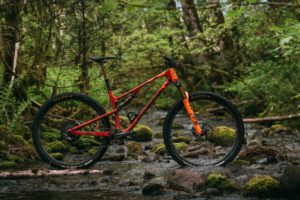
A newer category of bike that’s really gained momentum over the last few years is “XC Trail” bikes. Some brands have made tougher builds of their cross country bikes for years, sometimes with slightly more travel. Now, more brands are making separate XC Trail models. These bikes typically have between 110 and 120mm of rear wheel travel and either 120 or 130mm forks, though that’s just the start of the differences.
These don’t just have more travel than their XC counterparts. They also tend to have different geometry, often slightly more balanced between descending capability and climbing efficiency, and tougher parts. XC Trail bikes are great if you’re aiming for a more technical cross country stage race (like BC Bike Race or TransRockies), or if your everyday riding includes lots of climbs but also more technical descents. These bikes are still very focused on efficiency but open the door to taking on (or having fun on) harder or more challenging descents than a pure XC bike.
Examples: Rocky Mountain Element , Canyon Lux Trail , Norco Revolver FS 120 , Scott Spark .

2022 Giant Trance only has 120mm rear travel, but it's much more focused on fun than climbing speed. Photo: Nick Iwanyshyn

Norco Optic really pushed the burly short travel trail bike idea with 125mm rear travel.

Canyon's Spectral 125 is a zesty take on its 150-mm travel Spectral bike
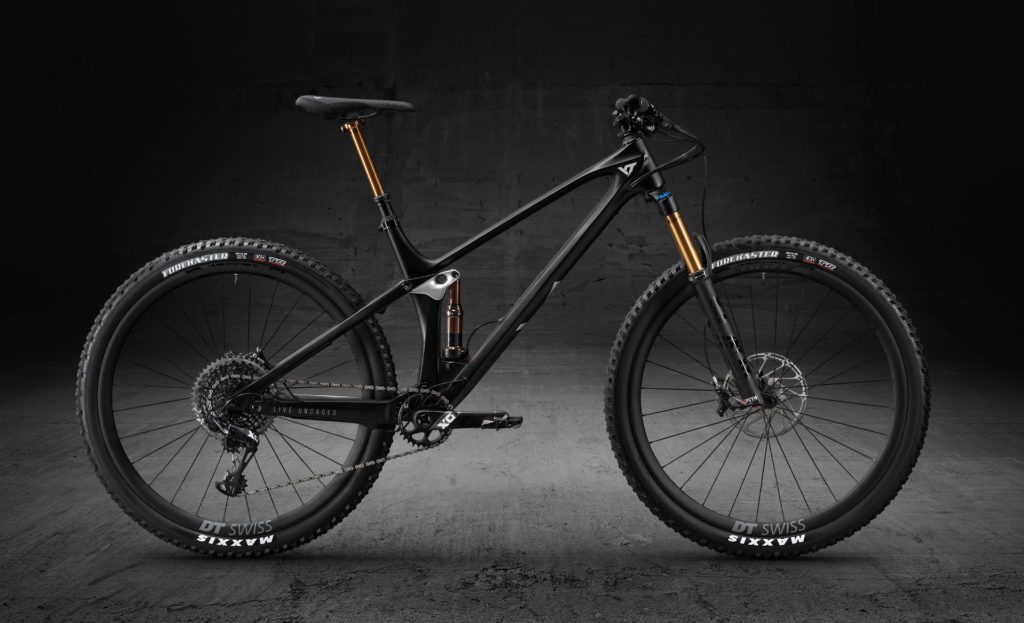
YT Izzo is a balanced 130-mm front and rear, but designed around trail fun more than XC speed.

Trail bikes (short travel)
Another newer category that is really coming into its own lately is the short-travel trail bike. These scaled-down trail bikes answer rider’s call for bikes that are designed to attack descents but aren’t bogged down by too much suspension travel. Why would you want that? Well, if you want the confidence and control of a trail bike going downhill but your local trails don’t warrant a 150mm/160mm bike, these bikes give you proper geometry and just enough travel. Alternately, if you want a challenge, want a more responsive or precise bike but still want to hit bigger things, short-travel trail bikes back up a little travel with burlier parts.
These bikes can range in travel from roughly 115mm to 130mm of rear wheel travel with forks adding another 130 or 140mm up front. More important than travel is the frame design. Short-travel trail bikes are tougher, and therefore often heavier, than XC bikes. With a focus on descending capabilities, they use geometry that puts you in a more forward position than a cross country bike so you can attack descents in a more aggressive riding position. They often use longer dropper posts to get the seat fully out of the way on descents. The seated position is often more upright, for comfort climbing. The tradeoff is that it’s not as comfortable as a cross country bike when rides stretch beyond a couple of hours or when riding on flatter terrain.
Examples: Giant Trance , Canyon Spectral 125 , Norco Optic , Commencal TEMPO , YT Izzo .
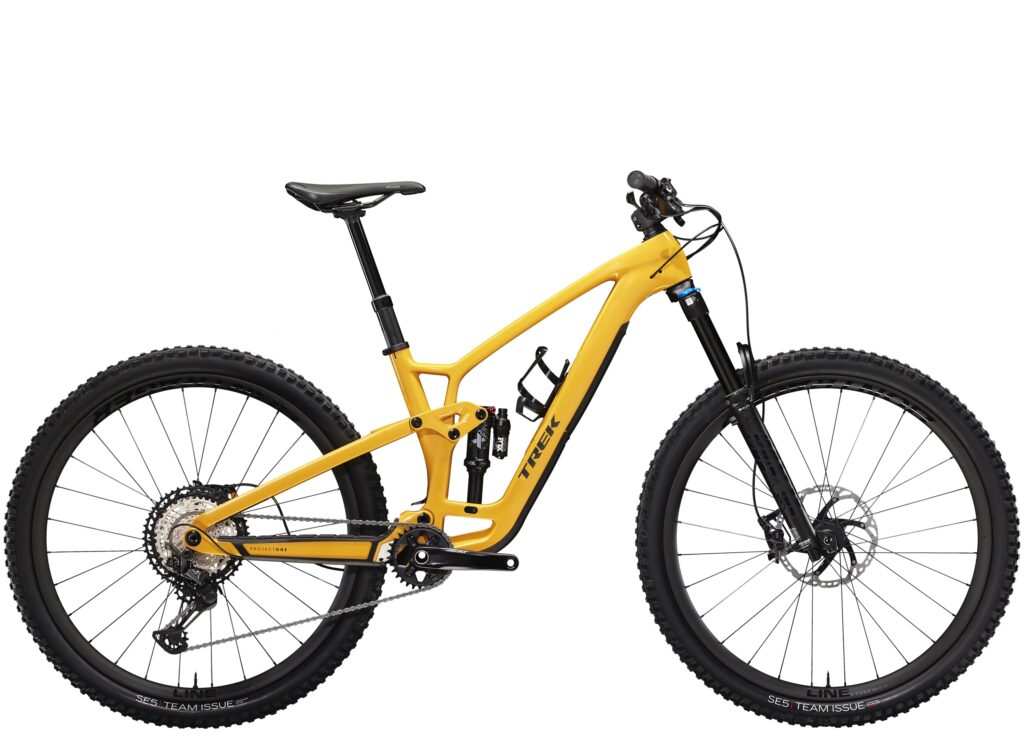
Trek Fuel EX uses all kinds of geometry adjustment chips to make it work on any kind of trail.
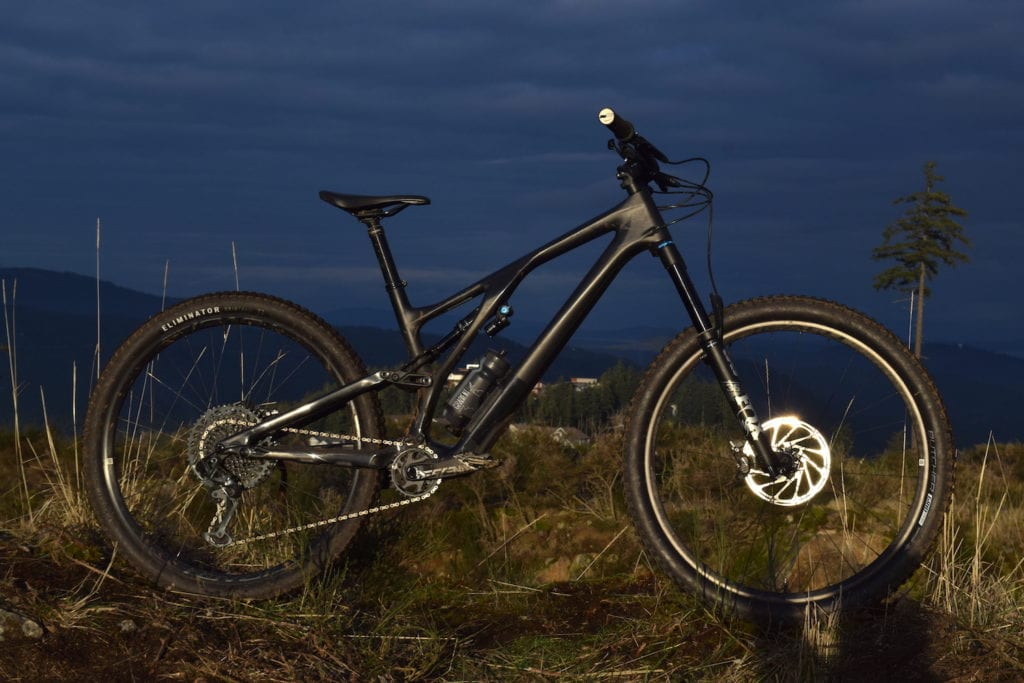
Specialized Stumpjumper was one of the earlier bikes to add geometry adjustments and a MX wheel option.
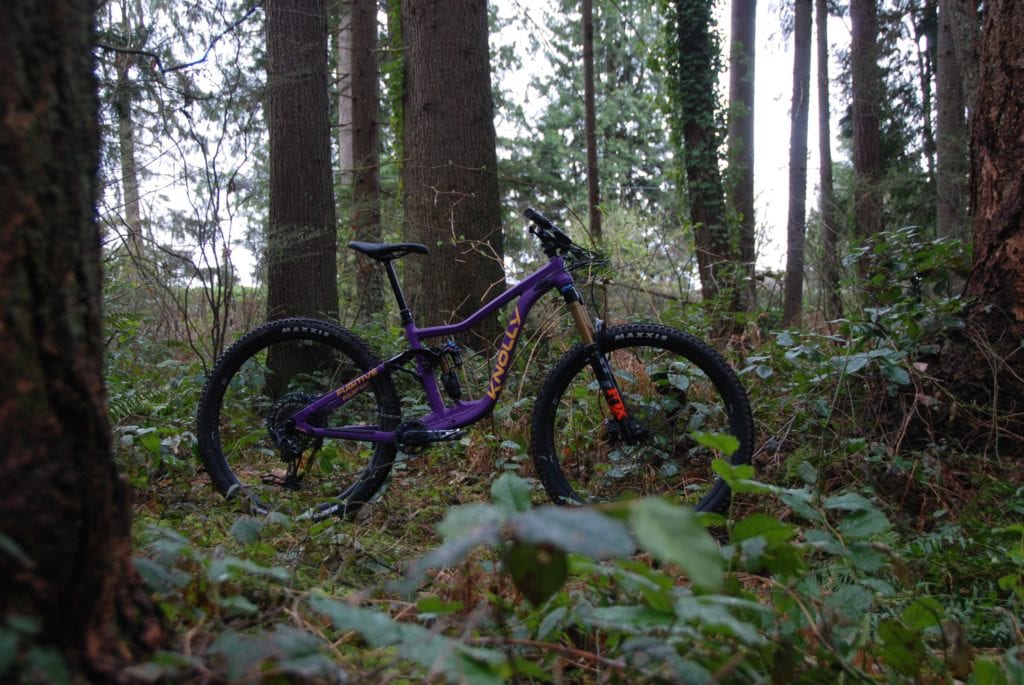
Knolly Fugitive 138 is just shy of 140mm rear wheel travel, but uses a big 150-mm fork

Norco Sight takes the Optic design and adds travel

Canyon Spectral CLLCTV is a dedicated mixed-wheel bike
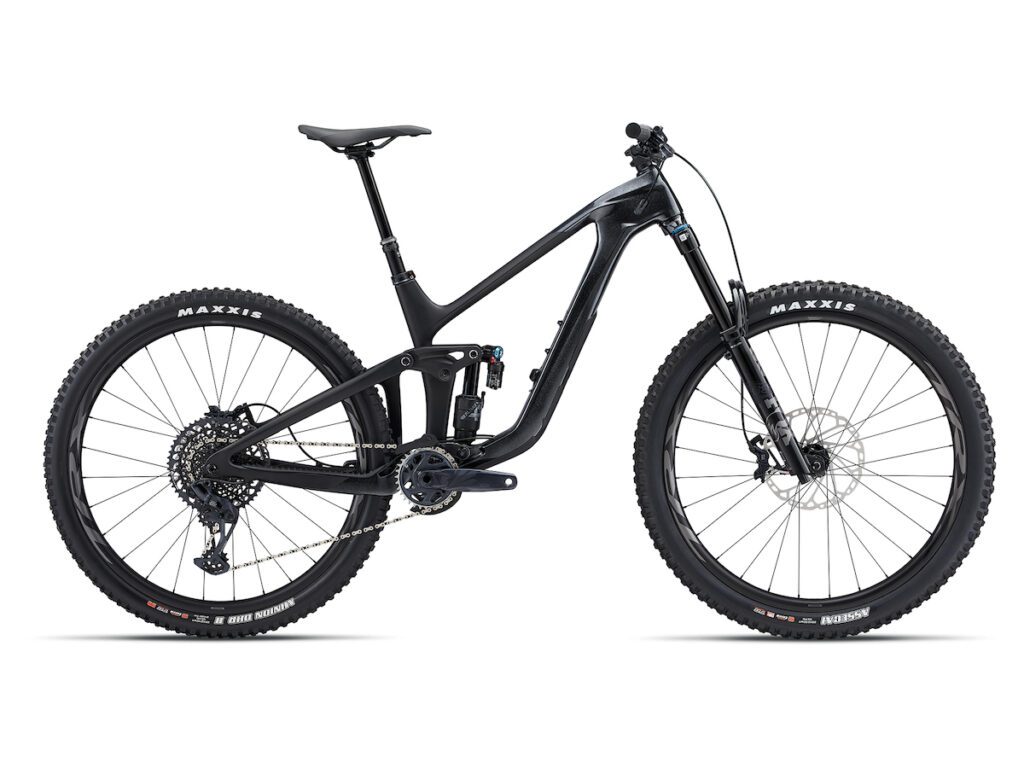
Giant Reign always toes the line between trail fun and enduro speed
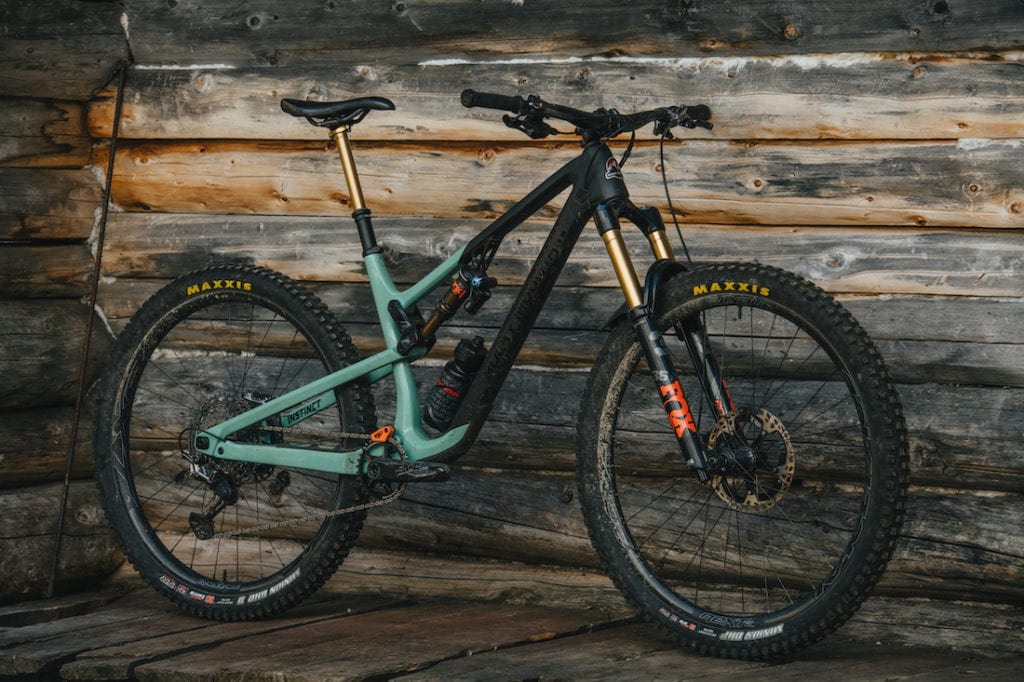
Rocky Mountain Instinct.Photo: Margus Riga
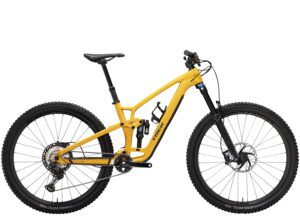
Trail bikes (mid-travel and long-travel)
Trail bikes are the broadest category of mountain bike. They cover all kinds of riding styles and all manner of different trails. Basically, anything that’s not a cross country bike or specifically designed as an enduro race bike can be a trail bike. As the average travel numbers have grown, short-travel trail bikes have split off as a specific niche within the broader trail bike category. But mid- and long-travel trail bikes remain as the do-it-all mountain bike. Trail bikes can still be reasonably good at pedaling, but they also have enough suspension to let you hit basically any trail you want, including larger jumps and features. They have bigger tires, 27.5″ or 29″ wheels (or one of each), tougher suspension, bigger brakes and longer-travel dropper posts.
Examples: Specialized Stumpjumper EVO , Trek Fuel EX , Rocky Mountain Instinct , Canyon Spectral , Norco Sight , Giant Reign , Knolly Fugitive 138

XC Trail vs. Short-travel trail? Look to the components
So, what is the difference between an “XC trail” and “short-travel trail” bike? They both approach a similar travel range, but from opposite directions. XC trail makes a cross country bike more capable, without losing efficiency. Short-travel trail bikes take the idea of a trail bike and make it more efficient without losing toughness.
One feature that sets XC trail and short-travel trail bikes apart is to look at the components. While drivetrains are now relatively universal, Shimano XT will work as well on an enduro bike as it does on a XC race bike, other components are more specific. Trail bikes will use forks with wider stanchions (like the Fox 36 on some Norco Optic and Canyon Spectral 125 models) versus lighter forks on XC Trail bikes (like the RockShox SID on a Norco Revolver 120 or Fox 34 on a Rocky Mountain Element). XC trail bikes may use smaller brake rotors or two-piston calipers instead of four-piston brakes and may also use shorter-travel dropper posts compared to trail bikes. Tires are also likely to be heavier and have more aggressive treads on short-travel trail bikes versus the fast-rolling tires on an XC trail bike.
Which you prefer will depend on how you approach your riding. If you like the idea of a cross country bike but want something tougher, XC trail is probably the way to go. It will still be fast and efficient, but more fun to ride on more aggressive trails. On the other hand, if you like to hit jumps and bash through rocks but you want something more precise, or your local trails don’t demand 150mm of travel, a short-travel trail bike could be right for you. It’ll still be tough, and it’s still designed to put descents first, but it will likely be a bit heavier and have slower tires than an XC trail bike.

- Email address: *
- Name This field is for validation purposes and should be left unchanged.

Should I get a short-travel trail bike or a long-travel trail bike?
I don’t know if you answer these kinds of questions but I thought I’ll give it a try. Feel free to deny to answer ;-).
As mentioned above I’ll be getting a new bike and I actually ordered a 130mm trail bike. I’ve been a bit insecure lately if I did the right choice or if I should try to change my order to a 150mm bike which is a bit more towards Enduro (I rather have only 1 bike than 2).
I don’t want to be one of those quys who is overbiked, on the other hand I don’t want to risk damage of the bike because I’m doing stuff which the bike can’t take.
The skill level I’m hoping to achieve:
- Good flow on trails with berms etc.
- Being able to go down technical terrain with some “blocked” passages safely (I don’t want to go down fast)
- Doing drops of maybe 1m
- Jumps: clearing tables of maybe 2m safely. Not sure if I have the balls for attempting gaps.
- Pump Track. With increasing skill, I’d love to include some jumps.
As most of my biking is without shuttles and more like tours rather than bike parks I opted for a nice, light high-end trail bike, but as said, I’m not sure if it would take the above mentioned loads.I’m about 74kg of weight. What does your experience say?
I’m looking at a Canyon Neuron (130mm rear/130mm front) and a Canyon Spectral (140/150mm).
Since I’m a Specialized guy, I relate the Neuron to a Stumpjumper ST and a Spectral to a regular Stumpjumper.
I’ve ridden both bikes. Both are awesome, but in different ways. The ST is insanely fast/fun on mellower terrain. The regular Stumpy lets me attack rougher terrain. Strange fact: I PRed my local rocky climb on the regular Stump; I think the suspension tracked well in the bumps.
In general, the low-travel trail bike is ideal in these conditions:
- You have low skill but are not riding aggressively or riding technical terrain.
- You have high skill and are charging hard on moderate terrain.
- You want a blend of descending and climbing, with the bike a bit more focused on climbing.
- You like the way this bike rides.
Go for the bigger bike if:
- You have low skill and are trying to ride crazy terrain. The bigger bike adds confidence.
- You have high skill and are charging hard on all terrain.
- You want a blend of descending and climbing, with the bike a bit more focused on descending.
- You simply like the way the bigger bike rides.
I live in a rocky area, and I ride a lot of biggish bike park features. If I can only have one bike (in addition to my Fuse hardtail), I’ll go for the regular Stumpy. If I can have two bikes, I’ll go for the Stumpy ST and a much bigger Enduro.
For what you’re describing, the 130mm bike should be ideal.
But you should test-ride the bikes before you buy. I suppose that’s an issue with mail-order bikes.
Leave a Reply
Leave a reply cancel reply.
Your email address will not be published. Required fields are marked *
Save my name, email, and website in this browser for the next time I comment.
Search this site (more than 2,000 articles)
- Lee Likes Bikes MTB School
- Dynamic MTB Fit
- Live Instruction
- Remote Coaching

Best Long Travel Mountain Bike Review 2021
by Kyle Scott | Nov 12, 2021 | Best of Bike , Best of Mountain Bikes , Bike , Comparisons
Table Of Contents
Long travel 29ers, terminology, our top picks.

A.) Reach : the distance between the center of the head tube (where the handlebars sit) and an invisible line that runs up from the center of the bottom bracket. Short travel bikes are getting longer and longer reach, meaning to keep up with steeper head tube angles (read on), the longer reach allows the rider to have more control over the front end of the bike. For a medium-sized frame, expect to see between 440mm and 470mm for reach.
B.) Rear Center (Chainstay Length) : The distance between the rear axle and the bottom bracket. The shorter the measurement means the rider will be positioned closer to the back axle and this allows for easier manuals, greater control over the back tire, and overall, the bike will have a more responsive feel. The longer the chainstay length, the greater stability you will have at speed and over rougher terrain.
C.) Front Center : The distance between the front axle and the bottom bracket. As head tubes get slacker the front center distance is getting longer. A longer measurement again will mean more control at speed on downhills but potentially sluggish responsiveness on uphills and flats. A shorter front center will provide more agile steering and greater control on uphills but may feel sketchy when at speed on downhills.
D.) Wheelbase : Measure from the front center to the rear center of each wheel, and you get the measurement for the wheelbase. This is the distance between the front axle and rear axle. A larger wheelbase will provide stability on the downhills while a shorter wheelbase will be more maneuverable and give slightly better control over the front wheel. Both serve different purposes and each rider will likely prefer a different measurement depending on his or her discipline.
E.) Bottom Bracket Height : This is the measurement of the distance between the bottom bracket and the ground. A lower bottom bracket height will offer more control and a more stable feeling on the downhills, however the trade-off is the potential of bouncing your bottom bracket or pedals off of uneven roots and rocks.
F.) Head Tube Angle : This is the angle of the head tube from a flat plane (the ground). Head tube angles often absorb the most impact on the handling and stability of the mountain bike. You will hear the angles referred to as “slack” if they are a low angle or steep as they get higher. Cross country bikes and trail bikes have steeper head tube angles that allow riders to have greater control over the bike while climbing, whereas enduro and downhill mountain bikes have very slack head tube angles to give the most control while descending at high speeds.
G.) Seat Tube Angle : This is the angle that the seat tube stands up from horizontal. This angle determines the rider’s seated position over the back wheel and the amount of control that they will have over the front wheel. A steeper seat tube angle has traditionally been best for bikes that want to climb and keep the rider in a neutral position so they can power hard into the pedals. A steeper seat tube angle also offers the rider the option to have more weight over the front wheels and, in turn, greater control and traction over the front end.
H.) Trail : The distance between the bikes front wheel contact patch with the ground and the steering axis. Greater tire size will provide more trail as well as smaller fork offsets. The more trail, the greater amount of tire will be in contact with the ground and that equals more traction and control.
Fork Offset : The distance between the front axle and the steering axis. Essentially, where the front fork comes down from the head tube is your steering axis, and the small amount of metal that connects the front fork to the axle is the offset. Traditionally, mountain bikes have gone with a 51mm offset for 29” wheels. However, there is a small push towards bringing in smaller offsets, like 44mm, which provide greater trail and more traction.
Travel : This is how far moving parts move on a mountain bike. Mainly referring to the suspension (rear and front). When reading about mountain bikes, specifically a “120 mm travel bike,” the travel they are mentioning is in the rear shock. Frames are built with a level of suspension in mind and are not often switched for different levels of travel, so that is why the travel often only means the rear suspension. Front travel in the forks is easier to switch around, depending on the rider’s preference and terrain, so those numbers will change more frequently.
Bikes with smaller travel (short travel) are better for climbing as the suspension won’t take away too much of your pedaling power as you move uphill, whereas the larger suspension is better for a more controlled and comfortable descent down choppy terrain. Most suspension systems are lockable, meaning you can reduce the amount of travel on the fly, and this helps with climbs.
Best Long Travel Mountain Bikes of 2021
Santa Cruz Hightower : Best All-Around Long Travel Bike of 2021
Giant Reign : Best Budget Long Travel Bike of 2021
Yeti SB150 : Best Climbing Long Travel Bike of 2021
Specialized Enduro : Best Enduro Bike of 2021
Other Mountain Bikes
Pivot switchblade, canyon strive, orbea rallon, kona process x, norco sight, scott ransom, nukeproof mega.

Santa Cruz Hightower Review
Buy Now at Backcountry.com
Compare Best Prices
- Climbing Ability 90% 90%
- Downhill Ability 90% 90%
- Overall Fun 90% 90%
All-around Ability in a Variety of Terrain
Weight of some of the build options.
Travel: 145mm rear/ 150mm fork
Head Tube Angle: 65.2
Seat Tube Angle: 76.3
Reach: 470mm (large frame)
Weight: Starting at 29 lbs

Giant Reign Review
Buy Now at Giant-bicycles.com
- Climbing Ability 70% 70%
- Downhill Ability 80% 80%
- Overall Fun 80% 80%
Maestro Suspension Platform, Price
Could use some better brakes.
Travel: 146mm rear/ 170mm fork
Head Tube Angle: 64.6
Seat Tube Angle: 76.4
Reach: 488mm (large frame)
Weight: Varies With Frame Material

Yeti SB150 Review
Buy Now at Aventuron.com
- Climbing Ability 80% 80%
Really Playful Bike
Expensive build options.
Travel: 150mm rear/ 170mm fork
Head Tube Angle: 64.5
Seat Tube Angle: 76.9
Reach: 480mm (large frame)
Weight: Starting at 31 lbs

Specialized Enduro Review
Buy Now at Specialized.com
- Downhill Ability 100% 100%
DH Bike That Can Climb
Needs steeper seat tube, price.
Travel: 170mm rear and fork
Head Tube Angle: 63.9/ 64.3
Seat Tube Angle: 76
Reach: 487mm (S4 frame)
Weight: Starting at 32.5 lbs

Ibis Ripmo Review
Buy Now at JensonUSA.com
Climbing Ability, Ripmo AF Option
Stock shock not being fox float.
Travel: 147mm rear/ 160mm fork
Head Tube Angle: 64.9
Reach: 475mm (large frame)
Weight: Starting at 28.9 lbs

Pivot Switchblade Review
Buy Now at Backcountry.com
- Overall Fun 100% 100%
All-around Performance
Travel: 142mm rear/ 160mm fork
Head Tube Angle: 66
Seat Tube Angle: 75.5
Weight: 30.2 lbs

Canyon Strive Review
Buy Now at Canyon.com
The Shapeshifter
Also the shapeshifter.
Travel: 150mm rear/ 160mm fork
Head Tube Angle: 66 - 67.5
Seat Tube Angle: 73.5 - 75
Reach: 470mm (large frame))
Weight: Starting at 31.2 lbs

Orbea Rallon Review
Buy Now at JensonUSA.com
Amazing Climber, Custom Paint Job Option
Short reach and cost.
Travel: 160mm rear/ 170mm fork
Head Tube Angle: 65
Seat Tube Angle: 75.5/ 76
Reach: 455mm (large frame)
Weight: Starting at 30.95 lbs

Kona Process X Review
Buy Now at Konaworld.com
- Climbing Ability 60% 60%
- Overall Fun 70% 70%
Chainstay Chip Makes A Difference
Sluggish at slow speeds, super long.
Travel: 161mm rear/ 170mm fork
Head Tube Angle: 63.5
Seat Tube Angle: 78
Reach: 490mm (large frame)
Weight: 32.8lbs (large frame)

Norco Sight Review
Buy Now at Norco.com
Strong Climber, Stable Descents
Not as playful as older versions.
Seat Tube Angle: 77.7
Weight: Starting at 32.23 lbs

Scott Ransom Review
Buy Now at Scott-sports.com
Made For The Downhills
Twinloc system needs some work.
Travel: 170mm
Seat Tube Angle: 75
Reach: 466.5mm (large frame)
Weight: Starting Around 30.20 lbs

Nukeproof Mega Review
Buy Now at Nukeproof.com
Now Comes With A Water Bottle Mount, Sportier Geometry
Climbing could be more efficient.
Head Tube Angle: 64
Weight: Heaviest Build 34.2 lbs
Santa Cruz Hightower

Best All-Around Long Travel Bike of 2021
Price: $7,299
What We Like: All-around Ability in a Variety of Terrain
What We Don’t: Weight of Some of the Build Options
Santa Cruz has created the perfect one quiver bike with the Hightower . With a suspension system that is capable of handling flowy trails to absolutely nightmarish choss piles, the Hightower will make it through. Every tester has been really impressed and surprised by the Hightower and its overall versatility. There really isn’t much more to say other than this bike will climb and mountain and ford any stream. It was easy to give the Hightower our selection as Best All-Around Long Travel Bike of 2021 .
^ Back to Top ^
Giant Reign

Best Budget Long Travel Bike of 2021
Price: $3,499
What We Like: Maestro Suspension Platform, Price
What We Don’t: Could Use Some Better Brakes
Giant , though late to the 29” party, have produced some impressive 29ers. The Reign is their second 29er after the Trance, and they are definitely dialing it in. The Reign is a solid climber with the Maestro system and a steep seat angle to keep the rider in a good position. Turn the bike downhill and prepare to bash through anything in your way. The 170mm fork is composed and all-business, while the fairly short rear chainstay with the snappy rear shock keeps it lively and poppy. At the prices Giant is offering on their carbon and alloy frames, it was a fairly easy choice to name the Reign as the Best Budget Long Travel Bike of 2021 , though you can still splash out if you so choose.

Best Climbing Long Travel Bike of 2021
Price: $5,900
What We Like: Really Playful Bike
What We Don’t: Expensive Build Options
The Yeti SB150 always impresses with its climbing ability and an easy selection as the Best Climbing Long Travel Bike of 2021 . Without going overboard on the modern geometry side of things, Yeti has produced a competent climber that is still really aggressive on the downhills. The Infinity Switch system even got an upgrade making the bike more robust. The added suspension makes the bike really playful in the rough and rowdy sections of trails and it has just become a really good all-arounder.
Specialized Enduro

Best Enduro Bike of 2021
Price: $4,499
What We Like: DH Bike That Can Climb
Built for the descent but will also get you uphill with your own power is a tough combination to find. Specialized has come pretty close to nailing it with their new Enduro bikes. The combination of long travel and modern geo has given this downhill rocket the legs to get back up the mountain. The seat tube could be a bike steeper to really help the pedaling efficiency, but it is a small price to pay for the wild downhill skills this bike comes with. It is controlled and composed but also poppy and playful, it has amazing traction when you need it and really just wants to go fast. Add the cool SWAT downtube storage, and it’s hard to find any flaws in this beast, making it our Best Enduro Bike of 2021 .

Price: $3,999
What We Like: Climbing Ability, Ripmo AF Option
What We Don’t: Stock Shock Not Being Fox Float
New may not always be better, but in the case of the Ibis Ripmo , it most certainly is. Slackening the head tube angle, slightly longer reach, and some protection for the linkages, the Ripmo V2 isn’t too different, but it is better. The more aggressive headtube angle does not take away from the climbing ability of the Ibis’s we have come to know and has only made it more fun on the downs. Now with room for a 750ml water bottle, what can’t this bike do?!

Price: $10,899
What We Like: All-around Performance
What We Don’t: Price
Pivot has nailed it. The Switchblade is a dialed-in all-around trail bike that is ready to tackle any terrain, and it will do it in style. The rear shock has been customized by Fox for the Switchblade and has made the bike super-efficient on the uphills but plush and bottomless on the downhills. With a modern but reserved geometry, the Switchblade is highly maneuverable and snappy through tight sections of trail but will also eat up choppy straights. It really is hard to find a negative with the Switchblade other than the price, but also there is a ton of technology that is available to be added to the Switchblade should your wallet allow.

Head Tube Angle: 66 – 67.5
Seat Tube Angle: 73.5 – 75
Price: $8,499
What We Like: The Shapeshifter
What We Don’t: Also The Shapeshifter
Canyon has created something very innovative with the Shapeshifter and for that, it’s pretty awesome. However, it seems that if they had originally adjusted some of the geometry, the Strive could be a one-quiver ride without the bells and whistles that in a way also hinder it. Definitely worth a look for a rider who doesn’t like the modern geo all that much but is looking for a do-it-all bike. The all-around nature of the Strive is present, it just feels like you need to do too much while riding to get the best out of the bike.

Price: $7,999
What We Like: Amazing Climber, Custom Paint Job Option
What We Don’t: Short Reach and Cost
The Rallon by Orbea is a very composed enduro bike. While the geometry keeps it out of the hard-charging enduro bike categories, it is a super good climber and comfortable all-day rider. The MyO customized paint option provided by Orbea will allow you to have the stealthiest or flashiest bike on the hill if you so choose. The rear linkage has been updated and raised to increase bottom out support and create a more responsive ride while also maintaining control while braking. This bike is excellent if you are not the biggest fan of all of the new modern geometry these days and live in an area where there is a lot of vertical gains to be climbed.

Price: $4,999
What We Like: Chainstay Chip Makes A Difference
Kona has brought a stretch limousine to a chicane competition it seems. The new Process X is a far cry from what most of the bikes in this article are in terms of geometry and length. While the length and geo make it a downhill superstar, it does not love tight corners and hates uphills just as much as kids chasing the ice cream truck. The flip-chip that increases or decreases the chainstay length does make a big difference in the ride. So it’s all about finding that perfect set up.

Price: $6,399
What We Like: Strong Climber, Stable Descents
What We Don’t: Not As Playful As Older Versions
The 2021 is not very different from the 2020 Norco Sight , but it is very different from the 2019 Sight. So know that before reading any further. The new 2021 Norco Sight is a long bike with long chainstays and steep seat tubes to keep everything calm, cool, and collected on climbs and speedy descents. Paired with Norco’s Ride Align app, you can easily dial in your suspension settings to get the most out of your new ride and get cruising. Definitely not the flashiest bike or the bike you ride if you want to let your hair down and show off to your friends. The Sight is rock solid and a hard-charging all-mountain bike that could find itself in some enduro races.

Price: $9,223.37
What We Like: Made For The Downhills
What We Don’t: TWINLOC System Needs Some Work
Relying too heavily on the TwinLoc system the Scott Ransom just isn’t the bike it could be if it simply utilized the suspension it chose to its fullest. While being a shredder and a great option for enduro races, the suspension just isn’t quite what we were hoping for, and the rest of the impressive bike fell to the wayside. It is a downhill shredder and great for some laps in the bike park. If you don’t climb a lot and mainly use gravity for propulsion, this is a great option.

Price: $7,332.72
What We Like: Now Comes With A Water Bottle Mount, Sportier Geometry
What We Don’t: Climbing Could Be More Efficient
With a few modifications on the already awesome Mega , Nukeproof has created an amazing bike. They have even added enough room for a water bottle holder, which is great news for people who hate fanny packs. The Mega now comes with a shorter chainstay and a steeper seat tube to make climbing more efficient and the downhills more lively. The build-outs in all five of the options for the Mega are solid and look after the important parts before adding too many bells and whistles. All in all, the Mega is a super all-arounder that would work for any rider of any skill set.
You Might Also Like

When you use links on our website, we may earn a fee.
Best Budget Mountain Bikes of 2024
A top-of-the-line mountain bike can cost nearly as much as an inexpensive car. Fortunately, there are also plenty of reliable, enjoyable mountain bikes that cost many thousands of dollars less. If you’re looking to hit the trail on a bike that’s responsive, sturdy, and won’t leave you with sticker shock, read on. We've identified excellent yet affordable mountain bikes that will have you clearing jumps, stomping landings, and riding steady even over gnarly terrain.
To help you find an affordable mountain bike that will fit your budget and your riding style, we did plenty of research, drew on first-hand cycling experience, and consulted with cycling professionals to curate this list of the best budget mountain bikes available today.
Table of Contents
- Best Budget Mountain Bikes
- Things To Consider When Buying
- How We Chose
Cannondale Habit HT 2 Mountain Bike »

Smooth and responsive ride
130 mm fork travel
Relatively lightweight
Pedals sold separately
The Cannondale Habit HT 2 Mountain Bike is hardly cheap, but it costs a fraction of the price of top-of-the-line mountain bikes while performing competitively against them. It weighs less than 30 pounds thanks to its carbon alloy frame, and it has front suspension forks with a generous 130 millimeters of travel, so even when you come crashing down on solid rock after decent air, you don’t feel like your arms are going to snap. This 10-speed bike shifts gears smoothly, and it stops fast thanks to the SRAM Level hydraulic disc brakes.
The separately sold pedals add to the upfront cost, but the Cannondale Habit HT 2 is the kind of bike you don’t replace; rather, it’s one you will maintain, repair, and upgrade for years to come. Thus, even as your riding level advances, you won’t need a newer, better bike, you’ll just enhance the bike you are already enjoying.
Mongoose Flatrock Hardtail Mountain Bike »

Great low price
Mechanical disc brakes
Available in multiple sizes
Stubborn front derailleur
Many units arrive with cosmetic damage
Even in the larger category of budget mountain bikes, the Mongoose Flatrock Hardtail Mountain Bike is surprisingly affordable for a bike that garners mostly five-star reviews from its owners. It has many features you would not expect to see in a bike that costs less than $300, like disc brakes and a durable suspension system. The 21-speed bike offers plenty of power control whether you are cruising on flat land, flying downhill, or working to gain elevation, and those brakes will slow or stop you with precision.
To get the most out of all those 21 speeds, you may need to get your new Mongoose Flatrock Hardtail serviced by a pro; the front derailleur can be very stubborn, often refusing to shift from one gear to the next. Many customers of this affordable mountain bike report it arriving with some scratches and scuffs, but that’s going to happen in no time out there in the woods anyway. If you're looking for a true entry-level mountain bike that will be plenty of fun as you take to the trail, this is a great choice.
Santa Cruz Bicycles Chameleon MX D Mountain Bike »

Excellent ground connection feel
Generous suspension fork travel
Lifetime warranty on frame
Pedals not included
A solidly built and tightly-tuned mountain bike, the Chameleon MX D lets you feel the ground beneath you, helping you maintain maximum control at maximum speed. Yet the 130 millimeters of suspension fork travel and the sturdy hardtail design absorb plenty of vibration and impact.
As is the case with many bikes in this gray area between budget and high-end, this bike doesn't ship with pedals, so be sure to buy those separately. What it does come with is a responsive 12-speed SRAM Eagle drivetrain that has gears well-balanced for ideal speed control and lactic acid conservation. Revised eight times and counting, the Santa Cruz Bicycles Chameleon MX D is a mountain bike that’s well worth the investment – look no further than the limited lifetime warranty the manufacturer puts on the frame as evidence of that.
Schwinn Traxion Mountain Bike »

Multiple gears offer excellent control
Full suspension
Needs extensive tuning before first ride
The 24-speed Schwinn Traxion Mountain Bike offers a huge range of control over the gearing that's adeptly managed by Shimano shifters. In first gear, your legs will be spinning fast and easy as you claw your way up steep hills. In 24th gear, you’ll be whipping along over flat trails or positively flying on downhill runs. The mechanical disc brakes are surprisingly good, so you’ll still be able to slow or stop yourself with ease. And the 2.25-inch wide tires that come with the bike have a deep, aggressive tread pattern that bites into sand, mud, and other tricky terrain.
Unless you’re pretty handy with bikes, you'll likely need a pro to dial in this bike for you when it’s new because the shifters and brakes are often out of tune when the bike arrives. It's also quite heavy, which only makes the ease of pedaling in the lower gears more welcome. But on the trail, the Traxion is stable and reliable, with the front forks and midframe suspension features absorbing plenty of impact.
Cannondale Trail 6 Mountain Bike »

Easy to ride
Frame absorbs shock
Multiple different frame sizes available
Sluggish on the uphill
Some units ship with no-name parts
If you’re new to mountain biking but confident you’re going to love it, the Cannondale Trail 6 Mountain Bike is a well-made, easy-to-ride mountain bike that you will still be enjoying a few years into your new hobby. Available in five different frame sizes, this bike can be tailored for riders of almost any height. It has a responsive 16-gear system with Shimano derailleurs and tight, reliable Tektro M275 hydraulic disc brakes. Note that some customers have reported getting bikes with no-name components, so check your bike when it arrives and contact the seller if that happens.
The frame is made with a proprietary carbon SmartForm C3 Alloy that ensures the bike is strong yet it’s also relatively flexible, absorbing the bumps and rumbling caused by mountain biking terrain and keeping you more comfortable and stable. The bike’s heavy wheels make it a bit lumbering as you ride uphill, but it still handles easily enough. Its price point is solid considering all the good there is to say about this bike; while hardly cheap, it’s still a great choice for novices who want to give themselves an edge while learning.
Co-op Cycles DRT 1.1 Mountain Bike »

Solid on trail or pavement
Smooth gear shifting
Fair price point
Chain sometimes falls loose
Frame runs small
The Co-op Cycles DRT 1.1 Mountain Bike is almost as at home on paved roads or sidewalks as it is on mountain trails. The included tires are 2.1 inches wide, which is narrower than you’ll find on most mountain bikes and suited well to hard surfaces, yet that’s still plenty of surface area for dirt, sand, mud, and grass. It has smooth, responsive gears and reliable hydraulic disc brakes, and the suspension forks offer a decent 100 millimeters of travel that’s sufficient for moderate off-road terrain and plenty for paved surfaces.
At just under $600, this is a fairly priced budget mountain bike that's more like a hybrid mountain-road bicycle. The frame is on the heavier side if you primarily ride on pavement. The frame also runs small, so taller cyclists might want to go with something else. But the DRT 1.1 can accommodate riders weighing up to 300 pounds and it has 21 speeds, so you can adjust the pressure needed to suit the conditions and your comfort level.
The Bottom Line
The Cannondale Habit HT 2 Mountain Bike is our pick for the best budget mountain bike overall because it costs a quarter of what you might pay for a high-end mountain bike, yet it performs as well as options priced well over $5,000. It has responsive shifters and suspension forks with a sweet spot of 130 millimeters of travel, and it’s relatively lightweight. One of the other budget mountain bikes we covered may be your best choice, though, based on cost, use case, or unique features, so consider each one closely.
Things To Consider When Buying Budget Mountain Bikes
Bike Frame Material and Weight: A mountain bike’s frame material is about much more than weight alone, though that is a factor when it comes to material. These days, most mountain bikes are made out of carbon or aluminum – steel and titanium, once common, are more rarely seen, the former being simply too heavy, the latter just too pricey. Carbon frames are lighter in weight and better absorb the impacts of the trail, transferring less of the jarring off rocks and roots to your body. That said, carbon is more expensive than aluminum, which is a bit heavier and stiffer, but it can make for a much more affordable bike.
Frame Dimensions: Your bike frame has to fit your body properly or you won’t have as much fun or be as safe as you should while out there on the trails. To determine the correct frame size, factoring in an inch or two of height adjustment to the seat, you need to measure your inseam all the way to the ground, not just to below the ankle as you would for pants. Measure from a contact point beneath your groin straight to the floor. Inseams between 28 inches and 31 inches should opt for a frame that measures 15.5 inches. For an inseam between 30 and 32 inches, a 17.5-inch frame will work. And for 33 to 35-inch inseams, pick a 19.5-inch frame.
Suspension Features: Any bike that you’ll be riding on rough terrain and on which you may be catching some air needs to have front suspension forks. These will dramatically reduce the force of impact as you ride, ensuring your experience is better under control, more comfortable, and safer. As for a full suspension mountain bike, where the seat also has a moving cylinder, that’s less essential, especially at a more amateur riding level. “A hard tail requires far less suspension maintenance and is a great platform to jump onto [when you’re] a beginner rider,” says competitive cyclist Jeff Block.
Gear System: The more speeds a bike has, speeds being the different combinations of gears you can create to enhance or reduce the difficulty and output efficiency of your pedaling, the more you can fine-tune your ride to suit the terrain, your athleticism, and your fatigue at any given moment. But don’t get too caught up in the number of gears, not when the type of shifter and derailleur also matter. The former is the hardware your hand operates to change gears, and the latter is the device that physically shifts the bike’s chain to another gear. Look for derailleurs from brands like Shimano, SRAM, and microSHIFT for high-quality options.
Brake Type: These days, disc brakes are far and away the most popular braking systems on mountain bikes, hybrids, and road bikes alike. Though V brakes and cantilever brakes wherein the wheel of the bike itself is squeezed are still seen in new bikes (usually lower-cost options), disc brakes are generally more responsive and are the better choice for use during intense rides when precise control is critical.
Price and Value for Money: “The key to a good beginner bike is to not overshoot the mark on getting a World Cup race bike before you even know how to ride,” says Block. If you are an outright beginner when it comes to mountain biking and you are watching your budget, it’s probably a good idea to go with a very low-priced bike, just in case you abandon the hobby. If you buy a mid-range bike and fall in love with mountain biking, you’ll be stuck with a semi-affordable, semi-appropriate bike, whereas if you went very low cost you could now invest more in a higher-end model. If you are a mid-level mountain biker and see yourself staying as a more casual enthusiast, shop in the middle price range.
How We Chose the Best Budget Mountain Bikes
Even a budget mountain bike is still a significant investment, especially if it's one you can customize, maintain, and enjoy for at least several years. We did careful research in choosing which bikes to feature, looking at key factors like suspension, shifting mechanisms, brake types, and fork travel. We also considered the type of terrain to which various mountain bikes were best suited.
In addition, we spoke to mountain biking experts to get their takes on what to look for in a budget mountain bike. These included cycling gear professional Jeff Block , a competitive road cyclist and mountain biker, and outdoor industry professional Eric Hockman, a lifelong mountain biking enthusiast. Both Block and Hockman told us specific brands of mountain bikes they especially like and offered general thoughts to keep in mind when shopping for one that’s affordable.
Contributor Steven John also relied on his own extensive experience as a mountain biker. He then arrived at his final list based on extensive research and a close reading of reviews left by confirmed customers.
WHY YOU SHOULD TRUST US
U.S. News & World Report contributor Steven John is an avid mountain biker. He leaned heavily on his experience and well over a dozen years spent researching, testing, and reviewing outdoor products. Beyond his work with U.S News & World Report, John also writes for New York Magazine, The Daily Beast, Dad Gear Review, Business Insider, Architectural Digest, Forbes, and several other outlets.
Look at the hardware used on the bike as you consider the quality. Does the mountain bike in question have disc brakes or V brakes? Does it have a derailleur from a known brand like Shimano or does it use unnamed hardware? Is the frame made of aluminum, carbon, or an alloy? The aggregate of these and other similar questions will help you assess the overall quality of an affordable mountain bike.
The differences between a high-end and a budget mountain bike will likely not be significant enough for an amateur rider to even notice. Higher-end bikes allow for more precise tuning and they may dampen the impacts of rough trials more, but the real differences will come more in the longevity and customization of the more expensive bike, which will last longer and will allow for more tuning and altering than a basic bicycle.
Ultimately, a higher-end mountain bike is going to offer the level of control an expert rider needs when performing jumps, riding up steep berms, or navigating the toughest downhill singletrack trails. But for the more moderate riding a newer mountain biker is likely to face, a budget mountain bike is just fine. “Good [budget bikes] get any beginner down the most technical trail they might want to ride in their first few years riding a mountain bike,” says Block.
While service needs will vary based on how often you ride your mountain bike, in the scheme of things, the cost of your bike doesn’t much affect the frequency of service needs save that cheaper components on less expensive bikes may break, necessitating repair. In general, plan to check your mountain bike tire treads and sidewalls every three months; check the brakes and clean the drivetrain every six months; and have a professional inspect the frame annually. If you ride quite a bit (as in more than three times a week), shave about a third off of these times, meaning check the tires every two months, the brakes every four, and so on.
About Our Team

Steven John
Contributor

Jeff Kinney
Senior Editor
U.S. News 360 Reviews takes an unbiased approach to our recommendations. When you use our links to buy products, we may earn a commission but that in no way affects our editorial independence.

- Find a Trail
- My Guidebooks
- Create A Guidebook
- Create A Custom Route
- Search By Map
- Trails Near Me
- Get The TrailLink App
- TrailLink Unlimited
- Submit Trail
- Search trails Close

Bill Chipman Palouse Trail
Idaho, washington.

Register for free! Register for free with TrailLink today!
Bill chipman palouse trail facts, go unlimited.

- About this trail
- Trail reviews
- Parking access
- Trail Photos
Bill Chipman Palouse Trail Photos

View Classic Gallery | Submit Photo
Bill chipman palouse trail description.
Closure Notice: As of late August 2023, a trestle bridge is out along the trail. The Trail is currently closed between the Alpine Animal Hospital and the Jorstad Family Farm (5101 Pullman-Moscow Highway), affectionately known as the "Siggie Dome". Please check local news sources before heading out on the trail.
The Bill Chipman Palouse Trail stretches 7.1 miles through the rolling wheat fields of the Palouse region, offering a convenient, paved connection between Washington State University and the University of Idaho.
The trail follows a piece of corridor from the former Union Pacific Railroad (constructed by the Columbia & Palouse Railroad in 1885), which transported passengers from Colfax to Moscow. The last passenger train ran in 1957. Now, the wide, mostly flat pathway—a respite from the area's many hills and valleys—accommodates non-motorized users of all types, with additional trail connections at either end.
Along the route from Pullman to Moscow, 13 original railroad bridges cross Paradise Creek. Opportunities abound to spot birds and other forms of aquatic wildlife thriving in and near the water. Trail users will also find emergency phones, restrooms accessible for people with disabilities, benches, bike racks, and interpretive signs describing the history, agriculture, and ecology of the region.
The Bill Chipman Palouse Trail overlaps with the Pullman Loop Trail for approximately 1 mile, starting near the Chipman trailhead at Bishop Boulevard. From here, you'll cross Paradise Creek to a cirque of benches and an interpretive station at Birdhouse Depot. Magpies are common; the stream also provides a habitat for hawks, falcons, and more than 100 other bird species.
As you travel farther along the gentle uphill grade, you'll come to the next point of interest, a giant grain elevator. A greenway buffers you from the four-lane highway to Moscow, as do the lovely waysides with interpretive signs and benches along the corridor. Grab some water at Neil Wayside near Pullman. This dry, unsheltered path is often windy heading eastward.
The trail culminates at Farm Road (Perimeter Drive) in Moscow. Continue east on the 2-mile Paradise Path through the north and east edges of the University of Idaho campus and up Paradise Creek to the Moscow city limits. Here, you can connect with the paved, 12-mile Latah Trail to Troy, Idaho.
Parking and Trail Access
There are two spots for designated parking along the trail. At the western terminus in Pullman, there is parking at the gas station across from the trailhead, 1455 SE Bishop Blvd. Halfway between Pullman and Moscow, there is parking at the Sunshine Trailhead.
Although there is no designated parking at the eastern terminus, the trail ends here in downtown Moscow where there is ample public parking.
See TrailLink Map for more detailed directions.
Bill Chipman Palouse Trail Reviews

Flat, yes, but….
Id rate this trail a C- overall for a couple of reasons. The biggest drawback is the overfilled cracks which have been poorly managed. These bumps are hard to take on a rigid frame road bike and they are frequent—as in every few yards. The continual jarring diminishes the riders experience overall. Secondly, as of late August 2023, the bridge near Pullman is out. Some local kids decided to party there and burned the bridge. There is a detour that takes you onto Highway 8, but that’s never enjoyable to ride a busy highway. I wouldn’t recommend going out of your way to ride the trail, bu rid you happen to be in the area and want to do a short ride it’s okay.
Great trail for biking between Pullman and Moscow
I only bike this trail, when I want to go to Pullman for some reason and prefer to bike there rather than drive. I don't choose this trail to bike on for the scenery, because the Latah Trail between Moscow and Troy is a lot nicer. But I do like this trail a lot. While you are parallel to the highway, which isn't a big highway by any means, it's not as loud and intrusive as you might think.
Easy commuter trail along the creek
This trail is perfect for an evening workout or leisurely ride. It is a slight but noticeable downhill from Moscow to Pullman, the two end points of the trail. Also there can be a strong wind from the SW. So keep these two facts in mind when take off. The trail is well marked, wonderfully maintained, smooth surfaced with great views of the rolling wheat fields of the Palouse. It also connects to the Paradise Trail system in Moscow and through to the Latah Trail to the city of Troy. Good for roller blades too.
Not much traffic noise
"Although the trail does parallel the 4-lane road, we have to say that with the wind blowing, we barely heard any traffic noise. There is a nice buffer of green space between the trail and road on most of the pathway which was visually appealing along with providing a ""comfort-zone"" for riding. The green hills and wildflowers added to the beauty. Overall, we had a great ride on this path. Thank you Rails-to-Trails!"
"The Chipman Trail is an amazing 8-mile trail between Pullman, WA, (WSU) and Moscow, ID (UI), through the rolling Palouse. It is pristinely paved with minimal traffic and winds its way along a stream for a short time, past solo trees and a few horses or cows depending on the season. It has beautiful purple, yellow and white wildflowers along with high wheat fields at the peak of the season. It's a fabulous journey east and can get a bit windy for those heading West, which makes the journey even that more exhilarating. I've left Washington state for Washington, DC now and I must say one of the things I miss is my daily blade on the Chipman Trail. Enjoy and say ""Hi"" to the Palouse for me! :)"
Nearby Trails

Pullman Riverwalk
Length: 0.42 mi.

Grand Avenue Greenway
Length: 1.7 mi.

Paradise Path
Length: 2.2 mi.

Latah Trail
Length: 16 mi.

Colfax Trail
Length: 3 mi.

Greenbelt Trail
Length: 7 mi.

Lewiston Levee Parkway Trail
Length: 12.3 mi.

Ed Corkill Memorial River Trail
Length: 5.3 mi.

Great American Rail-Trail
Length: 3743.9 mi.

Palouse to Cascades State Park Trail
Length: 236.46 mi.

Coeur d'Alene Trail
Length: 73.2 mi.

Columbia Plateau Trail State Park
Length: 130 mi.

Go Unlimited Today!
- FREE Account
- View over 40,000 miles of trail maps
- Post your trail reviews
- Share your trail photos
- Save your favorite trails
- Learn about new trails near you
- Get a free map in the app!
- UNLIMITED Account
- Download unlimited offline maps
- Create & save custom guidebooks
- Print-friendly PDF trail guides
- Sync your favorite trails
- Save your favorite trail maps
- Get driving directions to the trail
- See your location out on the trail
- Find nearby restrooms & parking
Help us to connect you with more trails!
TrailLink is a free service provided by Rails-to-Trails conservancy
(a non-profit) and we need your support!

Explore by City
Explore by activity, log in to your account to:.
- View trail paths on the map
- Save trails to your account
- Add trails, edit descriptions
- Share photos
- Add reviews
Log in with Facebook
Log in with google, log in with apple, log in with email or username.

Register for free!
Register with facebook, register with google, register with apple, register with email, thanks, you’re almost done..., your account has been deleted..

Travel Itinerary For One Week in Moscow: The Best of Moscow!
I just got back from one week in Moscow. And, as you might have already guessed, it was a mind-boggling experience. It was not my first trip to the Russian capital. But I hardly ever got enough time to explore this sprawling city. Visiting places for business rarely leaves enough time for sightseeing. I think that if you’ve got one week in Russia, you can also consider splitting your time between its largest cities (i.e. Saint Petersburg ) to get the most out of your trip. Seven days will let you see the majority of the main sights and go beyond just scratching the surface. In this post, I’m going to share with you my idea of the perfect travel itinerary for one week in Moscow.
Moscow is perhaps both the business and cultural hub of Russia. There is a lot more to see here than just the Kremlin and Saint Basil’s Cathedral. Centuries-old churches with onion-shaped domes dotted around the city are in stark contrast with newly completed impressive skyscrapers of Moscow City dominating the skyline. I spent a lot of time thinking about my Moscow itinerary before I left. And this city lived up to all of my expectations.

Travel Itinerary For One Week in Moscow
Day 1 – red square and the kremlin.
Metro Station: Okhotny Ryad on Red Line.
No trip to Moscow would be complete without seeing its main attraction. The Red Square is just a stone’s throw away from several metro stations. It is home to some of the most impressive architectural masterpieces in the city. The first thing you’ll probably notice after entering it and passing vendors selling weird fur hats is the fairytale-like looking Saint Basil’s Cathedral. It was built to commemorate one of the major victories of Ivan the Terrible. I once spent 20 minutes gazing at it, trying to find the perfect angle to snap it. It was easier said than done because of the hordes of locals and tourists.
As you continue strolling around Red Square, there’s no way you can miss Gum. It was widely known as the main department store during the Soviet Era. Now this large (yet historic) shopping mall is filled with expensive boutiques, pricey eateries, etc. During my trip to Moscow, I was on a tight budget. So I only took a retro-style stroll in Gum to get a rare glimpse of a place where Soviet leaders used to grocery shop and buy their stuff. In case you want some modern shopping experience, head to the Okhotny Ryad Shopping Center with stores like New Yorker, Zara, and Adidas.

Read Next: Things To Do on Socotra
To continue this Moscow itinerary, next you may want to go inside the Kremlin walls. This is the center of Russian political power and the president’s official residence. If you’re planning to pay Kremlin a visit do your best to visit Ivan the Great Bell Tower as well. Go there as early as possible to avoid crowds and get an incredible bird’s-eye view. There are a couple of museums that are available during designated visiting hours. Make sure to book your ticket online and avoid lines.
Day 2 – Cathedral of Christ the Saviour, the Tretyakov Gallery, and the Arbat Street
Metro Station: Kropotkinskaya on Red Line
As soon as you start creating a Moscow itinerary for your second day, you’ll discover that there are plenty of metro stations that are much closer to certain sites. Depending on your route, take a closer look at the metro map to pick the closest.
The white marble walls of Christ the Saviour Cathedral are awe-inspiring. As you approach this tallest Orthodox Christian church, you may notice the bronze sculptures, magnificent arches, and cupolas that were created to commemorate Russia’s victory against Napoleon.

How to Get a Decent Haircut in a Foreign Country
Unfortunately, the current Cathedral is a replica, since original was blown to bits in 1931 by the Soviet government. The new cathedral basically follows the original design, but they have added some new elements such as marble high reliefs.
Home to some precious collection of artworks, in Tretyakov Gallery you can find more than 150,000 of works spanning centuries of artistic endeavor. Originally a privately owned gallery, it now has become one of the largest museums in Russia. The Gallery is often considered essential to visit. But I have encountered a lot of locals who have never been there.
Famous for its souvenirs, musicians, and theaters, Arbat street is among the few in Moscow that were turned into pedestrian zones. Arbat street is usually very busy with tourists and locals alike. My local friend once called it the oldest street in Moscow dating back to 1493. It is a kilometer long walking street filled with fancy gift shops, small cozy restaurants, lots of cute cafes, and street artists. It is closed to any vehicular traffic, so you can easily stroll it with kids.
Day 3 – Moscow River Boat Ride, Poklonnaya Hill Victory Park, the Moscow City
Metro Station: Kievskaya and Park Pobedy on Dark Blue Line / Vystavochnaya on Light Blue Line
Voyaging along the Moscow River is definitely one of the best ways to catch a glimpse of the city and see the attractions from a bit different perspective. Depending on your Moscow itinerary, travel budget and the time of the year, there are various types of boats available. In the summer there is no shortage of boats, and you’ll be spoiled for choice.

Travel Itinerary for One Week in Beijing
If you find yourself in Moscow during the winter months, I’d recommend going with Radisson boat cruise. These are often more expensive (yet comfy). They offer refreshments like tea, coffee, hot chocolate, and, of course, alcoholic drinks. Prices may vary but mostly depend on your food and drink selection. Find their main pier near the opulent Ukraine hotel . The hotel is one of the “Seven Sisters”, so if you’re into the charm of Stalinist architecture don’t miss a chance to stay there.
The area near Poklonnaya Hill has the closest relation to the country’s recent past. The memorial complex was completed in the mid-1990s to commemorate the Victory and WW2 casualties. Also known as the Great Patriotic War Museum, activities here include indoor attractions while the grounds around host an open-air museum with old tanks and other vehicles used on the battlefield.
How I Planned My Trip to Vietnam
The hallmark of the memorial complex and the first thing you see as you exit metro is the statue of Nike mounted to its column. This is a very impressive Obelisk with a statue of Saint George slaying the dragon at its base.
Maybe not as impressive as Shanghai’s Oriental Pearl Tower , the skyscrapers of the Moscow City (otherwise known as Moscow International Business Center) are so drastically different from dull Soviet architecture. With 239 meters and 60 floors, the Empire Tower is the seventh highest building in the business district.
The observation deck occupies 56 floor from where you have some panoramic views of the city. I loved the view in the direction of Moscow State University and Luzhniki stadium as well to the other side with residential quarters. The entrance fee is pricey, but if you’re want to get a bird’s eye view, the skyscraper is one of the best places for doing just that.
Day 4 – VDNKh, Worker and Collective Farm Woman Monument, The Ostankino TV Tower
Metro Station: VDNKh on Orange Line
VDNKh is one of my favorite attractions in Moscow. The weird abbreviation actually stands for Russian vystavka dostizheniy narodnogo khozyaystva (Exhibition of Achievements of the National Economy). With more than 200 buildings and 30 pavilions on the grounds, VDNKh serves as an open-air museum. You can easily spend a full day here since the park occupies a very large area.

Places to Visit in Barcelona That Aren’t Beaches
First, there are pavilions that used to showcase different cultures the USSR was made of. Additionally, there is a number of shopping pavilions, as well as Moskvarium (an Oceanarium) that features a variety of marine species. VDNKh is a popular venue for events and fairs. There is always something going on, so I’d recommend checking their website if you want to see some particular exhibition.
A stone’s throw away from VDNKh there is a very distinctive 25-meters high monument. Originally built in 1937 for the world fair in Paris, the hulking figures of men and women holding a hammer and a sickle represent the Soviet idea of united workers and farmers. It doesn’t take much time to see the monument, but visiting it gives some idea of the Soviet Union’s grandiose aspirations.
I have a thing for tall buildings. So to continue my travel itinerary for one week in Moscow I decided to climb the fourth highest TV tower in the world. This iconic 540m tower is a fixture of the skyline. You can see it virtually from everywhere in Moscow, and this is where you can get the best panoramic views (yep, even better than Empire skyscraper).

Parts of the floor are made of tempered glass, so it can be quite scary to exit the elevator. But trust me, as you start observing buildings and cars below, you won’t want to leave. There is only a limited number of tickets per day, so you may want to book online. Insider tip: the first tour is cheaper, you can save up to $10 if go there early.
Day 5 – A Tour To Moscow Manor Houses
Metro Station: Kolomenskoye, Tsaritsyno on Dark Green Line / Kuskovo on Purple Line
I love visiting the manor houses and palaces in Moscow. These opulent buildings were generally built to house Russian aristocratic families and monarchs. Houses tend to be rather grand affairs with impressive architecture. And, depending on the whims of the owners, some form of a landscaped garden.
During the early part of the 20th century though, many of Russia’s aristocratic families (including the family of the last emperor) ended up being killed or moving abroad . Their manor houses were nationalized. Some time later (after the fall of the USSR) these were open to the public. It means that today a great many of Moscow’s finest manor houses and palaces are open for touring.

20 Travel Tips I’ve Learned From Travelling The World
There are 20 manor houses scattered throughout the city and more than 25 in the area around. But not all of them easily accessible and exploring them often takes a lot of time. I’d recommend focusing on three most popular estates in Moscow that are some 30-minute metro ride away from Kremlin.
Sandwiched between the Moscow River and the Andropov Avenue, Kolomenskoye is a UNESCO site that became a public park in the 1920’s. Once a former royal estate, now it is one of the most tranquil parks in the city with gorgeous views. The Ascension Church, The White Column, and the grounds are a truly grand place to visit.
You could easily spend a full day here, exploring a traditional Russian village (that is, in fact, a market), picnicking by the river, enjoying the Eastern Orthodox church architecture, hiking the grounds as well as and wandering the park and gardens with wildflower meadows, apple orchards, and birch and maple groves. The estate museum showcases Russian nature at its finest year-round.
12 Stunning National Parks and Regional Parks In France
If my travel itinerary for one week in Moscow was a family tree, Tsaritsyno Park would probably be the crazy uncle that no-one talks about. It’s a large park in the south of the city of mind-boggling proportions, unbelievable in so many ways, and yet most travelers have never heard of it.
The palace was supposed to be a summer home for Empress Catherine the Great. But since the construction didn’t meet with her approval the palace was abandoned. Since the early 1990’s the palace, the pond, and the grounds have been undergoing renovations. The entire complex is now looking brighter and more elaborately decorated than at possibly any other time during its history. Like most parks in Moscow, you can visit Tsaritsyno free of charge, but there is a small fee if you want to visit the palace.

How To Stop Procrastinating When Trip Planning
Last, but by no means least on my Moscow itinerary is Kuskovo Park . This is definitely an off-the-beaten-path place. While it is not easily accessible, you will be rewarded with a lack of crowds. This 18th-century summer country house of the Sheremetev family was one of the first summer country estates of the Russian nobility. And when you visit you’ll quickly realize why locals love this park.
Like many other estates, Kuskovo has just been renovated. So there are lovely French formal garden, a grotto, and the Dutch house to explore. Make sure to plan your itinerary well because the estate is some way from a metro station.
Day 6 – Explore the Golden Ring
Creating the Moscow itinerary may keep you busy for days with the seemingly endless amount of things to do. Visiting the so-called Golden Ring is like stepping back in time. Golden Ring is a “theme route” devised by promotion-minded journalist and writer Yuri Bychkov.
Having started in Moscow the route will take you through a number of historical cities. It now includes Suzdal, Vladimir, Kostroma, Yaroslavl and Sergiev Posad. All these awe-inspiring towns have their own smaller kremlins and feature dramatic churches with onion-shaped domes, tranquil residential areas, and other architectural landmarks.
Two Weeks In Thailand: The Perfect 14-Day Itinerary
I only visited two out of eight cities included on the route. It is a no-brainer that Sergiev Posad is the nearest and the easiest city to see on a day trip from Moscow. That being said, you can explore its main attractions in just one day. Located some 70 km north-east of the Russian capital, this tiny and overlooked town is home to Trinity Lavra of St. Sergius, UNESCO Site.

You Will Also Like: 3-Day London Itinerary
Sergiev Posad is often described as being at the heart of Russian spiritual life. So it is uncommon to see the crowds of Russian pilgrims showing a deep reverence for their religion. If you’re traveling independently and using public transport, you can reach Sergiev Posad by bus (departs from VDNKh) or by suburban commuter train from Yaroslavskaya Railway Station (Bahnhof). It takes about one and a half hours to reach the town.
Trinity Lavra of St. Sergius is a great place to get a glimpse of filling and warming Russian lunch, specifically at the “ Gostevaya Izba ” restaurant. Try the duck breast, hearty potato and vegetables, and the awesome Napoleon cake.
Day 7 – Gorky Park, Izmailovo Kremlin, Patriarch’s Ponds
Metro Station: Park Kultury or Oktyabrskaya on Circle Line / Partizanskaya on Dark Blue Line / Pushkinskaya on Dark Green Line
Gorky Park is in the heart of Moscow. It offers many different types of outdoor activities, such as dancing, cycling, skateboarding, walking, jogging, and anything else you can do in a park. Named after Maxim Gorky, this sprawling and lovely park is where locals go on a picnic, relax and enjoy free yoga classes. It’s a popular place to bike around, and there is a Muzeon Art Park not far from here. A dynamic location with a younger vibe. There is also a pier, so you can take a cruise along the river too.

How to Save Money While Traveling in Europe
The Kremlin in Izmailovo is by no means like the one you can find near the Red Square. Originally built for decorative purposes, it now features the Vernissage flea market and a number of frequent fairs, exhibitions, and conferences. Every weekend, there’s a giant flea market in Izmailovo, where dozens of stalls sell Soviet propaganda crap, Russian nesting dolls, vinyl records, jewelry and just about any object you can imagine. Go early in the morning if you want to beat the crowds.
All the Bulgakov’s fans should pay a visit to Patriarch’s Ponds (yup, that is plural). With a lovely small city park and the only one (!) pond in the middle, the location is where the opening scene of Bulgakov’s novel Master and Margarita was set. The novel is centered around a visit by Devil to the atheistic Soviet Union is considered by many critics to be one of the best novels of the 20th century. I spent great two hours strolling the nearby streets and having lunch in the hipster cafe.
Conclusion and Recommendations
To conclude, Moscow is a safe city to visit. I have never had a problem with getting around and most locals are really friendly once they know you’re a foreigner. Moscow has undergone some serious reconstruction over the last few years. So you can expect some places to be completely different. I hope my one week Moscow itinerary was helpful! If you have less time, say 4 days or 5 days, I would cut out day 6 and day 7. You could save the Golden Ring for a separate trip entirely as there’s lots to see!
What are your thoughts on this one week Moscow itinerary? Are you excited about your first time in the city? Let me know in the comments below!
JOIN MY FREE WEEKLY NEWSLETTER!
Email Address *
YOU WILL ALSO LIKE

10 Dishes You Must Try When Going To Moscow

15 Fantastic and Easy Day Trips Close to Moscow

When Is the Best Time To Visit Russia
24 comments.
Ann Snook-Moreau
Moscow looks so beautiful and historic! Thanks for including public transit information for those of us who don’t like to rent cars.
MindTheTravel
Yup, that is me 🙂 Rarely rent + stick to the metro = Full wallet!
Mariella Blago
Looks like you had loads of fun! Well done. Also great value post for travel lovers.
Thanks, Mariella!
I have always wanted to go to Russia, especially Moscow. These sights look absolutely beautiful to see and there is so much history there!
Agree! Moscow is a thousand-year-old city and there is definitely something for everyone.
Tara Pittman
Those are amazing buildings. Looks like a place that would be amazing to visit.
Adriana Lopez
Never been to Moscow or Russia but my family has. Many great spots and a lot of culture. Your itinerary sounds fantastic and covers a lot despite it is only a short period of time.
What was their favourite thing about Russia?
Gladys Parker
I know very little about Moscow or Russia for the\at matter. I do know I would have to see the Red Square and all of its exquisite architectural masterpieces. Also the CATHEDRAL OF CHRIST THE SAVIOUR. Thanks for shedding some light on visiting Moscow.
Thanks for swinging by! The Red Square is a great starting point, but there way too many places and things to discover aside from it!
Ruthy @ Percolate Kitchen
You are making me so jealous!! I’ve always wanted to see Russia.
Moscow is in my bucket list, I don’t know when I can visit there, your post is really useful. As a culture rich place we need to spend at least week.
DANA GUTKOWSKI
Looks like you had a great trip! Thanks for all the great info! I’ve never been in to Russia, but this post makes me wanna go now!
Wow this is amazing! Moscow is on my bucket list – such an amazing place to visit I can imagine! I can’t wait to go there one day!
The building on the second picture looks familiar. I keep seeing that on TV.
Reesa Lewandowski
What beautiful moments! I always wish I had the personality to travel more like this!
Perfect itinerary for spending a week in Moscow! So many places to visit and it looks like you had a wonderful time. I would love to climb that tower. The views I am sure must have been amazing!
I was lucky enough to see the skyline of Moscow from this TV Tower and it is definitely mind-blowing.
Chelsea Pearl
Moscow is definitely up there on my travel bucket list. So much history and iconic architecture!
Thumbs up! 🙂
Blair Villanueva
OMG I dream to visit Moscow someday! Hope the visa processing would be okay (and become more affordable) so I could pursue my dream trip!
Yup, visa processing is the major downside! Agree! Time and the money consuming process…
Save my name, email, and website in this browser for the next time I comment.

- Privacy Overview
- Strictly Necessary Cookies
My website uses cookies so that I can provide you with the best user experience possible. Cookie information is stored in your browser and performs functions such as recognising you when you return to my website and helping me to understand which sections of Mind The Travel you find most interesting and useful.
You can adjust all of your cookie settings by navigating the tabs on the left hand side.
Strictly Necessary Cookie should be enabled at all times so that I can save your preferences for cookie settings.
If you disable this cookie, I will not be able to save your preferences. This means that every time you visit my website you will need to enable or disable cookies again.
12 Things To Do In Moscow: Complete Guide To A Unique Idaho City
Learn about Moscow, Idaho's history, and all the things to do in this picturesque city.
Read update
There Are More Things To Do While In Moscow, Idaho!
Moscow, Idaho, is a small city with plenty to offer lovers of the outdoors and culture aficionados. Moscow is the county seat of Latah County in the panhandle region of Idaho. It’s known as the home of the University of Idaho, which is a great campus with galleries and gardens for visitors to explore.
Moscow’s landscape is particularly unique as it is set in the Palouse region , an area between Idaho, southeastern Washington, and even Oregon, known for its peculiar rolling green hills, which make it one of the most beautiful vistas in the state . d.
UPDATE: 2023/08/22 16:57 EST BY NOAH STAATS
This article has been refreshed with new stops in Moscow, Idaho, as well as tips, tricks, and things to experience in town. From fun waterslides to nature preserves to beer, here are all the reasons Moscow should be on the itinerary this fall and beyond!
Things To Do
Here is everything travelers need to know about planning a great trip to Moscow, Idaho, including the best time of year to visit, where to eat and drink, and the best activities.
1 Check Out The Historic McConnell Mansion
One thing to do while in Moscow, Idaho, is to go see the McConnel Mansion , located in Moscow's historic neighborhood. Here is where a home built by the former governor sits, now working as a place to learn more about Moscow, as well as see how life and architecture looked back then.
Constructed in 1886, this museum also features period rooms and decor, so it's certainly worth seeing for people in the area.
- Address: 110 S Adams St, Moscow, ID 83843
- Hours: Dependent on season/tour
2 Soak Up The Sun At Hamilton-Lowe Aquatics Center
The next thing to do in Moscow, Idaho, is to check out the Hamilton-Lowe Aquatics Center . Here is where families or groups can enjoy the outdoor seasonal water park with a lazy river, large pool, waterslides & interactive play area.
This aquatic center boasts a great summer itinerary, making it perfect for travelers with children.
- Address: 830 N Mountain View Rd, Moscow, ID 83843
- Hours: Open daily from 12 PM to 7:30 PM (Open at 11 AM on Saturdays and Sundays)
- Tickets: Children 3 and under FREE, Children 4-17 $5.75 including tax, Adults 18-64 $7.75 including tax, Seniors 65+ $5.75 including tax
3 Palouse-Clearwater Environmental Institute
Another idea while in town would be to visit the Palouse-Clearwater Environmental Institute. Here is where people visiting Moscow can explore a 26.2-acre nature preserve in the city, as well as walk around and enjoy the fresh air.
- Address: 1040 Rodeo Dr, Moscow, ID 83843
- Hours: Open Monday - Friday from 9 AM to 5 PM
4 See A Show At The Kenworthy Performing Arts Centre
The next idea for a Moscow, Idaho, visitor is to catch a performance at the city's Kenworthy Performing Arts Centre . Here lies a restored historic theater that offers classic films, community events, and a variety of stage performances.
- Address: 508 S Main St, Moscow, ID 83843
5 Cycle Some Of The Palouse Bike Trails
A very popular tourist activity in Moscow is to rent a bike and cycle through some of the Palouse bike trails. A popular trail is the 7-mile Bill Chipman Palouse Trail between Pullman in Washington and Moscow.
- Admission: Bike rental costs will vary; check out Paradise Bike Rentals
- Address: The trail end points are SE Bishop Blvd. (Pullman, WA) and Farm Rd. (Moscow, ID)
6 View The University Of Idaho Arboretum & Botanical Garden
Spend an afternoon checking out the countless plants from across the world in the University’s Arboretum & Botanical Garden . The garden is open every day, from dawn to dusk.
- Admission: Free
- Address: 875 Perimeter Drive MS 2281, Moscow, Idaho
7 Head To The Moscow Farmer’s Market
Visiting the Farmer’s Market is the big thing to do in Moscow and is incredibly popular with locals and visitors alike. It’s held from May to October from 8 am to 1 pm on Saturdays. Check out the fresh produce and enjoy some local performers entertaining the crowds.
- Address: 101-155 W 4th St, Moscow, ID 83843
8 Camp Out In Robinson County Park
This campsite is great for those who would like to immerse themselves in nature but also want to be close to town, and the campsite in Robinson is just a ten-minute drive from downtown Moscow. This park has plenty of trails and picnic spots to enjoy.
- Admission: $20 a night to camp
- Address: 5168 Robinson Park Rd, Moscow ID 83843
Related: 8 Idaho State Parks To Add To Your Scenic Bucket List
9 Check Out The Appaloosa Museum & Heritage Center
For those wanting to learn about the history of the beautiful Appaloosa horse breed, native to the Palouse region, the Appaloosa Museum & Heritage Center is a perfect place to spend the afternoon.
Here is where guests can tour the Davis-Gillman Activity Center, Gift Shop, and Picnic Area, all while learning more about this area's rich culture.
- Address: 2720 Pullman Rd, Moscow, ID 83843, USA
- 1912 Center: Check out some local art and learn about cultural initiatives in Moscow
- Address: 412 E. Third St. Moscow, ID 83843
10 Tour The Third Street Gallery
Next up, guests of the city of Moscow, Idaho, can check out the Third Street Gallery. The Third Street Gallery is located on the second and third floors of Moscow's beautifully renovated and historic City Hall, making that another nice thing to see while here.
- Address: 206 W 3rd St, Moscow, ID 83843, USA
- Hours: Seasonally/dependent on art and creators
11 Skate At The Palouse Ice Rink
Another fun stop in the Moscow area is the Palouse Ice Rink , a fun place to visit for all the family for some ice skating and hockey in the winter and rollerblading during the summer.
This could be a nice location to bring the family, especially for people with young kids.
- Admission: Adults - $10, Children 6-17 - $8.00, 5 and under free
- Family Admission (up to 5 members) - $35.00
- Address: 1021 Harold St, Moscow, ID 83843, USA
12 Taste Local Moscow Craft Beers
Moscow has a pretty extensive craft beer culture, and it's well worth making a day of visiting some of the local breweries. Here are several great breweries to check out.
Moscow Brewing Company : Be sure to visit Moscow’s first brewhouse for some great history and even better beer
- Address: 630 N Almon St #130, Moscow, ID
Hunga Dunga Brewing Company - Offering unique IPAs, Stouts, and so much more.
- Address: 333 N Jackson St, Moscow, ID 83843, USA
Rants & Rave Brewery - A brewery and a grill, what’s not to love?
- Address: 308 N Jackson St, Moscow, ID, USA
13 Best Time To Go To Moscow, Idaho
Moscow, Idaho, has a temperate climate with hot summers and cold winters. During the summer months, the temperature can reach into the 90s and can be quite dry. The winters are cold, with temperatures often dropping below freezing and the area receiving some snowfall. Spring and fall are mild, with temperatures ranging from the 40s to 60s.
The best time of year depends on what visitors have planned for the trip. The months of June, July, and August are great for outdoor activities like hiking and biking.
Related: Drive Mesa Falls Scenic Byway & See Idaho's Most Stunning Views
However, in the winter months, there are local mountains and resorts suitable for snowboarding, skiing, and snowshoeing for those interested in winter sports. The Palouse Ice Rink is a popular spot for locals and visitors during the winter, too, and also offers some family-friendly activities the whole year round. Even a scenic road trip can be enjoyable during Idaho's winter .
The city tends to be a bustling hub of activity during its festivals, like the Rendezvous in the Park music festival, which usually takes place on the third weekend in July, or the Moscow Winter Carnival, which takes place in early December.
14 Best Ways To Get Around Moscow Idaho
Moscow is a very walkable city, and most of the main destinations for tourists can be accessed on foot, especially during the summer. Getting around on a bike is a great option; Moscow has 36 miles of paved trails, so renting a bicycle in town could be a good choice for visitors.
- Paradise Bike Rentals is a convenient bike rental shop on Main Street.
Moscow also has a public bus system called the Sustainable Moscow Area Regional Transportation or SMART transit that covers two loops, one in the west and one in the east of the town, and the fixed routes are free.
There are multiple taxi and rideshare companies in Moscow, and Uber and Lyft are also available. Here are some local Taxi company options:
- Moscow Taxi
- Pegasus Taxi
It’s possible to rent a car coming from the regional Pullman Moscow airport from companies Avis, Hertz, Enterprise, and Budget.
15 Where To Eat In Moscow, Idaho
Moscow, Idaho, has some great spots for food, drinks, and coffee if visitors know where to look. The food options in Idaho tend to pleasantly surprise visitors. As it's a student town, there are more than a few fun bars too.
Best Breakfast in Moscow, Idaho
One World Café, Breakfast Club, Varsity Diner
Delicious Lunches in Moscow, Idaho:
Shari’s Café and Pies, Einstein Bros Bagels, Stax
Fantastic Dinners in Moscow, Idaho:
Nectar, Tapped - Taphouse & Kitchen, Lodgepole
Great Coffee Shops in Moscow, Idaho:
Café Artista, Bucer's Coffee House Pub, Steam Coffee
Fun Bars in Moscow, Idaho:
John’s Alley Tavern, Mingles Bar & Grill, Neat Whiskey Bar
16 Where To Stay In Moscow, Idaho
There are a number of hotels and rentals in the city, although some travelers also opt to stay in the nearby Washington state town of Pullman. Here are a few options in Moscow itself:
Highly rated hotels in Moscow Idaho
Best Western Plus University Inn : Room rates at the Best Western Plus University Inn start from $120 per night
- Amenities: Swimming pool, fitness center, on-site restaurant, and bar
- Address: 1516 Pullman Road, Moscow, Idaho 83843
Fairfield Inn & Suites by Marriott Moscow : Room rates at the Fairfield Inn & Suites start from $140 per night
- Amenities: Free breakfast, indoor pool, and fitness center
- Address: 1000 West Pullman Road, Moscow, Idaho 83843, United States
Mid-Tier hotels in Moscow
The Monarch Motel Room rates at the Monarch Hotel start from $100 per night
- Amenities: garden/chill-out area
- Address: 120 W 6th St, Moscow, ID 83843, United States
Hotel Mccoy Pullman Room rates at this property start from $140 per night
- Amenities: Fitness center, Restaurant, Bar/Lounge, Free Wi-Fi, Free parking
- Address: 455 Southeast Paradise Street, Pullman, WA 99163
Related: Idaho The Potato State: Why Not Sleep In A Hotel Shaped Like One?
Budget hotels in Moscow Idaho
La Quinta Inn & Suites by Wyndham Moscow Pullman : Room rates at La Quinta Inn & Suites start from $130 per night
- Amenities: Free breakfast, airport shuttle, shuttle to local attractions
- Address: 185 Warbonnet Dr, Moscow, ID 83843, United States
Super 8 by Wyndham Moscow / Pullman: Room rates at Super 8 by Wyndham Moscow start from $80 per night
- Amenities: Mobile check-in, Wi-Fi, free coffee & breakfast Item
- Address: 175 Peterson Drive Pullman Hwy and 175 Peterson Dr, Moscow, ID 83843
17 Tips For Visiting Moscow, Idaho
Moscow is a University city in north central Idaho and has a population of just over 25,000. It’s about 8 miles east of the Washington State border. It’s been home to the University of Idaho since 1889.
Moscow is served by a regional airport, The Pullman Moscow Airport is four miles west of the city, and the closest major airport is Spokane International Airport in Washington, located within 90 miles east of the city.
From here, visitors can rent a car or arrange a shuffle to get to Moscow; it will take about an hour and 40 minutes.
Related: Explore Idaho's Capital City: The Ultimate Travel Guide To Boise & Things To Do
Moscow is located along Highway 95, which runs north and south through the city. It’s also possible to travel to Moscow by bus from Spokane and Seattle. It’s good to know a little bit about the unique landscape travelers will get to explore when visiting Moscow. It’s part of the Palouse region, which encompasses parts of north central Idaho, southeastern Washington, and a little bit of Oregon.
Its distinctive and peculiar rolling green hills are made of a material called loess, which is mainly dust and silt blown in over thousands of years from the southwest.
After periods of deposition and erosion in harsh weather, unique dune-like shapes formed in the landscape. The Palouse region is a major agriculture zone, mainly for grain production, and it's also a stunning place to experience as a tourist.
18 How To Spend The Perfect Day In Moscow, Idaho
A perfect day in Moscow will start with a great breakfast, so head to the popular One World Café for a delicious bite to eat and then get ready to take on some of the incredible Palouse biking trails. Rent a bike for the afternoon and take the Bill Chipman Palouse trail nearby by Pullman and back.
Don’t forget to bring a camera. Head for lunch at Stax for some soup and sandwiches, and then visit the University of Idaho campus for a stroll through the arboretum and Botanical Garden. While on campus, check out some of the famous landmarks, like the Kibbie Dome or the Prichard Art Gallery.
In the evening, enjoy a fancy dinner at Lodgepole and polish the evening off with a drink at John’s Alley Tavern.

IMAGES
VIDEO
COMMENTS
It's also fair to say the Reactor isn't the fastest-climbing short-travel bike out there. But the Giga probably isn't the most efficient among 170 millimeter+ bikes either.
Here's how to decide whether a long-travel or short-travel MTB is better for you and your trails. Written by: Bruce Lin Published on: Mar 9, 2022. Posted in: MTB. ... I always keep at least two mountain bikes in my quiver: a long-travel enduro bike and a short-travel XC bike. This lets me tackle everything from downhill bike parks to short ...
Very steep and prolonged rough trail: short travel = 160 mm; long travel = 200 mm+. Backcountry rooty and rocky trails: short travel = rigid; long travel = 140 mm. Wheel size dramatically affects travel. I am happy at 140-150 mm on 26″ wheels and 650b, and 100-120 mm on 29'ers on the same trail, though the bigger suspension and littler ...
As a general rule, a short travel mountain bike is a bike with 80-120 mm rear suspension travel and a long travel MTB will have 150+ mm travel. Mountain bikes with 130 and 140mm rear suspension travel are considered to be mid-travel.
Currently, the Ibis Ripley and Norco Optic C2 are standouts in the short-travel category. These trail mountain bikes are ideal for the rider who doesn't feel the need to ride a longer travel bike but still wants an impressively capable ride. The Specialized Stumpjumper EVO and Ibis Ripmo V2 are outstanding longer travel options.
Best Short-Travel Full-Suspension Mountain Bikes. 1. Orbea - Oiz H20. Best XC Full-Suspension Mountain Bike. Aluminum / 12-Speed Shimano Deore / 29×2.35″. MSRP: $3,599 Jenson USA. Fork: Fox 32 Float Rhythm, 120mm travel Shock: Fox i-Line DPS Performance, 120mm travel Wheels: Orbea OC1 25c. The Orbea Oiz H20 is a sleek full-suspension XC ...
How much slower does a modern long-travel bike climb? And what are the differences downhill?
Trail MTBs have become the ultimate do-everything mountain bikes, efficient on the climbs and confident on the descents. ... Best of long and short travel performance + Updated proportional geometry ... In testing, our tech editor, Guy, reported that the Druid V2 "charges, pops and hustles like a hard pedaling short travel bike but carries ...
Short travel bikes are excellent if you value variety and efficient climbing and aren't hell-bent on slaying descents. Short-travel trail bikes feature about 110-130mm of rear-wheel travel. ... Long-travel, or enduro, bikes are awesome for those who don't mind carrying some extra bike around in the name of getting rowdy. With 150 to 170mm of ...
The Merida again takes the win with a 75.5° seat tube angle, but still falls short when compared to the latest enduro bikes. Take the Yeti SB100: its 74° seat tube angle is far slacker than the newer and longer travel SB130 and SB150 which both have 77° effective seat tubes.
MSRP: $6,699 The new Ibis Ripmo SLX is one of the best trail mountain bikes on the market today, built around a premium full carbon frame with internal cabling and 2.6″ tire clearance.. It features a Shimano SLX 12-speed drivetrain with SLX M7120 hydraulic disc brakes and 160mm and 147mm DW-Link suspension. With high travel suspension, the Ibis Ripmo is clearly intended for rougher terrain ...
To that end, long and short travel bikes can provide a great way to handicap riders and level the playing field. Intermediate riders will likely be able to ride more challenging terrain if they are put on a longer travel bike. An advanced rider can squeeze more fun out of easy trails by riding a shorter travel bike that requires them to more ...
Our Team's Trail Mountain Bike Picks. Best Overall Trail Mountain Bike: Yeti Cycles SB130. A Close Second (For Rougher Terrain): Ibis Ripmo V2. Best E-Mountain Trail Bike: Specialized Turbo Levo Comp. Best Hardtail for Trail Riding: Salsa Timberjack XT 29. Best Budget Full-Suspension Trail Bike: YT Jeffsy Core 2.
Saddle is a bit too racy. Not that light for a down-country bike. The Neuron is Canyon's back-to-basics trail bike, newly updated for 2023, There are four carbon and four alloy models to choose from, with prices starting from £1,849 for the Neuron 5 and going up to £5,749 for the Neuron CF LTD.
These bikes can range in travel from roughly 115mm to 130mm of rear wheel travel with forks adding another 130 or 140mm up front. More important than travel is the frame design. Short-travel trail ...
The Canyon Lux Trail is a longer-travel take on the brand's lightweight, race-worthy full suspension XC bike, the Lux. Canyon positions the bike — with 120/110mm of suspension travel front and rear — as "everything a downcountry bike should be," so naturally Singletracks had to give it a try. After putting in hundreds of miles of ...
A longer wheelbase has added a sense of security for your descents. Whereas the old Ripley would have gotten squirrely, the new version minds its manners and handles the cornering efficiently. It was easy to choose the Ibis Ripley as our Best Short Travel Bike of 2021. Compare Prices. Read the Full Review.
In general, the low-travel trail bike is ideal in these conditions: You have low skill but are not riding aggressively or riding technical terrain. You have high skill and are charging hard on moderate terrain. You want a blend of descending and climbing, with the bike a bit more focused on climbing. You like the way this bike rides.
Our Top Picks. Santa Cruz Hightower : Best All-Around Long Travel Bike of 2021. Giant Reign : Best Budget Long Travel Bike of 2021. Yeti SB150 : Best Climbing Long Travel Bike of 2021. Specialized Enduro : Best Enduro Bike of 2021.
The Bottom Line. The Cannondale Habit HT 2 Mountain Bike is our pick for the best budget mountain bike overall because it costs a quarter of what you might pay for a high-end mountain bike, yet it ...
Find In-Store. Designed for everyone from competitive track racers to hard core urban commuters, the singlespeed Langster™ is an icon for pure and ruthless efficiency and unforgiving speed. If one of our A1 Premium Aluminum models isn't enough to satisfy those in search of their perfect track missile, maybe our new steel Langster with classic ...
TrailLink is a free service provided by Rails-to-Trails conservancy. (a non-profit) and we need your support! Bill Chipman Palouse Trail spans 7.1 from SE Bishop Blvd. (Pullman, WA) to Farm Rd. (Moscow, ID). View amenities, descriptions, reviews, photos, itineraries, and directions on TrailLink.
Day 6 - Explore the Golden Ring. Creating the Moscow itinerary may keep you busy for days with the seemingly endless amount of things to do. Visiting the so-called Golden Ring is like stepping back in time. Golden Ring is a "theme route" devised by promotion-minded journalist and writer Yuri Bychkov.
Another idea while in town would be to visit the Palouse-Clearwater Environmental Institute. Here is where people visiting Moscow can explore a 26.2-acre nature preserve in the city, as well as walk around and enjoy the fresh air. Address: 1040 Rodeo Dr, Moscow, ID 83843. Hours: Open Monday - Friday from 9 AM to 5 PM.